

Your guide to the Great Migration
The great wildebeest migration.
One of the most sought-after experiences for wildlife and nature enthusiasts, the Great Migration is the ever-moving circular migration of over a million animals across the Serengeti-Mara ecosystem. The constant movement of columns of wildebeest, joined by a host of companions, follow an age-old route in search of grazing and water. After calving in the southern part of Tanzania's Serengeti near the Ngorongoro Conservation Area, the animals journey through the Serengeti up and around in a clockwise direction towards the Masai Mara in Kenya, before returning once again near the end of the year. Along the way, high drama is always present, as thousands of animals are taken by predators and thousands more are born, replenishing the numbers and sustaining the circle of life.
Below, learn more about what is the Great Migration ; find a broad overview of how the migration moves at different times throughout the year ; or read some frequently asked questions about the Great Migration .
Alternatively, use the menu tabs below for detailed information on when to travel (including a map of the annual migration) , which areas and camps to stay at when on a Great Migration safari , or to view a photo and video gallery of the Great Migration .
- When to travel
- Best Places to Stay
- Pictures and Video
- Itineraries
What is the Great Migration
The Great Migration is the largest herd movement of animals on the planet. In fact, with up to 1,000 animals per km², the great columns of wildebeest can be seen from space.
The numbers are astonishing: over 1.2 million wildebeest and 300,000 zebra along with topi and other gazelle move in a constant cycle through the Serengeti-Mara ecosystem in search of nutritious grass and water. Guided by survival instinct, each wildebeest will cover 800 to 1,000km on its individual journey along age-old migration routes. Hungry predators including lion, leopard, cheetah, hyena, wild dog and crocs make sure only the strongest survive in this natural spectacle also known as ‘the greatest show on Earth.’
The circuit takes the animals from the Ngorongoro Conservation Area (although not into the Crater itself) in the south of the Serengeti in Tanzania, up through the Serengeti and across into the Masai Mara in Kenya and back again. The journey is beset with danger: young calves are snatched by predators, the slow are brought down by prides of lion, brave beasts break legs on steep river slopes, crocodiles take their share of the stragglers, and the weak and exhausted drown.
The three groups of migrant grazers have different grass-eating habits: as one group eats the top of the tallest grass, the next group will eat away some of the medium-height grass, until finally it is almost completely eaten, and the herds move on. This means each group sticks to their own kind with only a small overlap in their distributions. The grasses of the plains have the highest protein content in the whole of the Serengeti, as well as being high in calcium.
It is unclear how the wildebeest know which way to go, but it is generally believed that their journey is dictated primarily by their response to the weather; they follow the rains and the growth of new grass. While there is no scientific proof of it, some experts believe that the animals react to lightning and thunderstorms in the distance. It has even been suggested that wildebeest can locate rain more than 50km away.
eBook Guide to the Great Migration
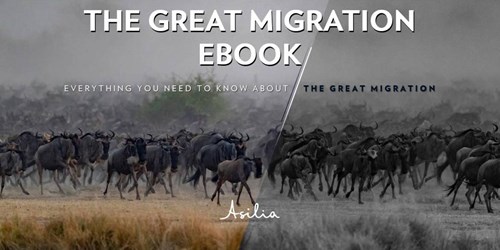
How the Great Migration moves throughout the year
Whether the wildebeest are dropping calves or attempting to cross rivers while avoiding predators, the migration is constantly on the move throughout the year. Read on to learn where the Great Migration tends to be during different times of year, or click on a month below to jump that season of the migration: January, February and March | April and May | June and July | August, September and October | November and December
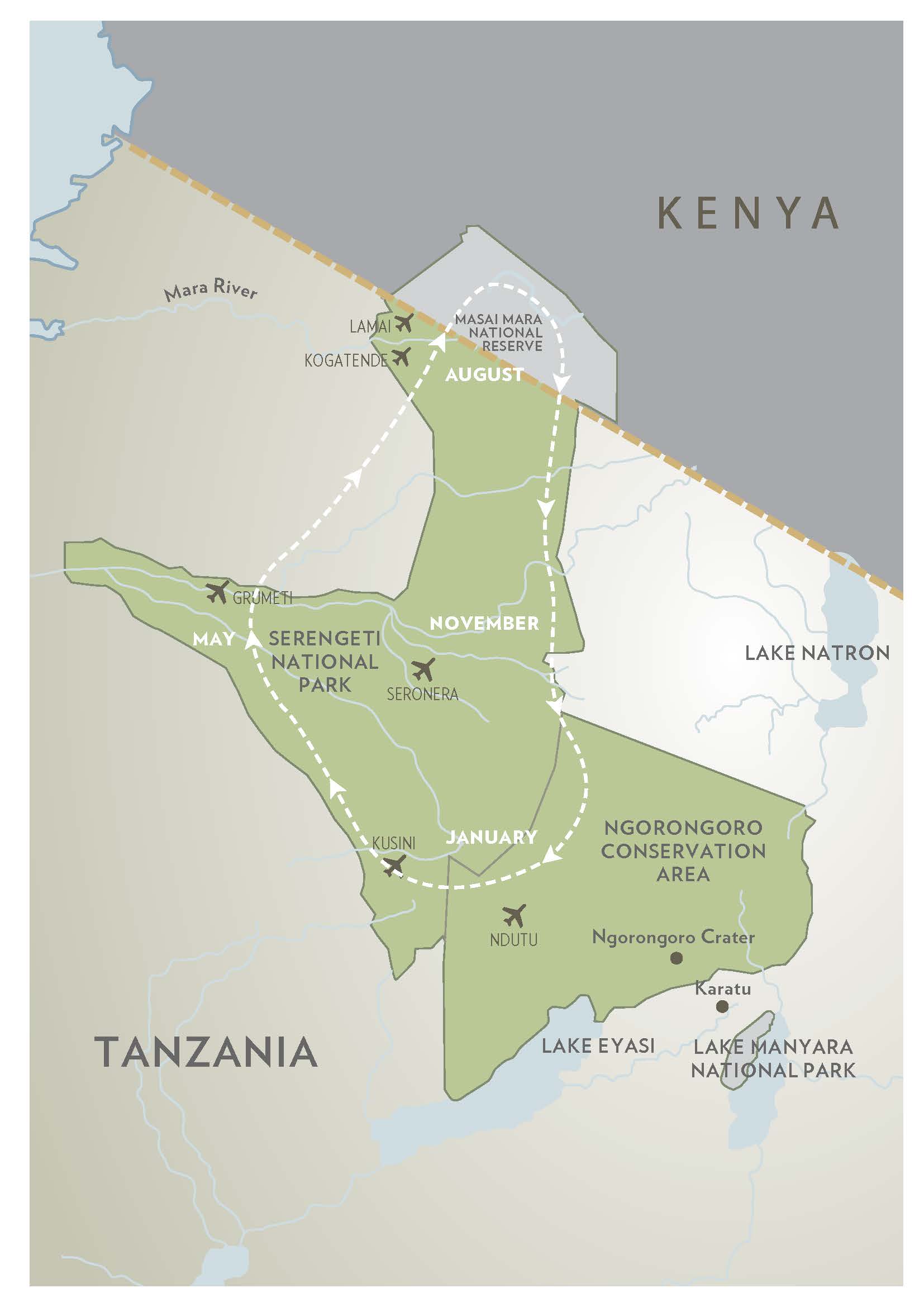
The Great Migration in January, February and March
Around January each year, the migration will be finishing a southward trek, moving along the eastern edge of the Serengeti and into the Ngorongoro Conservation Area . Here the plains are rich in nutritious grass, providing the herds with the best conditions for raising their newborn calves.
Although there is no real beginning or end to this migratory circuit — other than birth and death — it seems reasonable to call the wildebeests’ birthing season the start of the migration. Around late January or February , the herds occupy the short-grass plains that spread over the lower northern slopes of the Ngorongoro Crater highlands and around Olduvai Gorge. Some 400,000 calves are born here within a period of two to three weeks, or nearly 8,000 new calves every day.
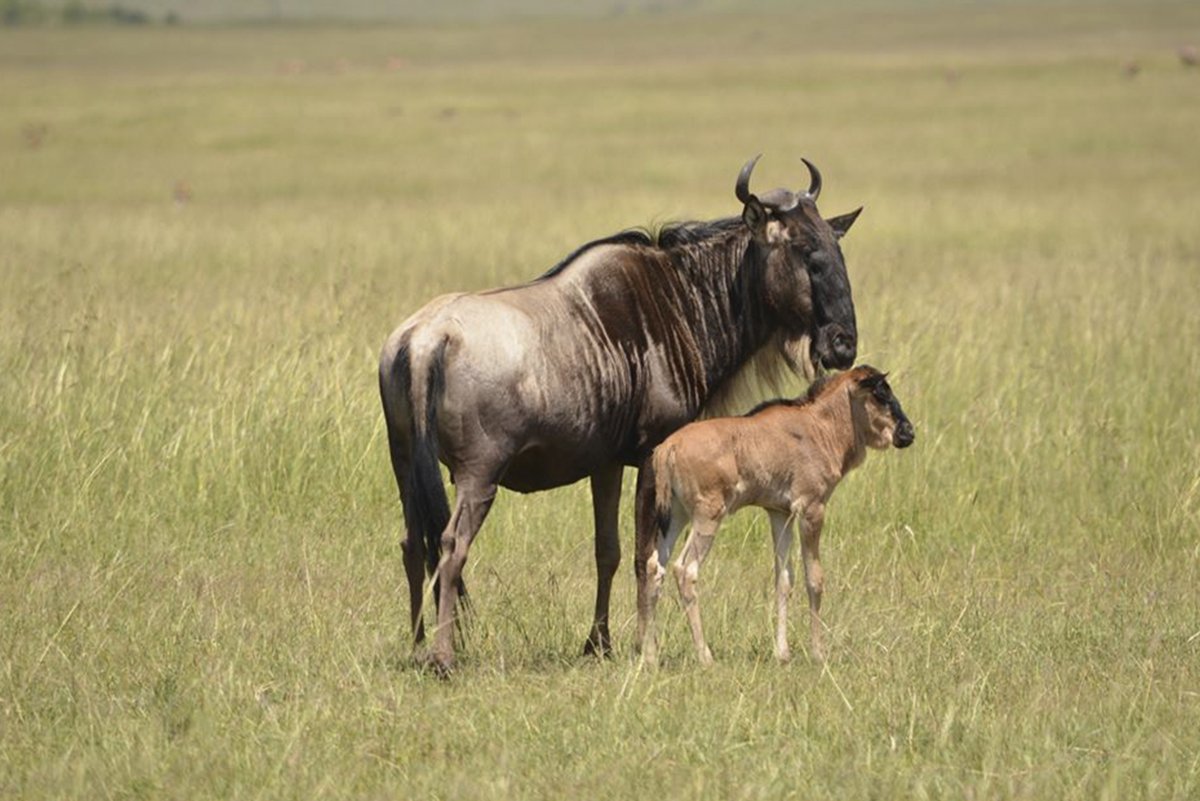
The abundance of vulnerable young calves means the surrounding predators also spring into action, hunting with ease due to the sheer numbers of wildebeest. Those interested in witnessing calving and the drama of big cats on the hunt should look to Asilia's migration camps in the southern Serengeti which provide direct access: Olakira , Kimondo and Ubuntu .
The Great Migration in April and May
After bearing their young in February and March, around April the wildebeest herds begin to drift northwest toward the fresher grass of the central Serengeti, drawing with them thousands of zebra and smaller groups of antelope. By May, columns of wildebeest stretch for several kilometres as the animals start to congregate by the Moru Kopjes, close to Dunia Camp , one of the few camps in the Serengeti that offers migration viewing at this time of year. Mating season begins toward the end of May and male wildebeest battle head-to-head. Throughout 'the rut,' the journey continues at leisure with the wildebeest, zebra and gazelle grazing as they go along.
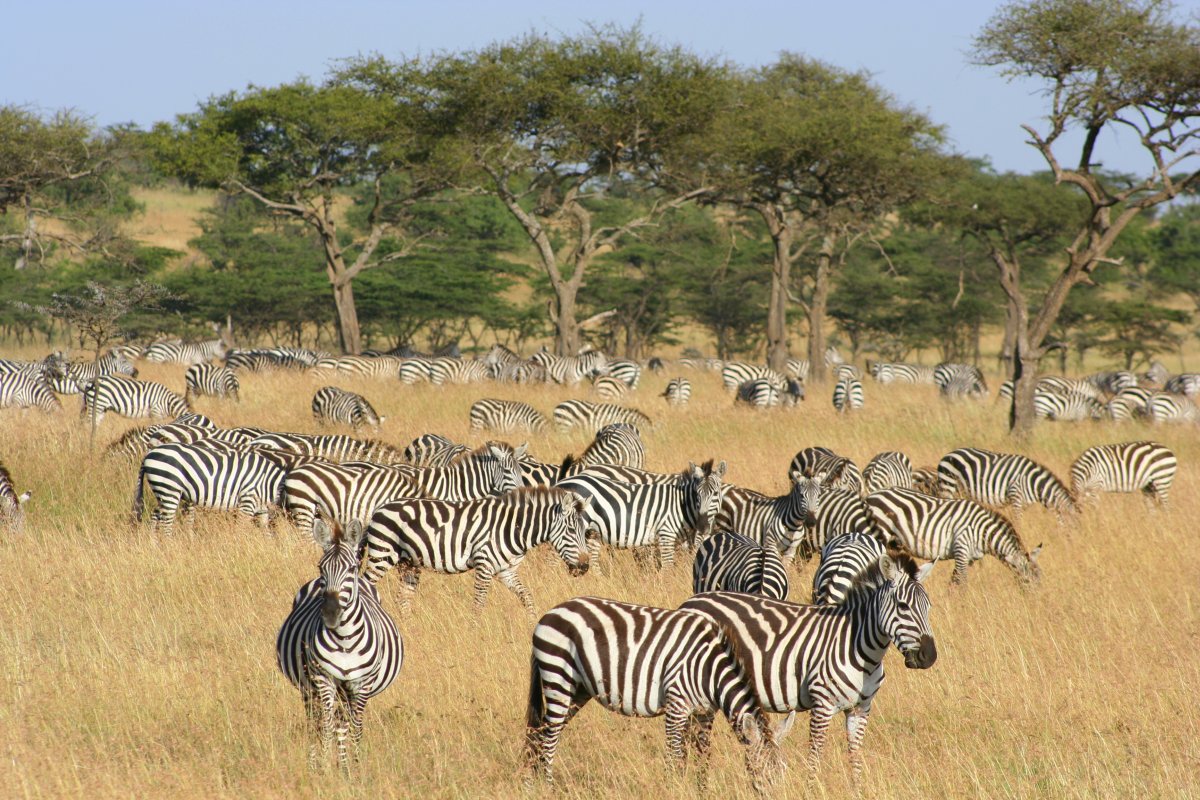
Gradually, the movement gathers momentum and the wildebeest start to mass in the Serengeti’s Western Corridor. At this time of year , Ubuntu Migration Camp will have relocated to follow the migration and provide access to watch the wildebeest cross the Grumeti River. The herds form in huge numbers along the pools and channels of the river, which they have to cross in order to continue on their journey. This may not be as spectacular as the famous Mara crossings, but there are still enough wildebeest to provide the Grumeti crocs with a veritable feast. It is worth noting that May is low season at Ubuntu. Safaris at this time offer great value since there are relatively low numbers of tourists in the Serengeti, yet the wildlife viewings remain excellent.
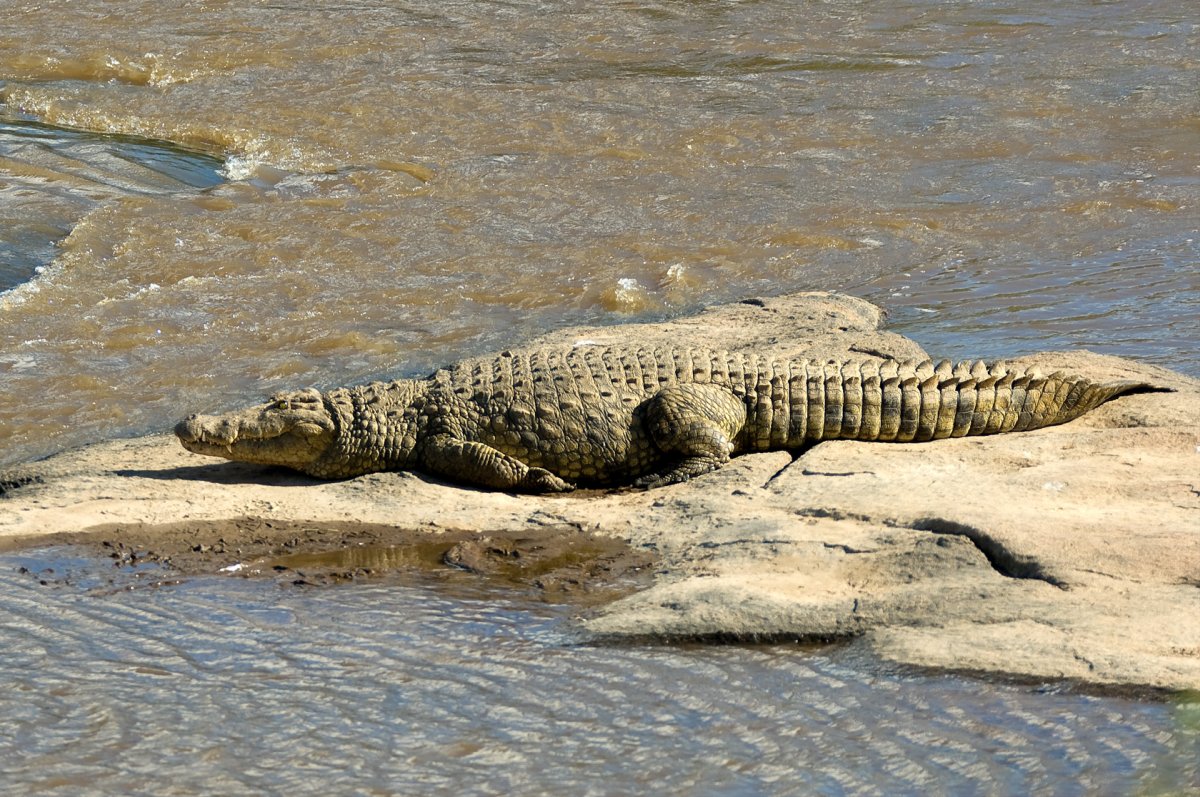
The Great Migration in June and July
During June, the dry season starts with large concentrations of wildebeest in the Western Serengeti and on the southern banks of the Grumeti River. Each migrating animal must face the challenge of crossing the crocodile-infested river — the first of many daunting and tense river encounters.
As June moves into July, the hundreds of thousands of wildebeest and zebra continue to head north along the western edge of the park toward an even riskier barrier: the Mara River in the north of the Serengeti. These river crossings are arguably one of the most exciting wildlife events on Earth. They usually begin at the onset of high season in July, but timing all depends on nature.
The herds will typically be found in the Northern Serengeti in the month of July, where access is provided by Asilia's mobile migration camps as well as Sayari Camp (for those looking to indulge just a little bit more). Later in July, those animals that have successfully made it across the Mara River will also be found in the Masai Mara , where guests of Rekero Camp can watch river crossings right from the main deck of the camp on their Kenyan safari . At this time, daily river crossings can be seen at the Mara and Talek rivers, both often central to incredible scenes.
The Great Migration in August, September and October
By August, the herds have faced the challenge of crossing the Mara River and are spread throughout the Masai Mara's northern region, with many remaining in the northern Serengeti. In years when the river is in full flow, the panic and confusion at the crossings — combined with waiting predators and surging currents — can cause massive loss of life. But, even in years of relatively gently flowing water, the crocs take their toll, not to mention the lions and other large predators that patrol the banks, ready to ambush any wildebeest that make it to the other side. There is no single crossing: at some spots, there are just a few individuals, while others see a mass of animals moving without break for hours.
By September to October, the main chaos has ended and the migrating columns have gradually moved eastward. However, they wildebeest will face the heavy waters of the Mara River once more as they prepare to cross once again for their return journey southward.
The Great Migration in November and December
After the East African short rains in late October and early November, the wildebeest move down from Kenya and into the eastern limits of the Serengeti past Namiri Plains , an area known for outstanding cheetah sightings. By December, they are spread throughout the eastern and southern reaches.
In the early months of the new year, the grasses in the deep south of the Serengeti are lush with rain. This draws the herds of wildebeest and hundreds of thousands of zebra and other plains animals. The cycle continues as the calving season starts once again.
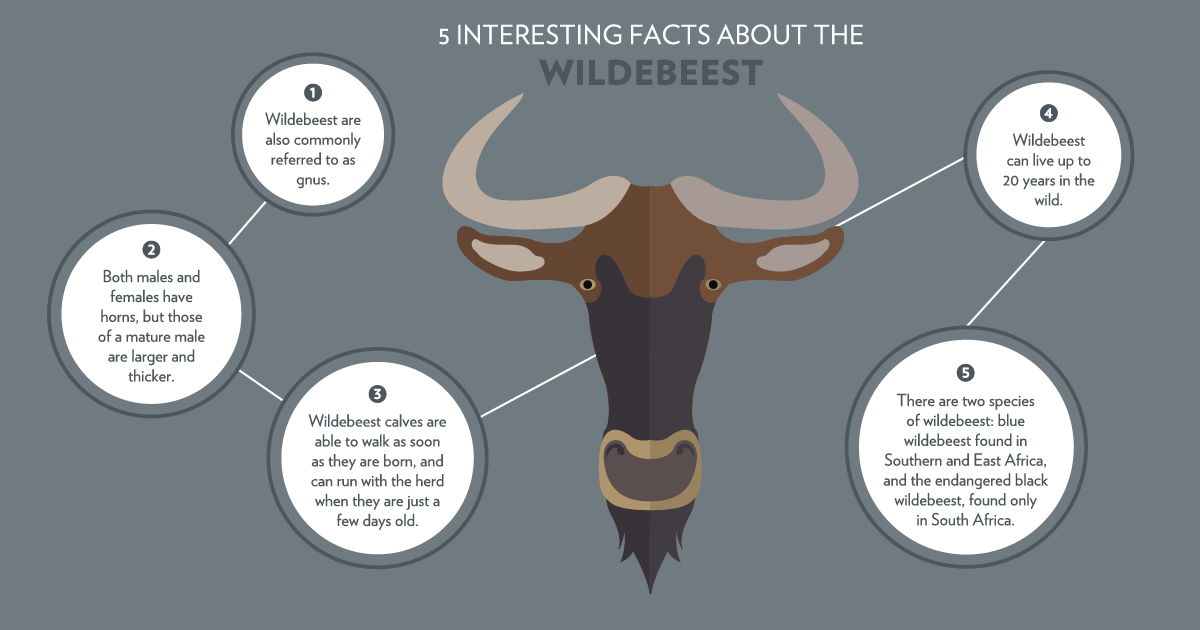
Ready to plan a Great Migration safari?
Enquire now, featured great migration itineraries.
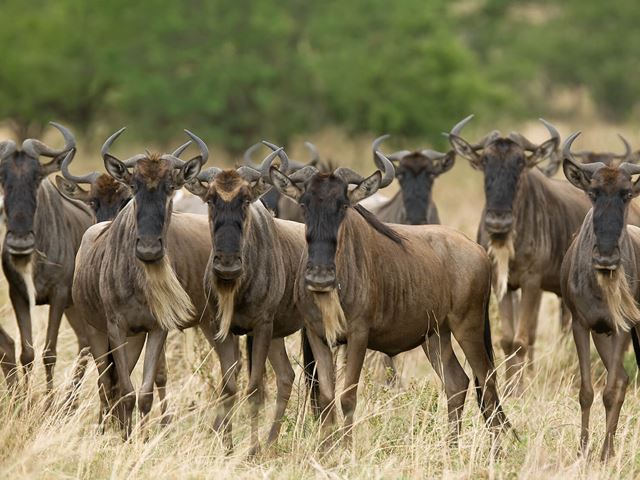
Great Migration Adventure
US$4,336 Per person sharing
Asilia’s Great Migration Camps
With our camps positioned all along the migration route, our guests have a high chance of seeing the migration at any time of year. Three of these are mobile camps that move around the Serengeti throughout the year to ensure guests are in the best possible position to witness the Great Migration in all its glory. These camps are Ubuntu Migration Camp, Kimondo Migration Camp and Olakira Migration Camp.
Also situated in the Serengeti are our permanent safari camps Namiri Plains, Dunia and Sayari.
When the migration is in Kenya, guests can experience this spectacle at Rekero in the Masai Mara, or at Naboisho or Encounter Mara, both of which are nearby in the Mara-Naboisho Conservancy.
Find out more here about the best safari camps to stay at to see the Great Migration .
More about the Great Wildebeest Migration

The Science Behind Africa’s Great Migration
Every year, millions of hooves drum against Africa’s plains, raising dust and devouring kilometres as wildebeest, zebra and gazelles trek across the Serengeti and the Masai Mara. Called the Great Migr…

Guest Gallery: An Intimate Safari In The Mara

Our Mobile Migration Camps : How Does It All Happen?
By Akil Halai – Tanzania Field Ops Coordinator The massive moment we are all anxious for that happens once or twice every year is when we begin moving our mobile camps. Asilia has three truly mobile c…

The Great Migration – river crossings
When most people think of the ‘Great Migration’, they think of the iconic wildebeest river crossings. The Great Migration is in fact a year-long cyclical event, with plenty of action to be found all y…

The Great Migration: a guide's perspective

Namiri Plains and the Great Migration
The post Namiri Plains and the Great Migration appeared first on Asilia Africa .

Where to see The Great Migration
By Britta Foulis The Great Wildebeest Migration is an annual event which covers a circular route of over 1 000 km. This journey stretches all the way from the northernmost reaches of the Masai Mara in…
Frequently asked questions about the Great Migration
What is the great wildebeest migration.
The Great Wildebeest Migration is the largest animal migration in the world. Every year, more than 2 million animals (wildebeest, zebra, and gazelle) migrate in a clockwise direction across the ecosystems of the Serengeti ( Tanzania ) and the Masai Mara ( Kenya ). On the way, they have to cross crocodile-infested rivers, are hunted by predators, and face natural disasters such as droughts and flooding in a daily struggle for survival.
Asilia Africa operates a number of camps specifically along the route of the migration to offer you a front-row seat to all the migration action. For example, Sayari Camp is located close to many of the Mara River crossing points in the Northern Serengeti. We have three mobile camps in the Serengeti which move to two or three locations in a year to ensure proximity to the action of the migration, while other camps are in a fixed location and offer additional amenities such as swimming pools.
What is the best time to see the Great Wildebeest Migration?
The Great Migration can be enjoyed year round. The first few months of the year offer exceptional predator encounters in Tanzania's Serengeti as this is the calving season for the wildebeest and newborns make for easier targets. By July, the herds are heading north into the central Serengeti where the wildebeest make their first river crossing, and take their chances against the waiting crocodiles. In August, the herds cross over into Kenya’s Masai Mara and towards the end of the year the herds move southwards back into the Serengeti where the animals brace themselves for the next calving season and predator attacks.
You can read more here about what to expect from the migration each month as well as which of our camps are best positioned to enjoy this spectacle at those times of year.
Do wildebeest migrate?
Throughout every year in East Africa, wildebeest along with zebra, gazelle and other animals, migrate in spectacular herds comprising millions of animals altogether across Kenya and Tanzania. This is known as the Great Migration. Read more here for the best safari camps to stay at during a Great Migration vacation .
- Camps & Lodges
- Destinations arrow_right
- Special Offers
- Partner Properties
- Positive Impact
- Join our newsletter
- All Asilia Offer: Free Inter-Camp Travel
- Enquire Now arrow_right
- Asilia giving
- Popular Destinations

As featured in


Wildebeest Migration in Masai Mara
The Great Migration as it is known is the movement of a million plus wildebeest from Serengeti in Tanzania northwards into the adjoining Masai Mara Reserve in Kenya. It is one of the world's most spectacular and thrilling display of wildlife behaviour. The migration takes place every year with the animals primal instincts guiding them towards greener pastures following the climatic rain fall patterns over the Serengeti-Maasai Mara eco system. For the 2021 and 2022 seasons we recommend planning your travel for mid July as this is when the migration typically starts proper with the larger herds of wildebeest starting the move into Masai Mara. The migration takes place till end of August, before declining into mid September. Although numbers vary every year, past migrations have seen upto 1.5 million wildebeest, close to a million Zebra and large numbers of others animals undertake the long trek that lasts many weeks. Their journey is especially frought with danger as they cross the crocodile infested Mara and Talek rivers along the way, during which many cannot escape the giant nile crocodiles lying in wait for their prey.
A Guide to the Wildebeest Migration
Travelers planning a safari to Kenya often have many questions related to the migration and we are listing the most common below for the sake of brevity. What time of the Year is the Wildebeest Migration ? Though the migration into Masai Mara typically starts in July and ends late September, the exact dates around this period are not predictable until the first large wildebeest herds actually gather at the northern edge of Serengeti as they near the Mara. These initial herds are sometimes known to gather at a spot for days on end without crossing over to the Mara, so when exactly the final leg of the movement starts is difficult to predict. So what is the best time to visit Masai Mara to see the Migration ? Based on decades of experience, we would choose mid July to late August as the best time to see the migration, keeping in mind it is a gradual event that takes places over several weeks at different locations along the Serengeti Masai Mara border. If we were to narrow it down further to what month is the best to see the migration we would probably pick August. Where do the wildebeest migrate to and from ? The movement of the wildebeest is from Serengeti into Masai Mara and is dictated by factos such as the climate, pasture and mating and calving seasons. Keep in mind the wildebeest are migrating through the year in a generally clockwise direction covering vast areas reaching into Southern, Central and Western Serengeti before the year long trek brings them to Masai Mara around July to August. Their journey back to Serengeti happens around late October though this is less spectacular and more like a slow dispersal. How do you see the Wildebeest Migration ? You can see the migration during a safari gamedrive in the Masai Mara Game reserve which is conducted in specialized vehicles driver by experienced Driver-Guides. As there are several core points where the wildebeest cross the rivers, it may be neccesary to access and station oneself at these points during a day-long outing in the reserve as some of the lodges and camps can be upto an hour's drive from the ideal vantage points. Most tourists who come specially to see the migration consider seeing the river crossings a highlight of their tour and therefore want to spend enough time at these crossing points, which by the way tend to vary slightly every year while staying within a generally simialar sub locality of the reserve.
Month by Month Wildebeest Migration
December to april.
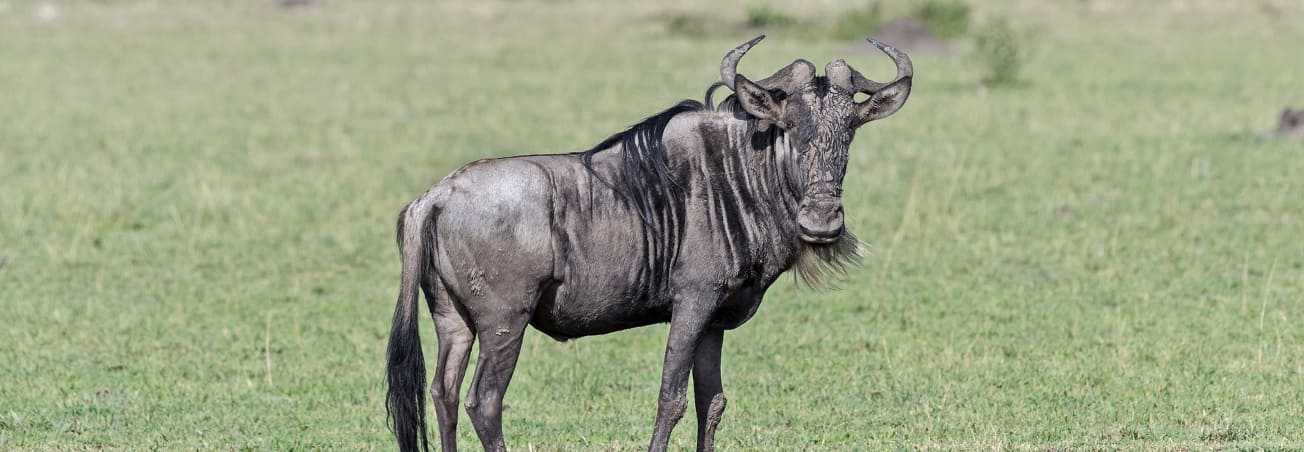
May to June
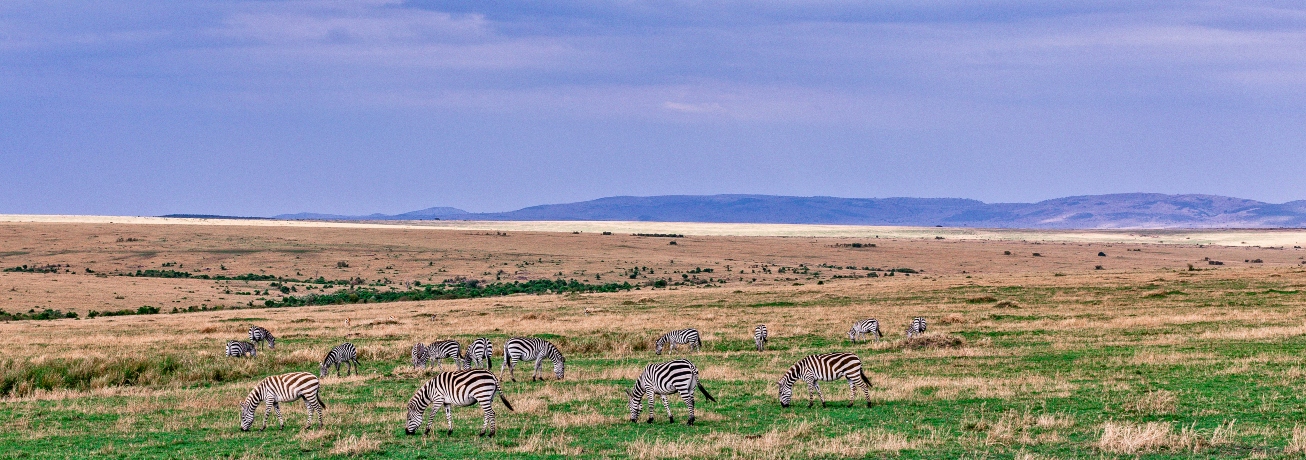
July to September
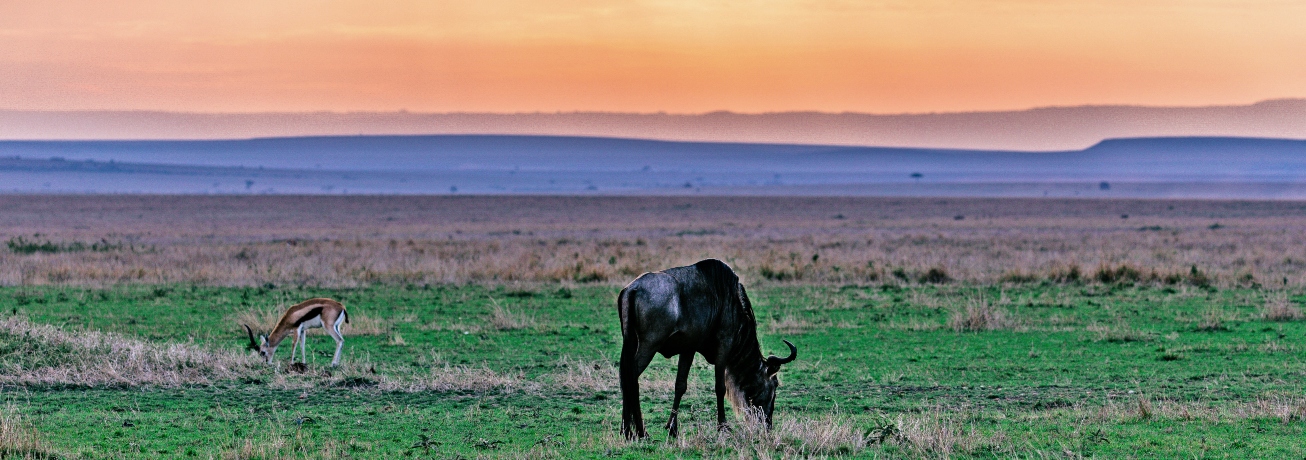
October to November
The wildebeest herds are migrating again with more accord: all are heading south, through western Loliondo and the Serengeti National Park's Lobo area, returning to the green shoots. The herds can now be seen in Kogatende and Lamai (Northern Serengeti). In a ‘normal year’ the short rains have begun in November. The herds are now in the Serengeti, stationed in the Lobo, Mbuze Mawe and Seronera Valley areas where water is abundant. Fresh grazing sees the wildebeest clustered in the north-eastern Serengeti (around Lobo in particular) as well as the southern Serengeti. Calving begins again, the predators move in again, and the cycle of life begins all over again.
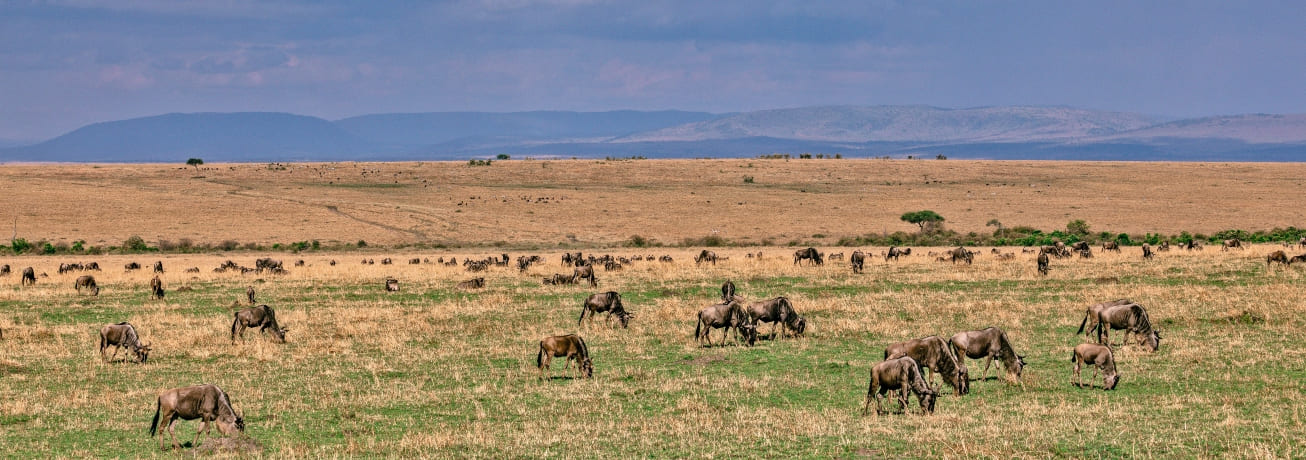

Wildebeest Migration Kenya
Wildebeest migration kenya (masai mara) when, where & tours.
The Great Wildebeest Migration Kenya (Masai Mara) Best Time, Safaris, Best Places to stay, Best Wildebeest Migration Safari Packages. Millions of wildebeest travel from Tanzania’s Serengeti to Kenya’s Masai Mara in what is known as “The Great Migration.” It’s one of the most exhilarating and amazing nature shows ever seen. The animals’ natural inclinations lead them each year to the Serengeti and the Maasai Mara , where they can find better grazing and rainfall. During the seasons, the best time to see the migration is around the middle of July, when the larger herds of wildebeest begin to move into Masai Mara. The migration peaks towards the end of August and begins to taper off by the middle of September.
In the past, up to 1.5 million wildebeest , nearly a million zebra, and a great number of other animals have made the arduous journey, which lasts for many weeks. They must travel over the crocodile-infested Mara and Talek rivers, where many drown trying to avoid the huge nile crocodiles waiting in ambush. For the purpose of brevity, we’ve compiled a list of the most often asked questions (and answers) by travelers about the migration while arranging a safari in Kenya .
The Great Wildebeest Migration Kenya in Kenya
What time of the year is the wildebeest migration.
The migration into the Masai Mara normally commences in July and concludes in late September. However, the precise dates within this timeframe are uncertain until the initial substantial wildebeest herds assemble at the northern boundary of the Serengeti , as they approach the Mara. The earliest herds have been observed to congregate at a particular location for extended periods of time without migrating to the Mara. Consequently, it is challenging to accurately anticipate the commencement of the last phase of their journey.
Where do the wildebeest migrate to and from
The migratory patterns of the wildebeest involve a journey from the Serengeti region to the Masai Mara , and are influenced by various factors including climatic conditions, availability of grazing pastures, as well as mating and calving seasons. It is important to note that the wildebeest engage in a migratory pattern throughout the year, predominantly following a clockwise route. This migration spans extensive territories, encompassing the Southern, Central, and Western regions of the Serengeti . Eventually, after a year-long journey, the wildebeest arrive in the Masai Mara region, typically around the months of July and August. The return migration to the Serengeti often occurs in late October, characterized by a gradual dispersal rather than a grand spectacle.
How do you see the Wildebeest Migration
The migration phenomenon can be observed during a safari game drive in the Masai Mara Game Reserve , facilitated by specialist vehicles operated by expert Driver-Guides. Given that there are multiple key locations where the wildebeest traverse the rivers, it can be imperative to gain entry and position oneself at these specific places throughout a full-day excursion within the reserve, as certain lodges and campsites can be situated up to an hour’s drive away from the optimal observation areas. The majority of tourists who specifically visit to witness the migration regard observing the river crossings as a notable aspect of their tour. Consequently, they desire to allocate sufficient time at these crossing points, which, it is worth noting, exhibit slight variations on an annual basis while remaining within a generally similar sub-locality of the reserve.
The Great Wildebeest Migration in Kenya Safari Packages that might interest you
Not sure where to start? Our best-selling Wildebeest Migration in Kenya safari packages are here to get you going
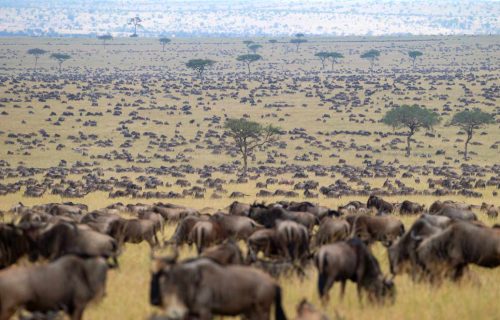
Amboseli, Lewa And Masai Mara Days: 13 | Nights: 12 13 Days Amboseli Lewa and Masai Mara safari. Welcome to Kenya, the country that gave the world wildlife safaris. Kenya is a distinctive location that provides visitors with the ideal fusion of vivid culture, and exhilarating adventure.
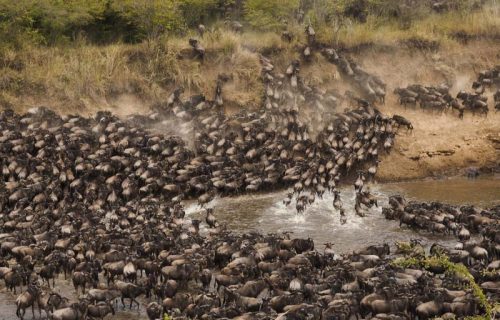
Great Wildebeest Migration Safari Days 9 | Nights: 8 This immersive 9 Days Great Wildebeest Migration Safari in Tanzania will take you to four of its most scenic & biodiverse regions – Arusha, Tarangire National Park, Ngorongoro, & Serengeti National Park.
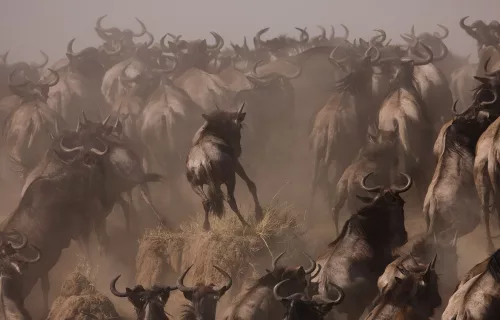
A Luxury Safari in Kenya Days: 8 | Nights: 7 This 8 Days Luxury safari in Kenya invites you to see the Masai Mara and Lake Nakuru, two safari hotspots, and see landscapes alive with activity, from massive herds of wildebeest across the Mara to thousands of flamingos.
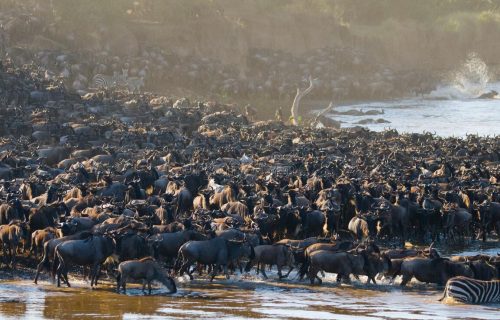
Kenya And Tanzania Safari Days: 12 | Nights: 11 12 Days Kenya and Tanzania Safari encompasses the best of Kenya and Tanzania, as well as the most likely route for witnessing the Immense Migration of millions of wildebeest and zebra over East Africa’s great plains.
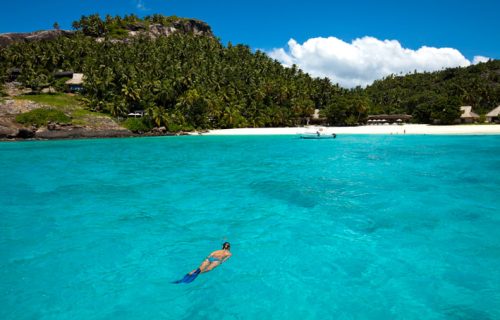
Kenya Safari And Seychelles Days: 13 | Nights: 12 Experience the rich wildlife of Kenya on this Kenya Safari and Seychelles Honeymoon and spend carefree days on the beaches of Mahe and Praslin Island in Seychelles. Huge herds of elephants and buffalo, rhinos, lions, leopards.
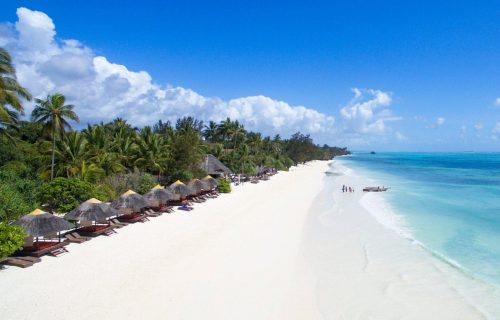
A Safari in Kenya, Tanzania & Zanzibar Days: 14 | Nights: 13 14 Days Kenya, Tanzania & Zanzibar Safari tour to game reserves and beaches in Kenya and Tanzania could be just what you’re looking for. Spend a day with giraffes at Nairobi’s lovely Giraffe Manor and try your luck finding.
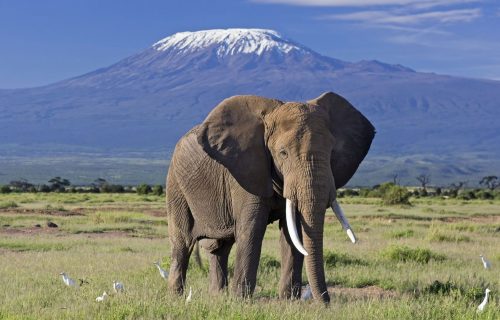
A Luxury Safari in Kenya Days: 6 | Nights: 5 “6 Days Safari in Kenya” would undoubtedly be on the bucket list of the daring. The term translates as “going on a voyage” in Swahili, the language of East Africa. This meant traveling upcountry in the period of Hemingway.

A Classic Kenya Honeymoon Safari Days: 6 | Nights: 5 This 6 Days Kenya Safari will take you on a boat ride in Lake Baringo, as well as a 3-4 hour hike to the south end of Lake Bogoria to see the flamingos and hot springs. We also head to Lake Nakuru National Park.

A Premium Kenya Safari Days: 9 | Nights: 8 This 9 Days Kenya Safari will take you on a boat ride in Lake Baringo, as well as a 3-4 hour hike to the south end of Lake Bogoria to see the flamingos and hot springs. We also head to Lake Nakuru National Park to observe rhinos.
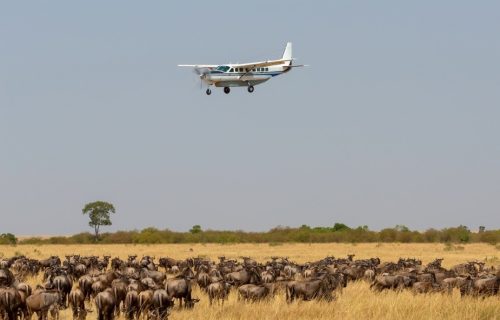
Explore Masai Mara National Reserve Days: 4 | Nights: 3 The Maasai Mara National Reserve is Kenya‘s most famous game reserve. 4 Days Masai Mara Lodge Safari From Nairobi provides the opportunity to witness “the big five” as well as numerous other kinds of games.
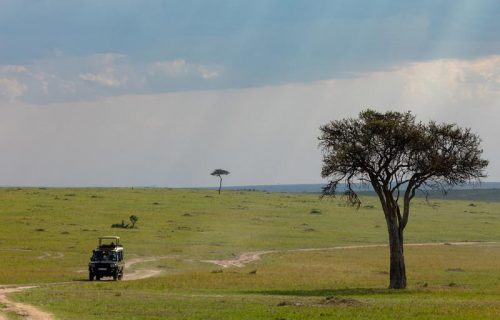
A Kenya Family Safari Days: 11 | Nights: 10 The 11 Days Kenya Safari is an Exclusive Family Package. Families may help with elephant conservation while also learning about orphans. Explore the forest on horseback and fly over the skies in an open cockpit aircraft.
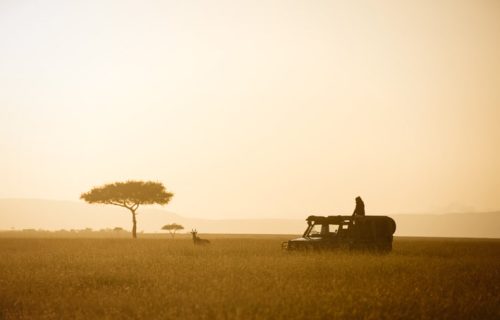
Kenya And Madagascar Safari Days: 13 | Nights: 12 Kenya and Madagascar Safari Start on the grasslands of the Masai Mara before flying across to the island of Madagascar for some lemur tracking through the forests and finally ending on the private reserve and beach of Anjajavy.
Best Time to see Wildebeest Migration in Kenya Month by Month
There is a common misconception among individuals that the Great Migration occurs solely on an annual basis. However, it is important to note that this migration is a continuous phenomena that transpires throughout the whole year. Consequently, this ongoing event presents diverse and captivating wildlife encounters that vary depending on the specific time of year.
The River crossing event is highly sought after throughout the migration and typically aligns with the peak safari season. Consequently, it is commonly assumed that this is the exclusive period when the wildebeest are in motion or observable. The migration crossing typically takes place at Mara River during the late July to August period, extending into parts of September. Similarly, during their return journey south, the crossing is observed from the last two weeks of October through early November.
Therefore, it is advisable to observe and monitor the yearly wildebeest migration in the Masai Mara during specific periods. The following is a broad overview of the approximate locations of the herds throughout the year, taking into consideration the unpredictable nature of their movements, which are influenced by rainfall patterns that can vary in terms of timing and intensity.
December To April
The location of the herds, situated between the Ndutu plains and Ngorongoro plains , south of Serengeti National Park, is contingent upon the precipitation patterns. Therefore, the optimal location to reside during this four-month period would be the southernmost region of the Serengeti. During the month of February, it is the period when wildebeests engage in calving activities, presenting a significant opportunity for observing the process of wildebeest birth. The herds exhibit rapid movement as they seek out meadows that offer optimal conditions to sustain their offspring. The likelihood of predator interaction is high, as lions and leopards are migrating to this area to hunt and feed upon the juvenile and susceptible calves. By the conclusion of March or the commencement of April, the herds exhibit a gradual and foreseeable migration pattern as they initiate their movement towards the north. A considerable number of these herds have already departed and are currently situated inside the middle and, in some cases, even the western regions of the Serengeti.
May To June
During this particular season, the migratory herds exhibit a consistent pattern of movement towards the northern regions, driven by their need to access abundant sources of nourishment and water. The phenomenon of migration typically involves the movement of large groups of wildebeest, spanning up to 40 kilometers or 25 miles in length. This spectacle is observable as the wildebeest migrate towards the central and western regions of the Serengeti. These migratory herds, consisting of hundreds of thousands of wildebeest, are often accompanied by zebras, as well as a few Thomson’s and Grant’s gazelles. The conclusion of the rainy season in June typically corresponds with the customary occurrence of the Grumeti River crossing , which is primarily contingent upon the water level of the Grumeti River . It is worth noting that this period presents an opportunity to observe Nile Crocodiles in the vicinity. The current crossing under consideration does not possess the same level of grandeur as the crossings observed at the Mara River.
July To September
The occurrence under discussion pertains to the commencement of a significant event, namely the initiation of a substantial Mara River crossing . The migratory animal populations have successfully arrived at the western Serengeti and Grumeti Reserves, where they are observed engaging in close examination of the rivers they must traverse, characterized by their brown-colored waters.
During the month of August, the group of survivors proceeds in a northward direction, traversing the northern region of the Serengeti and afterwards into Kenya’s Masai Mara National Reserve . The herd undergoes a division into smaller factions, with approximately fifty percent of the animals remaining in the northern region of the Serengeti. The remaining wildebeest proceed to traverse the Mara River, while the majority of the herds relocate to the Greater Masai Mara area, where they consume the abundant resources of lush green grass. Subsequently, they proceed northwards towards the private conservancies of Mara North and Olare Orok.Observing the frenzied assemblage of wildebeests traversing the Mara River often constitutes a highly favored spectacle during the migratory process.
October To November
The wildebeest herds are currently engaged in a migratory pattern characterized by enhanced coordination, as they collectively move in the southern direction. This migration route specifically involves traversing the western Loliondo region and the Lobo area within the Serengeti National Park , with the primary objective of accessing the nourishing green vegetation. The presence of the herds is currently observable in the regions of Kogatende and Lamai, located in the northern part of the Serengeti.
In a typical year, the onset of the short rains typically occurs in November. The herds have currently migrated to the Serengeti region, namely occupying the Lobo, Mbuze Mawe, and Seronera Valley areas, which are characterized by ample water resources. The wildebeest have a concentrated presence in the north-eastern Serengeti, specifically in the vicinity of Lobo, as well as in the southern region of the Serengeti, where fresh grass is available. The process of calving recommences, prompting the predators to reestablish their presence, thereby initiating the recurring cycle of life.
Destinations for The Great Wildebeest Migration Safari in Africa
A selection of our favourite places for The Great Migration safari in Africa
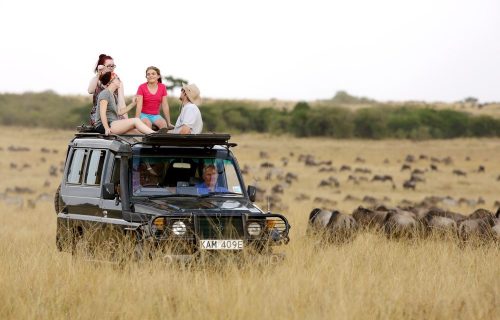
Our Wildebeest Migration safari tips
As you can see, organizing a Great Wildebeest Migration in Kenya is not simple. There are so many things to take into account, and deciding when and where to go can either make you giddy with anticipation or leave you feeling bitterly let down when you miss all the action.
Since the Wildebeest Migration is a once-in-a-lifetime safari adventure, it is crucial to only book with the top safari trip operator . And we can confidently state that this is us because we were named Africa’s Leading Safari Company !
We’ve traveled to East Africa a great deal. The Great Wildebeest Migration has been observed during various seasons of the year. We are able to call the lodge’s owners, managers, and other employees by name. We’ve slept in the beds, taken game drives, and flown in a hot air balloon over the plains. Even better, we were able to observe wildlife without ever leaving the comfort of our beds because we had such a great front-row seat.
Best time to visit Masai Mara to see the Migration
Based on a substantial body of experience spanning many decades, our recommendation would be to visit the Serengeti Masai Mara border during the period from mid July to late August. It is important to note that the migration is a protracted phenomenon that unfolds gradually over several weeks, occurring at various sites along the border. If we were to further refine our analysis to determine the optimal month for observing the migration, August would likely be our preferred choice.
Free tour planning advice from wildebeest migration experts
To make sure your Great Migration experience is nothing short of extraordinary, we’d be delighted to share our insider knowledge, tips, and recommendations with you. We can also suggest the ideal tour because we are aware of which locations go well together.
What are you still holding out for? Contact our travel specialists right away. They can’t wait to start organizing your ideal Great Wildebeest Migration safari!
- Kenya Safari Tours
The Great Wildebeest Migration
Your guide to the great wildebeest migration.
One of the most sought-after experiences for wildlife and nature enthusiasts, the Great Migration is the ever-moving circular migration of over a million animals across the Serengeti-Mara ecosystem. The constant movement of columns of wildebeest, joined by a host of companions, follow an age-old route in search of grazing and water. After calving in the southern part of Tanzania’s Serengeti near the Ngorongoro Conservation Area , the animals journey through the Serengeti up and around in a clockwise direction towards the Masai Mara in Kenya , before returning once again near the end of the year. Along the way, high drama is always present, as thousands of animals are taken by predators and thousands more are born, replenishing the numbers and sustaining the circle of life.
Below, learn more about what is the Great Migration; find a broad overview of how the migration moves at different times throughout the year; or read some frequently asked questions about the Great Migration.
Alternatively, use the menu tabs below for detailed information on when to travel (including a map of the annual migration), which areas and camps to stay at when on a Great Migration safari, or to view a photo and video gallery of the Great Migration.
- WHEN TO TRAVEL
- BEST PLACES TO STAY
- THE GREAT WILDEBEEST MIGRATION SAFARIS
The Great Migration is the largest herd movement of animals on the planet. In fact, with up to 1,000 animals per km², the great columns of wildebeest can be seen from space.
The numbers are astonishing: over 1.2 million wildebeest and 300,000 zebra along with topi and other gazelle move in a constant cycle through the Serengeti-Mara ecosystem in search of nutritious grass and water. Guided by survival instinct, each wildebeest will cover 800 to 1,000km on its individual journey along age-old migration routes. Hungry predators including lion, leopard, cheetah, hyena, wild dog and crocs make sure only the strongest survive in this natural spectacle also known as ‘the greatest show on Earth.’
The circuit takes the animals from the Ngorongoro Conservation Area (although not into the Crater itself) in the south of the Serengeti in Tanzania, up through the Serengeti and across into the Masai Mara in Kenya and back again. The journey is beset with danger: young calves are snatched by predators, the slow are brought down by prides of lion, brave beasts break legs on steep river slopes, crocodiles take their share of the stragglers, and the weak and exhausted drown.
The three groups of migrant grazers have different grass-eating habits: as one group eats the top of the tallest grass, the next group will eat away some of the medium-height grass, until finally it is almost completely eaten, and the herds move on. This means each group sticks to their own kind with only a small overlap in their distributions. The grasses of the plains have the highest protein content in the whole of the Serengeti, as well as being high in calcium.
It is unclear how the wildebeest know which way to go, but it is generally believed that their journey is dictated primarily by their response to the weather; they follow the rains and the growth of new grass. While there is no scientific proof of it, some experts believe that the animals react to lightning and thunderstorms in the distance. It has even been suggested that wildebeest can locate rain more than 50km away.
WHEN TO SEE THE GREAT WILDEBEEST MIGRATION
There is no single time of year to see the Great Migration since it is an eternal annual cycle from place to place, year in and year out. However, depending on either the aspect of the Great Migration you want to witness (such as river crossings), or the time of year that you prefer to travel, your safari can be tailored to give you the best chance of seeing what you desire. The Great Migration can be summarized in this way as having these four seasons.
Alternatively, you can learn more about when to travel via through this month-by-month breakdown of the Great Migration.
Whether the great herds are calving in the south or on the move north in search of greener pastures – and then back again – there is a huge variety of astounding scenes unfolding before you.
THE GREAT WILDEBEEST MIGRATION SEASONS
You can see the Great Migration at any time of year. It is possible to look at historic migration patterns to predict where the herds will be at a particular time, but ultimately these are wild animals and the annual rainfall they rely on to stimulate grass growth is becoming more unpredictable.
Learn more below about the different season of the Great Migration: January to March: calving season | April to mid-June: the trek north | Mid-June to November: river crossings | December: calving begins
WHERE TO STAY FOR A GREAT WILDEBEEST MIGRATION SAFARI
The backdrop of this dramatic spectacle is the Greater Serengeti-Mara Ecosystem – an area that covers both Kenya and Tanzania. The northernmost reaches of the great migration’s circuitous route crosses the Masai Mara in Kenya before heading southwards through the Serengeti in Tanzania, as far south as to border on the Ngorongoro Conservation Area.
No matter what time of year you prefer to travel or which region you wish to visit, our camps all along the migration route ensure you have front-row seats away from the crowds. We recommend combining two or more of our camps to maximise your chances of seeing the herds by staying in more than one location. Stay at our permanent camps in Kenya to see the Great Migration during July to November, or go on a migration safari in Tanzania from November to July where you have the option of choosing between permanent camps and our mobile migration camps.
Treat yourself to a once-in-a-lifetime Great Migration safari holiday.
Our itineraries start with five nights in Kenya, but are completely customizable to your preferred length of stay and travel needs. From mid-June to November, grab yourself front row seats to the drama and action of river crossing season, while also enjoying serene sunset moments in the vast open landscapes of Africa. On your Great Migration Kenya itinerary, you’ll begin at Ol Pejeta conservatory before visiting the iconic Masai Mara
Whether you’re ready to travel now or are considering a safari in the future, enquire with us and our friendly expert safari consultants will be happy to advise you, confirm availability and provide you with a quote.
HOW THE GREAT MIGRATION MOVES THROUGHOUT THE YEAR
JANUARY, FEBRUARY AND MARCH
April and may, june and july, august, september and october, november and december.
The Great Migration in January, February and March
Around January each year, the migration will be finishing a southward trek, moving along the eastern edge of the Serengeti and into the Ngorongoro Conservation Area. Here the plains are rich in nutritious grass, providing the herds with the best conditions for raising their newborn calves.
Although there is no real beginning or end to this migratory circuit — other than birth and death — it seems reasonable to call the wildebeests’ birthing season the start of the migration. Around late January or February, the herds occupy the short-grass plains that spread over the lower northern slopes of the Ngorongoro Crater highlands and around Olduvai Gorge. Some 400,000 calves are born here within a period of two to three weeks, or nearly 8,000 new calves every day.
The Great Migration in April and May
After bearing their young in February and March, around April the wildebeest herds begin to drift northwest toward the fresher grass of the central Serengeti, drawing with them thousands of zebra and smaller groups of antelope. By May, columns of wildebeest stretch for several kilometres as the animals start to congregate by the Moru Kopjes, close to Dunia Camp, one of the few camps in the Serengeti that offers migration viewing at this time of year. Mating season begins toward the end of May and male wildebeest battle head-to-head. Throughout ‘the rut,’ the journey continues at leisure with the wildebeest, zebra and gazelle grazing as they go along.
The Great Migration in June and July
During June, the dry season starts with large concentrations of wildebeest in the Western Serengeti and on the southern banks of the Grumeti River. Each migrating animal must face the challenge of crossing the crocodile-infested river — the first of many daunting and tense river encounters.
As June moves into July, the hundreds of thousands of wildebeest and zebra continue to head north along the western edge of the park toward an even riskier barrier: the Mara River in the north of the Serengeti. These river crossings are arguably one of the most exciting wildlife events on Earth. They usually begin at the onset of high season in July, but timing all depends on nature.
The herds will typically be found in the Northern Serengeti in the month of July, later in July, those animals that have successfully made it across the Mara River will also be found in the Masai Mara, where guests of Rekero Camp can watch river crossings right from the main deck of the camp on their Kenyan safari. At this time, daily river crossings can be seen at the Mara and Talek rivers, both often central to incredible scenes.
The Great Migration in August, September and October
By August, the herds have faced the challenge of crossing the Mara River and are spread throughout the Masai Mara’s northern region, with many remaining in the northern Serengeti. In years when the river is in full flow, the panic and confusion at the crossings — combined with waiting predators and surging currents — can cause massive loss of life. But, even in years of relatively gently flowing water, the crocs take their toll, not to mention the lions and other large predators that patrol the banks, ready to ambush any wildebeest that make it to the other side. There is no single crossing: at some spots, there are just a few individuals, while others see a mass of animals moving without break for hours.
By September to October, the main chaos has ended and the migrating columns have gradually moved eastward. However, they wildebeest will face the heavy waters of the Mara River once more as they prepare to cross once again for their return journey southward.
The Great Migration in November and December
After the East African short rains in late October and early November, the wildebeest move down from Kenya and into the eastern limits of the Serengeti past Namiri Plains, an area known for outstanding cheetah sightings. By December, they are spread throughout the eastern and southern reaches.
In the early months of the new year, the grasses in the deep south of the Serengeti are lush with rain. This draws the herds of wildebeest and hundreds of thousands of zebra and other plains animals. The cycle continues as the calving season starts once again.
Whether the wildebeest are dropping calves or attempting to cross rivers while avoiding predators, the migration is constantly on the move throughout the year. Read on to learn where the Great Migration tends to be during different times of year.
READY TO PLAN A GREAT WILDEBEEST MIGRATION SAFARI?
5 NIGHTS IN KENYA - TWO NIGHTS OL PEJETA BUSH CAMP AND THREE NIGHTS REKERO
LET’S PLAN YOUR TAILOR-MADE ITINERARY
Nova Afrika Kenya Safaris © 2024. All Rights Reserved.
This action is disabled.
Home » Kenya Information » Experience the Annual Great Wildebeest Migration
Experience the Annual Great Wildebeest Migration
Want to experience the annual great wildebeest migration?
When many people think of Africa, they think of Kenya and Tanzania because the two neighboring countries are among the top tourist destinations in the world.
Tanzania boasts 22 unique national parks and is home to Africa’s highest mountain, attracting over 50,000 tourists annually, while Kenya has 24 national parks and is also home to Mount Kenya, the second-highest mountain in Africa.
Both countries have diverse ecosystems supporting millions of wildlife.
The most famous national parks in both countries are the adjacent Masai Mara National Park in Kenya and Serengeti National Park in Tanzania.
Wildebeest Migration Map

About the Migration
Want to witness the annual great wildebeest migration experience in Africa?
Whether it is Serengeti migration safaris or Masai Mara migration safaris , we are willing to organize for you an unforgettable experience.
The wildebeest migration occurs in East Africa, across Serengeti National Park in Tanzania and Masai Mara National Reserve in Kenya.

This migration is also sometimes known as the Gnu migration.
Over 1.5 million animals participate in the migration in search of water and pasture, including mainly wildebeests accompanied by zebras, topis, Grant’s gazelles, impalas, Thompson’s gazelles, and elands.
Predators such as lions, crocodiles, hyenas, cheetahs, wild dogs, leopards, and many others keep track of the herds in order to hunt for prey.
This is the largest migration of animals in the world.
See some of our most popular wildebeest migration safari packages below:
- See Kenya migration safaris here
- See Tanzania migration safaris here
About Wildebeests
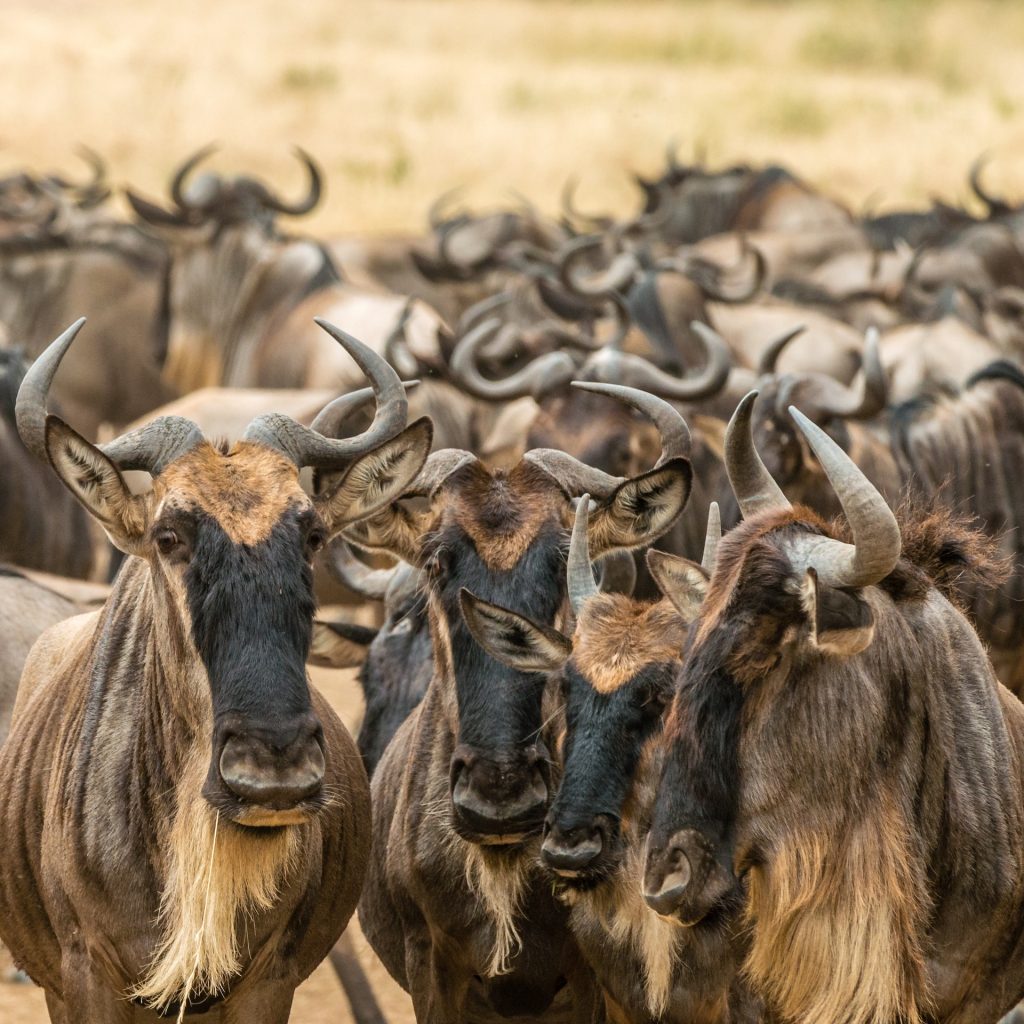
Wildebeests are also known as “gnu” and belong to the antelope family.
The name is derived from the Afrikaans language, meaning “wild beast.”
There are two species of wildebeests: the blue wildebeests and the black wildebeests.
Wildebeests can only be found in East and South Africa, with the largest population found in Kenya and Tanzania.
They commonly communicate through sight and smell but can also become vocal.
They are territorial animals, with herds owning about 1.5 square kilometers.
They are herbivorous animals, preferring mainly grass but can also eat leaves when grass isn’t available.
The gestation period of wildebeests is 8 to 8 and a half months, and the calves are born weighing between 20-22 kilograms.
The mother takes about 6 to 9 months to wean the calf, and the calves will be ready to mate between 16 to 76 months.
The average lifespan of a wildebeest is 20 years old. They can grow up to 2.4 meters in length and weigh 270 kilograms.
Migration in Kenya – Masai Mara

Though the migration takes place all year round at points, the migration in Kenya coincides with the peak tourism season.
The wildebeest migration in Kenya takes place at the famous Masai Mara National Reserve.
Larger herds of wildebeests start arriving at Masai Mara in mid-July until the end of August and then start declining in September.
There are specific and common points where experienced safari drivers will guide you through.
The very best time for seeing the migration or river crossings isn’t predictable, but given the experience and observation over the past years, mid-July to late August provides the highest chances of spectacular crossings.
In late October, the wildebeests start to disperse back slowly to Serengeti National Park in Tanzania.
Masai Mara National Park is also a potential birding area in Kenya, which boasts over 500 species of birds recorded.
Therefore, bird enthusiasts should not miss a day birding.
Some of the birds you will find include rare shoebill storks, grey crowned cranes, Madagascar squacco heron, rufous-bellied heron, saddle-billed stork, Goliath heron, Kori bustards, secretary bird, jaunty crowned plovers, great white egret, black-headed heron, fisher’s turaco, red-throated tit, martial eagle, tiny pygmy falcon, African finfoot, common ostrich, southern ground hornbill, Tabora cisticola, woolly-necked stork, yellow-throated sandgrouse, trilling cisticola, white-bellied go-away bird, Swahili sparrow, Abdim’s stork, grey penduline stork, Jackson’s widowbird, and purple grenadier, among others.
Migration in Tanzania – Serengeti
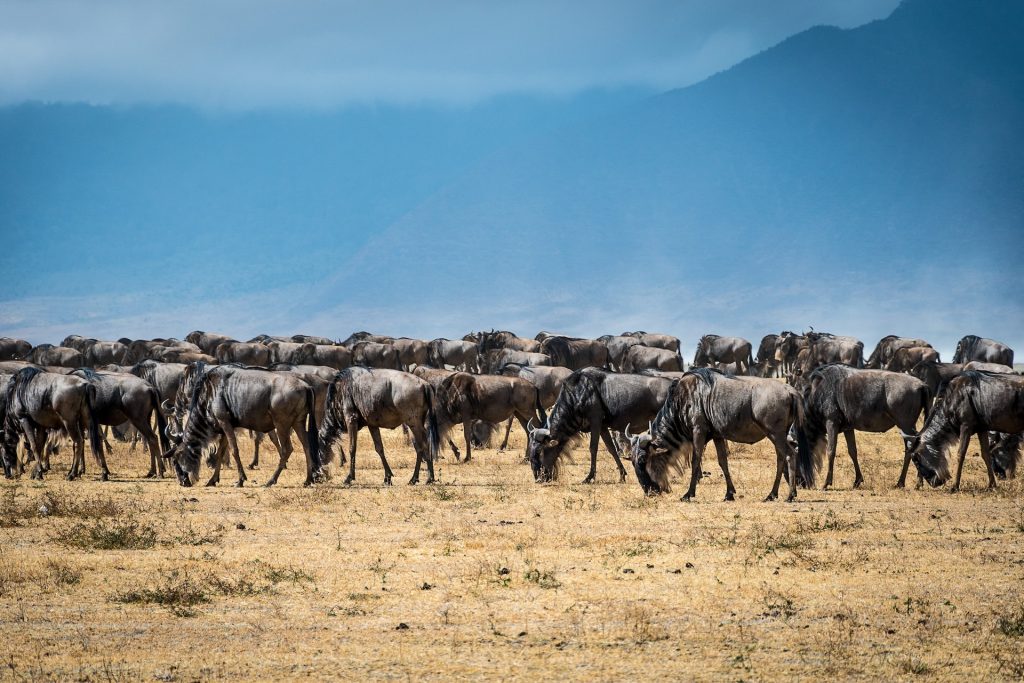
Before wildebeests cross to Masai Mara National Park, they graze around Ngorongoro and Ndutu plains south of Serengeti National Park between December to April.
In May to March, the herds start migrating to the northern part of the park in search of better pasture and water.
By the end of June, the herds will be crossing the Grumeti River, depending on the water levels, but you can have chances of seeing the crossing and also watch crocodiles preying on some animals.
From July to August happens the biggest show of the wildebeest migration as they cross from Serengeti National Park to the Mara River, though some herds remain in the northern parts of Serengeti.
From October to November, the herds start migrating back to Serengeti through Lobo area of the park.
January to March is normally the calving season.
Serengeti National Park is also a birder’s paradise with several species of birds.
Some of these examples are grey-breasted spurfowl, rufous-tailed weaver, Usambiro barbet, grey-crested helmet-shrike, red-capped robin chat, Masai ostrich, silverbird, Schallow’s turaco, southern ground hornbill, Tabora cisticola, woolly-necked stork, yellow-throated sandgrouse, black-necked gonolek, Fischer’s lovebird, grey-backed fiscal, Usambiro barbet, green-backed woodpecker, African pygmy goose, yellow-billed duck, mourning collared dove, helmeted guineafowl, African jacana, great white pelican, osprey, secretary bird, bearded vulture, wood sandpiper, bat hawk, hammerkop, common buzzard, African marsh harrier, masked weaver, and southern red bishop, among the rest.
Migration Routes

- Ngorongoro Conservation Area and Ndutu Plains. In January to March, the wildebeests are found in Ngorongoro Conservation Area and Ndutu Plains of Serengeti National Park in Tanzania.This is also a calving season where approximately 8,000 wildebeests are born while predators are ever-present to take advantage of the young calves.
- Central and Western Serengeti. The wildebeests move to the central and western regions of Serengeti in search of fresh pasture and water.
- Grumeti River. The herds move south of the Grumeti River in June, preparing to cross over.
- Mara River. Herds around the Grumeti Reserve are then ready for the most challenging part of the journey in mid-July, crossing the Mara River where thousands of crocodiles lie in wait for an opportunity to prey on wildebeests. This is the most dramatic part of the wildebeest migration.
- Masai Mara National Reserve. From July to August, millions of wildebeests have already crossed to Masai Mara National Reserve in Kenya. This is the best place for viewing the migration at this time of the year.
- Masai Mara National Reserve and Serengeti National Park. Not all wildebeests cross to Masai Mara Game Reserve; therefore, you will find some grazing at the northern plains of Serengeti while some are in Masai Mara National Reserve, and others are still crossing in September.
- Western Loliondo and Lobo Area. In the month of October, herds are concentrated at Masai Mara National Reserve and then start moving southwards through western Loliondo and Lobo areas to the fertile plains of Serengeti National Park.
- Serengeti National Park. The herds have just arrived back from a very long journey and graze across Serengeti fresh plain pastures and water in December, waiting for the calving season and for the circle to restart once more.
Best Time to See the Migration

The migration takes place throughout the year as their movements are dictated by weather.
This somehow makes their movements detectable because the two countries have almost the same seasons year in and year out.
In January, the herds are mainly concentrated in the southern part of Serengeti National Park in Tanzania in areas around Lake Ndutu.
Between February and March, thousands of wildebeest babies are born every single day.
This is quite interesting as you witness calves being born but can sometimes become heartbreaking when predators hunt the newly born calves immediately.
Around 600,000 calves are born during this time.
April to May is the beginning of the long rainy season, and the herds move to the northwestern direction around the Kopjes of Simba and Moru.
At the end of May, they move a bit faster as the recently born calves are strong; hence, herds subdivide into thousands and hundreds of columns.
In June, the herds are now in central Serengeti getting ready to cross the Grumeti River or even some crossing already.
In July, the survivors are now in the grazing around the Grumeti Plains getting ready to cross the great Mara River over to Masai Mara National Reserve.
August is when the crossing at the Mara River is intense and considered the best time for watching river crossings for those interested.
In September and October, the wildebeest mega-herds are now grazing at the Masai Mara Plains, and this is the best place for seeing the migration in the year, though some herds remain in Tanzania, but the largest are in Kenya at this time of the year.
November is the beginning of the short rainy season, and at this time, the wildebeests are now preparing to go back to Tanzania.
They usually split into smaller groups and move to the northeastern parts of Serengeti before heading south.
December gets the wildebeests at Serengeti grazing plains, waiting for January to again start the journey to the unknown.
Migration Seasons

March to July
After calving in Ngorongoro Conservation Area and Ndutu Plains of Serengeti National Park, the herds start moving towards the north to the Grumeti Reserve, preparing to cross over to Kenya.
Most predators follow the herds closely, interested in young calves.
July to August
The most distinctive season of the migration is mid-July to August when the herds start crossing the Mara River to Masai Mara National Reserve in Kenya.
This is the best time to witness river crossings and watch the most spectacular wildlife show on earth.
October to November
Wildebeests migration herds start to leave Masai Mara Game Reserve via Lobo area and Looliondo, heading back to Serengeti National Park.
Migration Facts

It’s estimated that each animal covers about 800 to 1,000 kilometers during the migration.
The circuit starts from southern Tanzania around the Ngorongoro Conservation Area through Serengeti National Park and finally crossing to Masai Mara National Park in Kenya before going back.
The three main migrant groups have different eating habits, with the first group eating the upper parts of the tallest grasses, the second group fond of medium-height grasses, and the last group preferring the underneath.
Though some experts say that the animals follow lightning and thunderstorms, it’s unknown why wildebeest keep on migrating, but it’s assumed that they do so in response to weather as they follow the rains and fresh grass.
It’s estimated that over 250,000 wildebeests die during the migration, resulting from predators, hunger, thirst, and exhaustion.
Zebras and wildebeests coexist together since they eat different parts of the same vegetation.
Adding Gorilla Trekking to Your Trip

Mountain gorillas are an endangered species of primates endemic to Bwindi Impenetrable National Park, and the Virunga mountain ranges, straddling across Uganda, Rwanda, and the Democratic Republic of Congo.
They cannot live in captivity but only in their natural habitat, and the gorillas you see at the zoo are western lowland gorillas.
There are few mountain gorillas left in the wild, although conservation efforts have seen the population increase in recent years.
They have a gestation period of about eight and a half months, with 2-3 fertile days in a month.
A female mountain gorilla gives birth to 4-6 offspring in a lifetime.
The baby mountain gorillas are vulnerable when born and are weaned by their mother.
They sleep in their mothers’ nests until the age of four when they start making their own nests close to their mother’s nest.
Mountain gorillas make new nests every day, though a new home can be close to the previous one.
Mountain gorillas live in families led by a dominant adult male known as a silverback, who protects and organizes all group activities, such as where to forage.
The silverback is also the only gorilla with mating rights in the group.
Sometimes, when blackback gorillas grow, they engage in serious and dangerous fights to dominate the group, which can lead to serious injuries or even death.
The defeated silverback can leave the group and become a lone silverback, or sometimes the blackback can take some members of the group, especially females, to start their own family.
Kenya borders Uganda, while Tanzania borders Uganda and Rwanda.
Uganda and Rwanda are two of the three countries where gorilla trekking can take place in the whole world.
Uganda is home to half the population of world mountain gorillas and also offers moderate prices for gorilla trekking, attracting budget and mid-range travelers.
Rwanda, on the other hand, charges the highest amount for gorilla trekking, intended for luxurious travelers.
Mountain gorillas are an endangered species of primates found in Uganda, Rwanda, and the Democratic Republic of Congo.
They are close human relatives, sharing 98% DNA.
You can add gorilla trekking to your wildebeest migration trip to Kenya or Tanzania for a thrilling experience.
The Mara Grumeti River

The Grumeti River is located along the western corridor of Serengeti National Park in Tanzania, around the Mara region.
It flows westwards into the renowned Lake Victoria.
The crocodile-infested river is where one of the most dramatic wildlife shows on earth takes place year after year.
The great wildebeest migration herds usually cross and stay around the Grumeti River from late May to early July.
The exact dates of the crossings cannot be predicted but entirely depend on the water levels and weather changes because the crossing normally occurs when the long rainy season transitions into the dry season.
The river is located in a remote area of Serengeti and can be reached by car or through Grumeti airstrip.
Visit Masai People

Apart from the wildebeest migration in Masai Mara and Serengeti National Park in Tanzania, you can visit the famous Masai people who also live in both countries.
The Masai people have a very rich and vibrant culture, and they have coexisted with wildlife for several years.
Get to know the people and their way of life.
You can support the community by engaging in their day-to-day life activities like cattle grazing, cooking local food, watching them perform their traditional dances, or buying beautiful souvenirs to take back home for remembrance.
Wildebeest Migration Video
Useful links:
- https://education.nationalgeographic.org/resource/wildebeest-migration/
- https://en.wikipedia.org/wiki/Wildebeest
Share article:
Recommended Safaris & Tours
We present to you our most recommended safaris & tour itineraries below to help you make the best travel plans.

10 Days Best of Kenya Safari (Big Cats, Big 5 & Leisure)

7 Days Kenya Wildlife Safari & Kenya Nature Trekking Tour
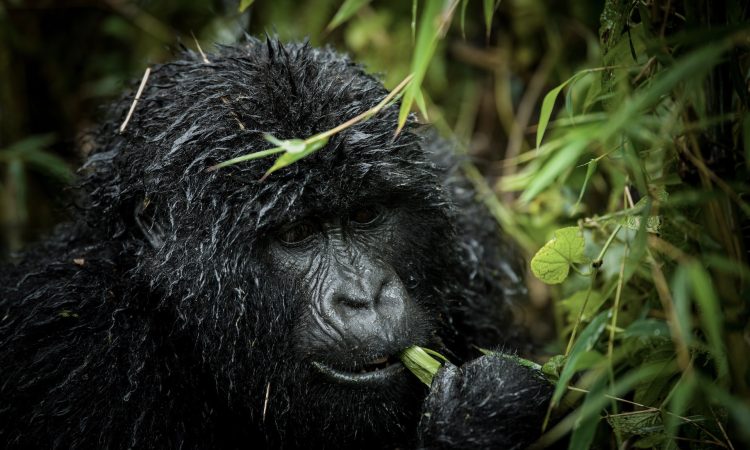
6 Days Uganda Gorilla Tracking & Maasai Mara Wildlife Safari
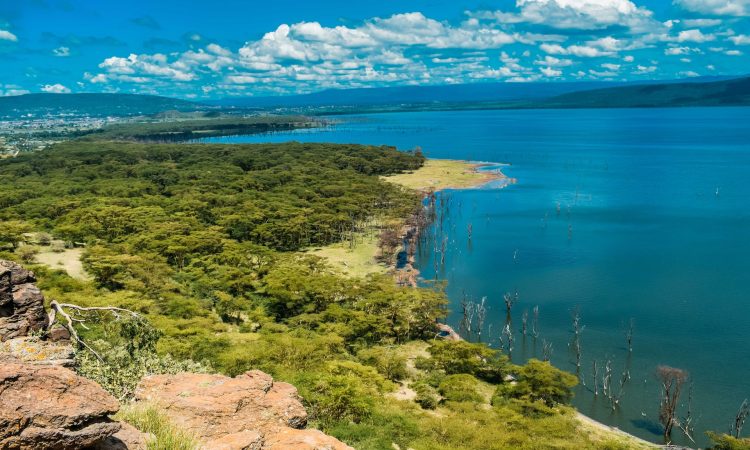
5 Days Maasai Mara & Lake Nakuru Wildlife Safari in Kenya
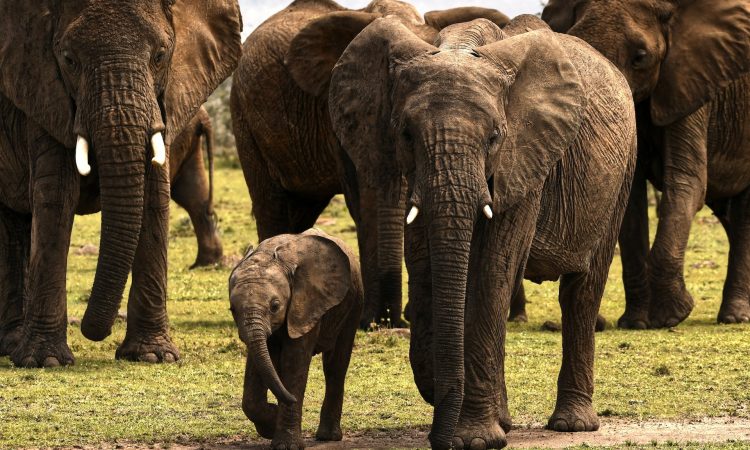
3 Days Maasai Mara Reserve Budget Wildlife Safari Tour in Kenya
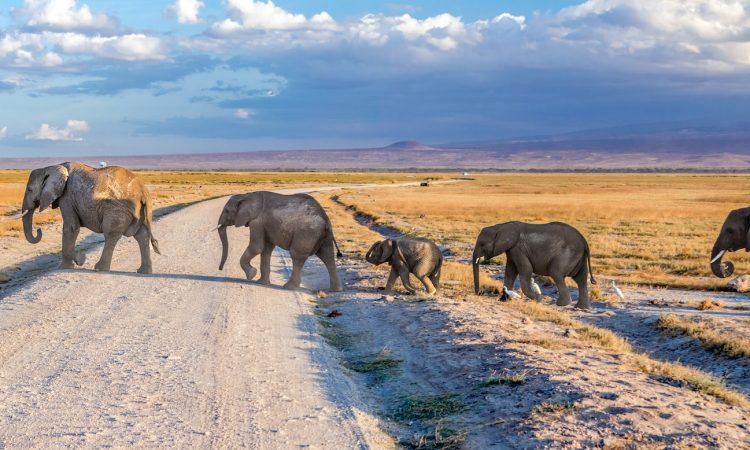
3 Days Amboseli National Park Wildlife Safari Tour in Kenya
Your adventure awaits - book your safari today.
Ready to explore the wonders of the wild? Embark on an unforgettable safari adventure with us. Experience breathtaking landscapes, encounter exotic wildlife, and create memories that will last a lifetime. Don't wait, your journey into the heart of nature starts here!
How we work
To offer a more rewarding way to travel, we do stuff the right way; right from the planning process.
We pay attention
We will spend time and pay attention to your expectations, then propose an experience that you might like.
We complement
Next we will discuss our selected options, point out the best safaris for you and make awesome recommendations.
We hold your booking
We will tentatively hold your booking and make reservations while we talk through the safari details or make changes.
Speak to an expert to start planning your African safari holiday...
Give a call to one of our specialists or arrange a video meeting/session for awesome ideas and safari advice.


- Ready-made safaris
- Experiences
- Special offers
- Accommodation
- Start planning
- Booking terms
- When to go on safari - month by month
- East or Southern Africa safari?
- Solo travellers
- Women on safari
- Accommodation types & luxury levels
- General tips & advice
- All stories
- Afrika Odyssey Expedition
- Photographer of the Year
- Read on our app
- 2024 entries
- 2024 details
- 2024 prizes
- 2024 entry form
- 2023 winners
- Collar a lion
- Save a pangolin
- Rules of engagement
- Job vacancies
- Ukuri - safari camps
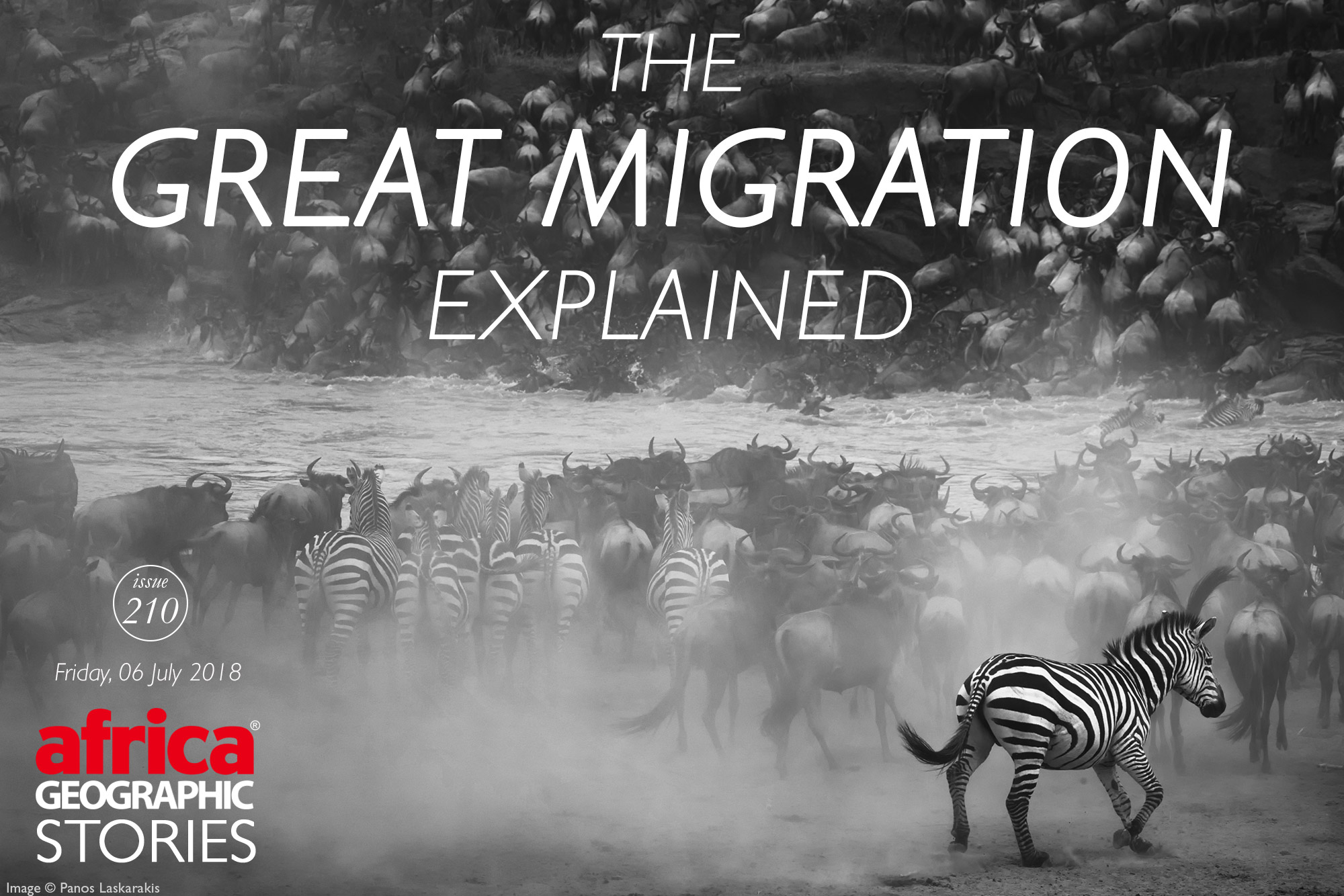
A never-ending story

teamAG + Noelle Oosthuizen
Friday, 06 July 2018
The Serengeti and Maasai Mara ecosystems see huge herds of wildebeest and zebras migrating in a continuous search for the best food and water. Although this journey follows a similar annual route, exact timing varies based on rainfall.
When the rains beckon, the wildebeest go. In spite of the big cats in waiting, or the rivers thick with crocodiles, they diligently follow their inner compass in a never-ending circular journey.
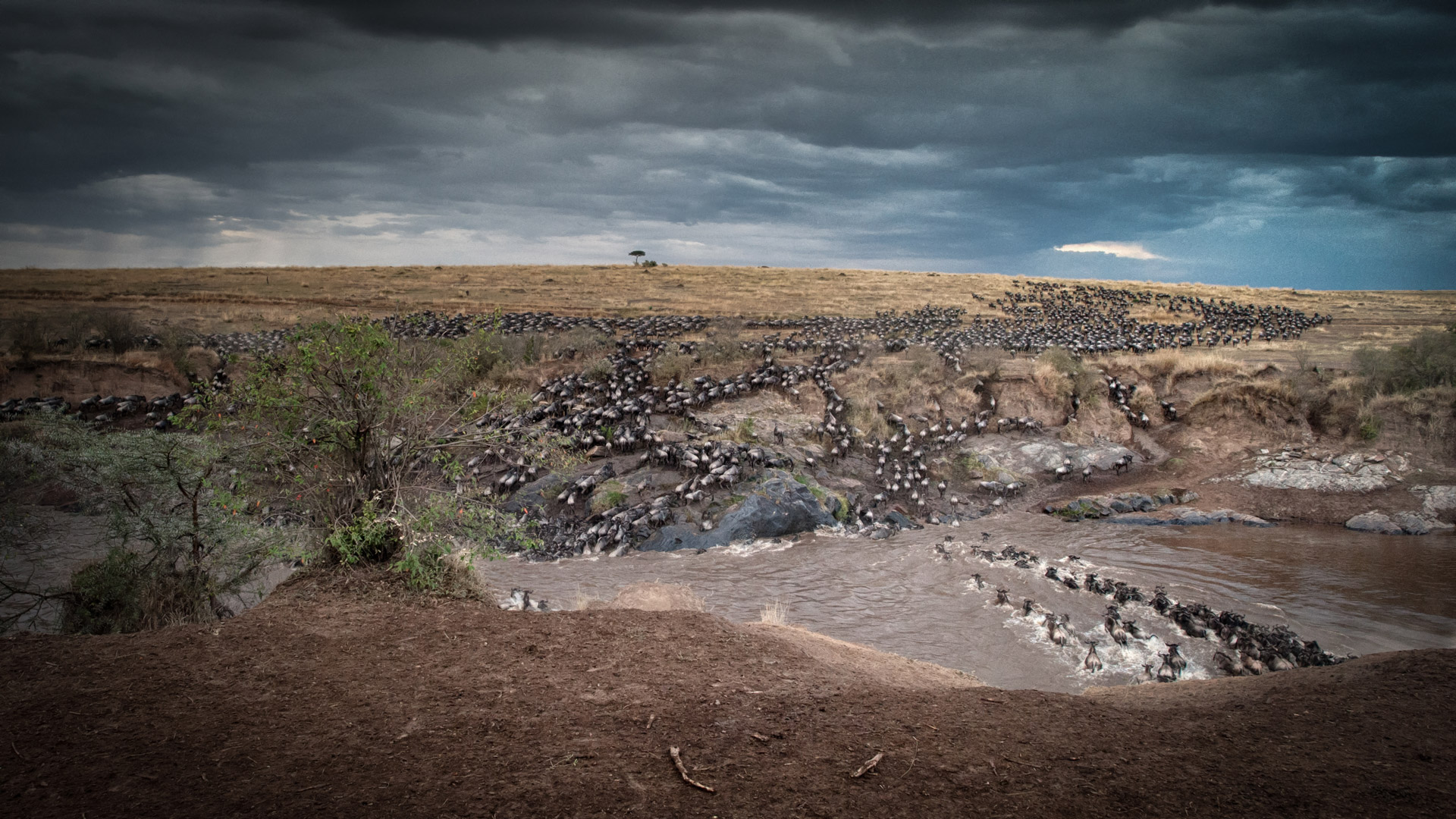
The Great Migration is the largest overland migration in the world, with wildlife travelling a total of 800 km or more during each cycle. The magnificence of the event lies in its magnitude. Between 1.5 to 2 million wildebeest, zebras and other species plod or canter across Tanzania’s Serengeti and Kenya’s Maasai Mara in search of good grazing. And if you are lucky, you get to go along for the adventure.
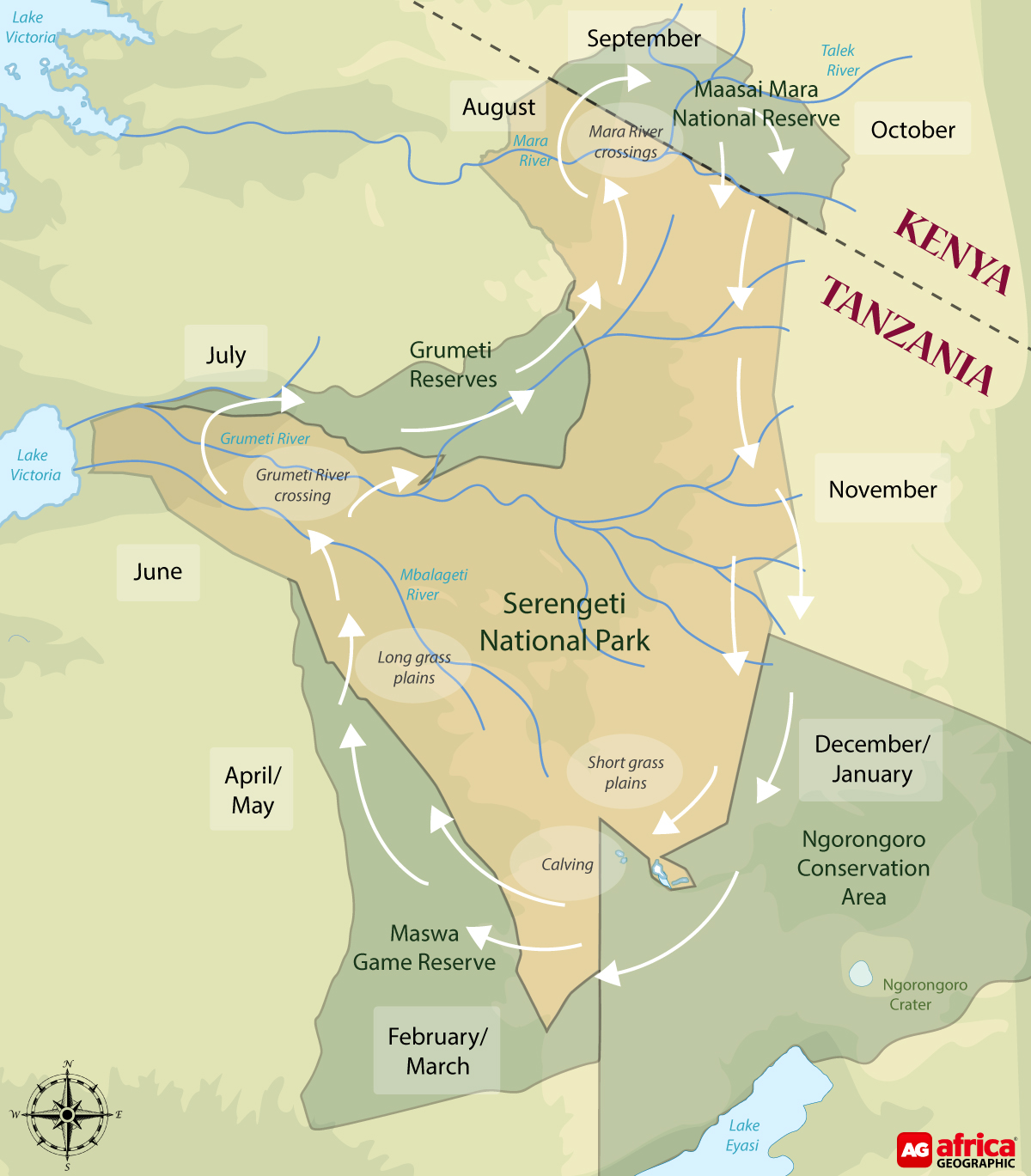
During the migration about 250,000 wildebeest and 30,000 zebra die every year as a result of predation by carnivores, drowning, thirst, hunger, and exhaustion.
And following the herds is another migratory species – human safari die-hards, who revel in the drama and magic of this, the Greatest Show on Earth. This is no cookie-cutter safari, as nature does not keep Swiss time, and even the well-documented river crossings are not predictable as to when and where. In fact, it’s the unpredictability that is the drawcard, and experienced travellers and guides know how to enjoy the many layers of bush life while waiting for the dramatic river crossings and predator action.
Follow the Wildebeest
Rainfall drives the event, so tracking the herds is not an exact science, but the same general pattern plays out each year.
JANUARY: It is the first rains in the southern Serengeti plains that beckon the herds to the Ndutu area. If you want to find the wildebeest in January, Naabi Hill and Lobo are the places to look. Many females in the herd are heavily pregnant at this point and moving towards greener grasses is of top priority.
FEBRUARY: Every year half a million wildebeest are born on the Serengeti plains, and February is the month with the highest birthing rate, sometimes seeing as many as 8,000 born each day.
The abundant new grass makes the area around Lake Masek and Lake Ndutu the ideal place for the wildebeest to give birth. The herd will stay put for a while in the southeast Ndutu area after the calves are born, before heading up north in a clockwise direction.
Calving season means adorable wobbly babies finding their legs – a bonus for predators, who do not play nicely. If you want to see a wildebeest just hours old, your best chance is to go out at midday when they typically give birth, to allow the babies the time to gain strength before nightfall.
The Serengeti also boasts a particularly healthy lion population, with over 3,000 lions in the reserve. This is of considerable significance when you realise that these big cats face a bleak future across the African continent.
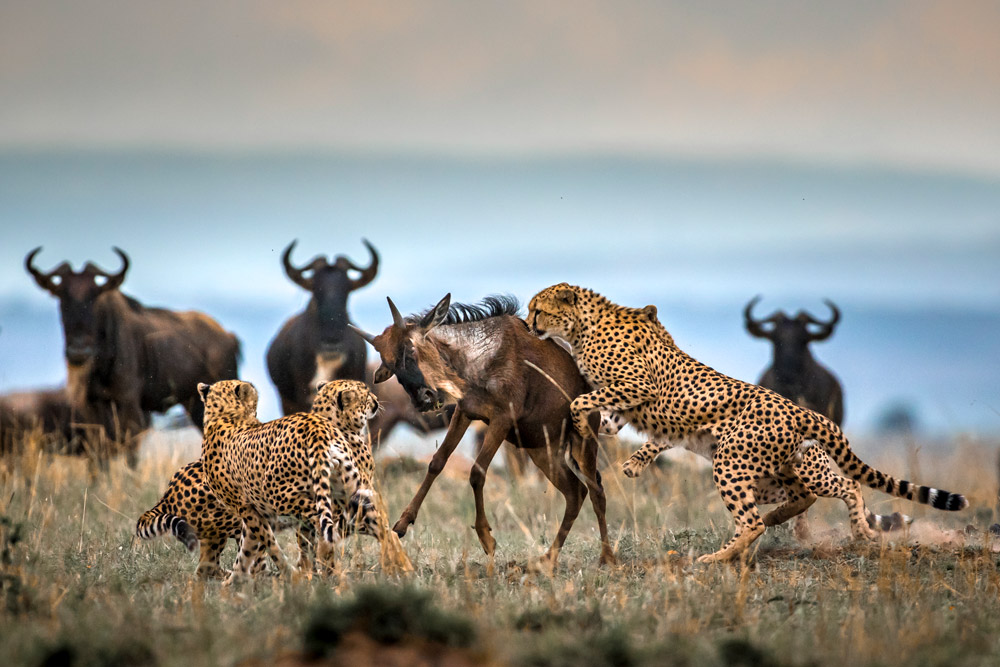
MARCH: The mobile camps in the Serengeti provide an up-close and personal experience of the migration. You can find the herds in the Ndutu and Kusini Maswa region, in the southwest of the park. Having the babies in tow means they move a bit slower. And be prepared for some afternoon rainfall in March.
APRIL: If you visit in April, you are going to need your rain jacket. The herds amble from the Ndutu region, past the Simba kopje, in the direction of Moru. The herds have now split into large groups, rather than the massive concentrations that stretch as far as the horizon. Simba kopje is where the lions are at, and it’s worth spending some time lion hunting – in the strictly photographic sense of the word. The wettest part of the day is the evening. The rainfall makes the plains slippery, and vehicles without 4×4 mode will battle to go anywhere.
MAY: For those wildlife photographers looking for action shots, set your sights on May in the Serengeti. The ‘long rains’ keep on going throughout the month. And as the calves get bigger and stronger, the distances the herd covers get longer. You’ll most likely find them between Moru and Mokoma, moving towards Lake Magadi.

JUNE: By June the rains have abated somewhat, and the herds have spread out. The front-runners reach Mbalageti River around this time. While those bringing up the rear could still be as far back as Lake Magadi or in the southernmost corner of the Simiti and Nyamuma Hills. The herds are now often in long lines as they head north.
JULY: July is mating season in the Serengeti. You can find the herds in the Grumeti Reserve, in the west of the Serengeti, and moving past Fort Ikoma. Crossings of the Grumeti River are worth hanging around for, but the Serengeti is vast and relatively under-developed with lodges, so river crossings are harder to find. Also, the Grumeti River does not have the volume of water that the Mara River has, and the crossings are not as spectacular. The herds graze their way northward, as they move toward the Maasai Mara in Kenya. This is a transborder event.
AUGUST: Come August and the herds have made their way up to the northern Serengeti, and face their biggest challenge yet: the Mara River. This fast-moving river flows through the Maasai Mara into the Serengeti. And while the gushing murky waters are captivating, they are also possibly responsible for the highest death toll en route, killing many thousands of wildebeest. Watch this dramatic video of a Mara River crossing.
Sometimes the herds plunge en masse off steep banks in their desperate attempts to get across the river, or after being spooked by lions, and the fall alone will kill many individuals. Others drown as they are crushed by the sheer volume of panicking wildebeest trying to scramble up the equally steep banks on the other side. Every death means dinner for crocodiles, birds and fish – such is nature’s bounty.
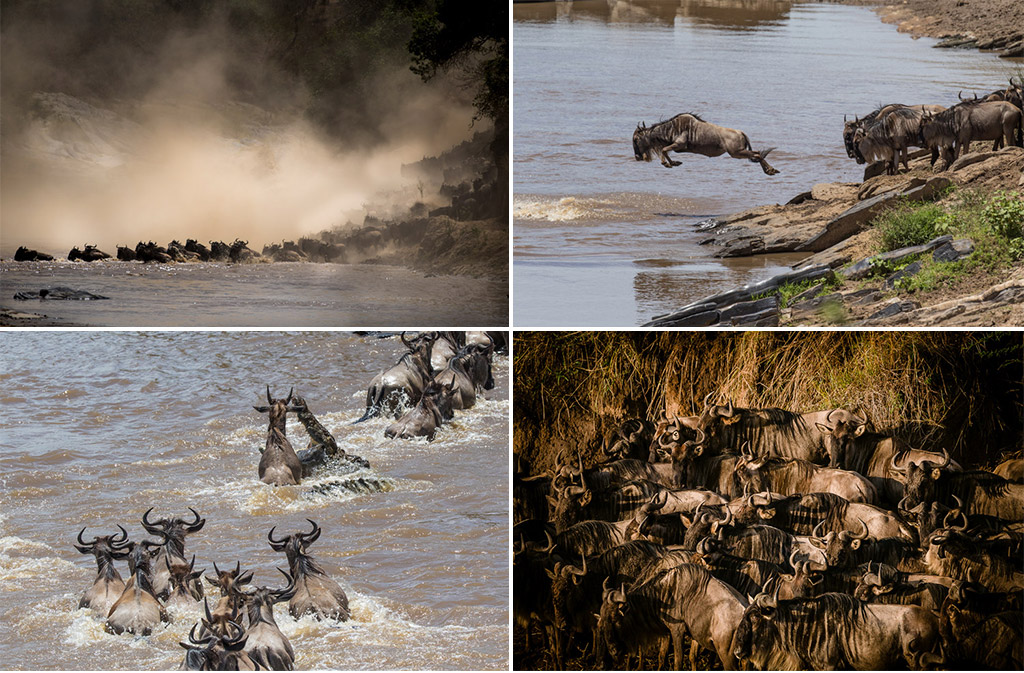
And amidst the panic, the dust and the noise, the big cats and hyenas pick off the stragglers and the injured. Be warned that aside from the massive herds, the river crossings also attract large volumes of tourists, who congregate at strategic points to witness this spectacle.
There is no class system here, as privately-guided wealthy couples in open Land Rovers jostle for the best views with budget back-packers crammed into mini-vans with pop-up roofs.

SEPTEMBER: You can catch the tail end of the Mara River crossing or go see the herds out in the vast open plains of the Maasai Mara, where they are like flies in places. Pack your hat, because the weather will be hot and dry.
OCTOBER: October offers a scene of casual grazing in the Maasai Mara. The push is over, and the fresh grass is the reward. For the survivors, that is.
NOVEMBER: What is known as ‘the short rains’ begin in November, triggering another move, as the herds leave Kenya and south to western Loliondo and the Lobo area in Serengeti National Park. Whether it rains in November or not, is nature’s call. But pack some extra jerseys for the cooler weather. At this point, the herds organise themselves into smaller family groups and get on with the serious business of grazing.
DECEMBER: By December the herds are back in the south of Serengeti, and the first act begins all over again.
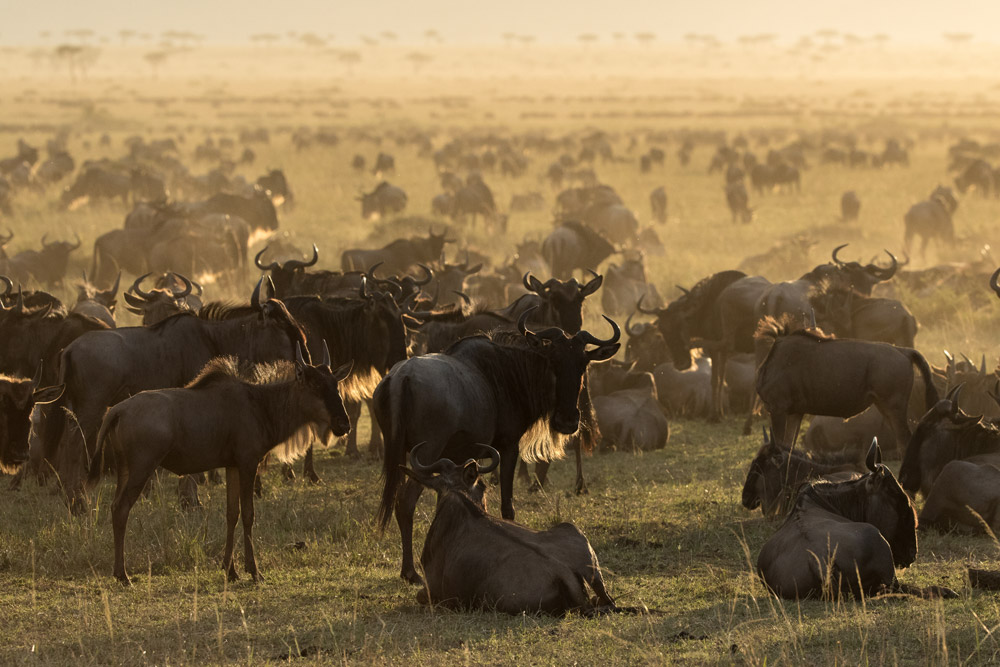
River Crossings
When people say they’ve come to see the migration, they really mean they have come to see the river crossings. Watching the wildebeest hurl themselves into the water, one after the other, in a flurry of panic, sends a surge of adrenalin through the most seasoned bush-junkie. Watch this dramatic video of a Mara River crossing.
The river crossings are the scenes we’ve all watched on Planet Earth – the chaotic clamber of wildebeests, zebras and a few antelope species across turbulent crocodile-infested waters. And then, of course, you have the lions and leopards waiting amongst the riverine shrubs to ambush unsuspecting victims. For those of us with limited time and rudimentary camera equipment, it can be challenging to capture the full impact of thundering hooves, the frantic urgency to get to the other side and the drama of predations. Sometimes the best strategy is to put the camera down and simply watch and absorb the drama playing out in front of you.
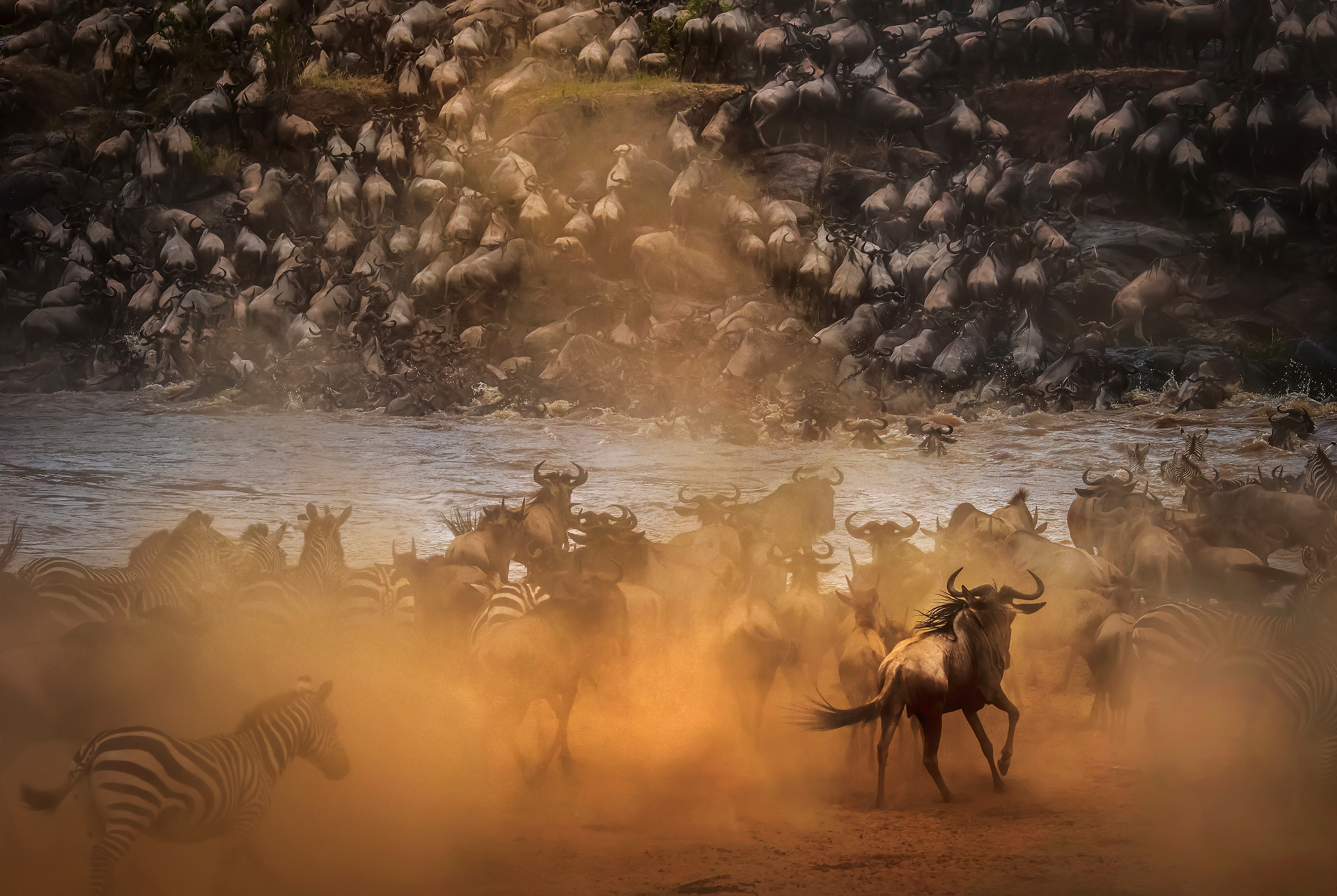
Avoiding the tourists
Avoiding tourists is somewhat of a sport in the Serengeti and Maasai Mara, particularly during the peak safari season. If you are the tourist who skips the Eiffel Tower and seeks out that artisan cheese store in the back alleys of Paris, then perhaps give the Mara River crossings a miss.
The rainy season, from late March to late June, offers up a less crowded Serengeti, as the herds move into the western part of the park. The mass of animals moving across the plains is captivating, but what you are really on the lookout for is a hunt. And the open plains give you prime viewing.
Moving away from the herds and following a pride of lions has its own bittersweet rewards. The predators face struggles of their own out on the plains: defending their territories, protecting their cubs, and nursing the battle wounds from a particularly hard hunt.
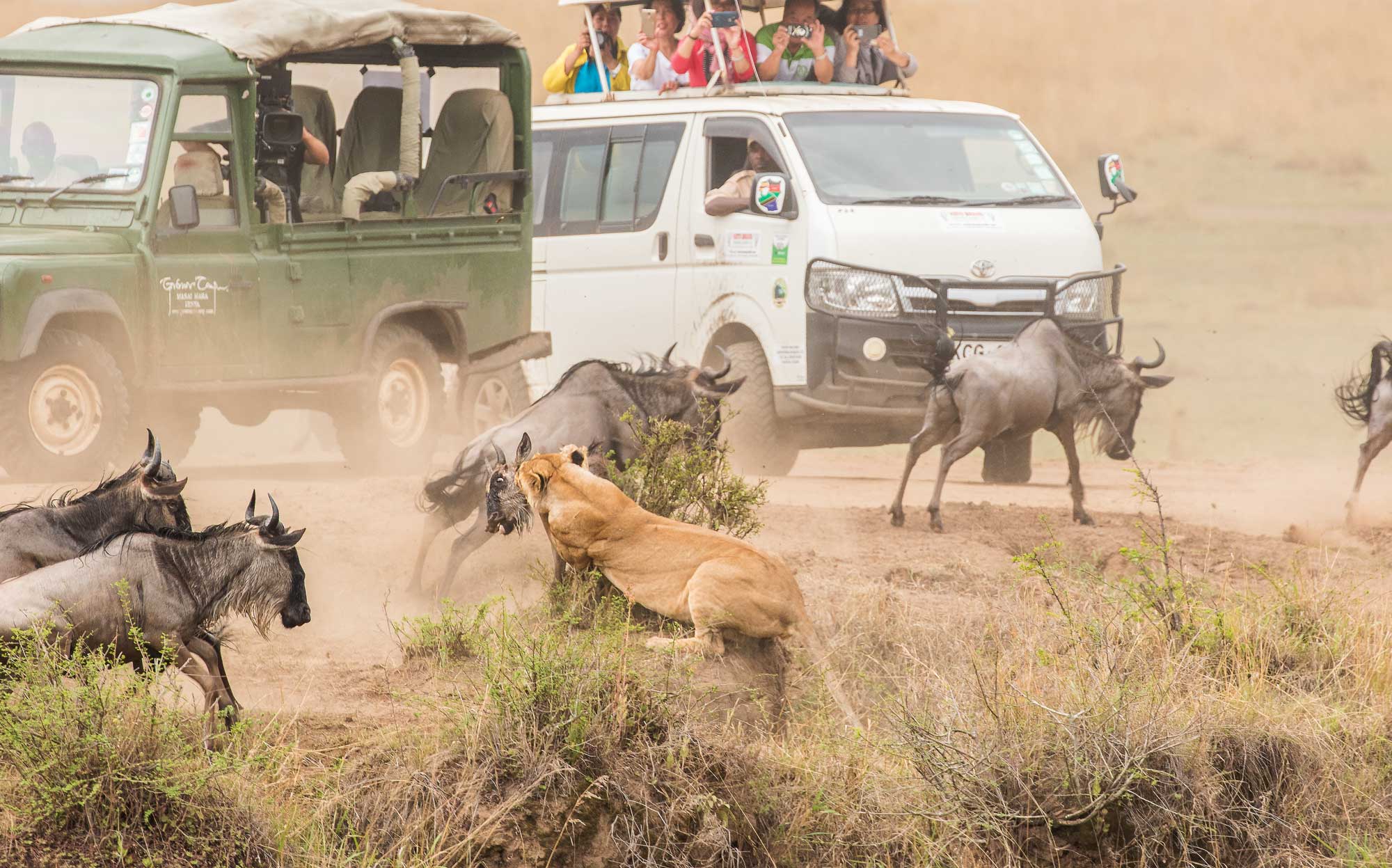
Just because it is the rainy season doesn’t mean it will rain. And if it does, it might not be a continual downpour. Again, the whims of the wild. As a bonus, catching the lodge off-season means less pricey accommodation.
Avoiding tourists is more of a challenge in the Mara, the reserve is smaller and as soon as the herds arrive, so do the crowds. The trick here is to stay in one of the private conservancies bordering the reserve. They are close enough to make day trips to see the herds doable, and it means fewer crowds back at camp. These private conservancies can offer activities not permitted in the parks, such as night drives and bush walks.
Top tips for witnessing the Migration:
- Decide what you want to see the most because this will impact on the timing and location of your visit. Broadly, the choices are river crossings, massive herds as far as the eye can see or calving. You will enjoy predator action at all times;
- Choose your lodge carefully because easy access to the herds is vital. You don’t want to spend hours getting to and from the best locations, eating the dust behind a long line of other vehicles;
- If you seek privacy and exclusive wildlife encounters during the migration, choose a lodge in one of the conservancies neighbouring the parks. Alternatively, consider visiting during the ‘ secret season ’;
The Closing Curtain
If you think about it, the wildebeest is a rather understated animal, zoomed past on most safaris to get to something ‘more exciting’. It’s nice that there is a show that puts them on the centre stage. And, with a bit of planning ahead, the front row seats are yours.

TRAVEL WITH AFRICA GEOGRAPHIC Check out our preferred camps & lodges for the best prices, browse our famous packages for experience-based safaris and search for our current special offers .
Maasai Mara and Serengeti safaris: • Serengeti great migration safari (5 days) • Maasai Mara Secret Season (6 days) • Maasai Mara Migration Season Safari (7 days)
ABOUT THE AUTHOR, NOELLE OOSTHUIZEN
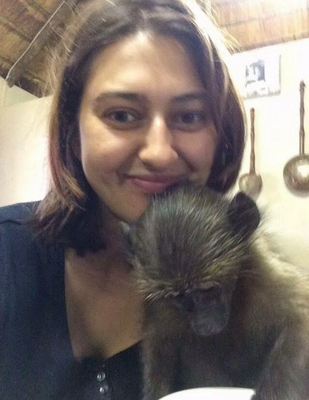
HOW TO GET THE MOST OUT OF AFRICA GEOGRAPHIC:
- Travel with us . Travel in Africa is about knowing when and where to go, and with whom. A few weeks too early / late and a few kilometres off course and you could miss the greatest show on Earth. And wouldn’t that be a pity? Browse our ready-made packages or answer a few questions to start planning your dream safari .
- Subscribe to our FREE newsletter / download our FREE app to enjoy the following benefits.
- Plan your safaris in remote parks protected by African Parks via our sister company https://ukuri.travel/ - safari camps for responsible travellers
We're an eclectic pack of safari experts, storytellers, admin and tech nerds and digital natives whose sole mission is celebrating Africa and doing good. We do this by creating life-changing, responsible safaris just for you, publishing informative, factual articles about Africa's incredible natural wonders and raising donations for worthy causes. This MANIFESTO explains our approach to travel and conservation.

Friend's Email Address
Your Email Address
TOP DESTINATIONS
- Kruger Park
- Okavango Delta
- Serengeti National Park
- Victoria Falls
TOP COUNTRIES
- South Africa
TRAVEL DEALS
View All Travel Deals
SOUTHERN AFRICA
East africa, indian ocean islands, top experiences.
- Beach Holidays
- Family Safaris
- Honeymoon Safaris
- Desert Safaris
- Luxury Rail Safaris
- Multi-Generational Safaris
- Positive Impact Safaris
- Photographic Safaris
- Walking Safaris
WILDLIFE SAFARI
- Big Five Safaris
- Birding Safaris
- Gorilla Trekking Safaris
- Migration Safaris
- Mobile Camping Safaris
- Horseback Safaris
FEATURED EXPERIENCES
Comfort levels, property types.
- Tented Camps
- Boutique Hotels
Featured Safari Collections
- Elewana Collection
- Time & Tide
- Red Carnation
GET TO KNOW US
- Meet The Team
- Pricing Explained
- Traveller Reviews
- Traveller Stories
- Why Book With Us?
- HerdTracker
- Safari Cost Calculator
- South Africa In 360
- Trusted Safari Partners
What are you looking for?
- Safaris & Tours
- Destinations
- Experiences
- Accommodations
- Why book with us?
Hello traveller!
It's in Cape Town now.
We're sorry. Our safari planners aren't available now. Our office hours are 08:00 - 19:00 (GMT+2).
Call us to speak to an experienced safari planner.
Alternatively, we recommend...
Schedule a phone or Zoom call with one of our safari planners
Complete our travel enquiry form to connect with a safari planner
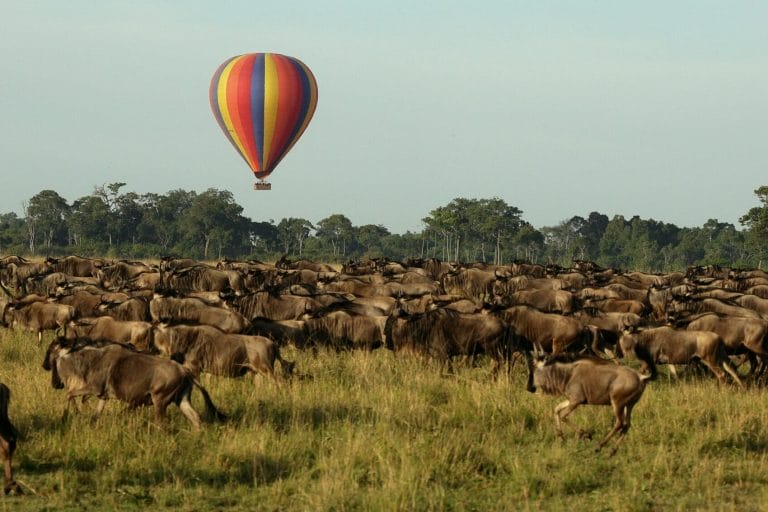
The Greatest Show on Earth: Africa's Wild Migration Explained
What is the great migration.
Every year, about two million wildebeest and 20,000 plains game travel from Tanzania’s Serengeti to Kenya’s Masai Mara in search of abundant grazing pastures and life-giving water. The seasons dictate this deadly Great Wildebeest Migration voyage, and when the rains come, the wildebeest follow.
This historic Great Migration Africa route begins in the north and ends in the south, stretching about 3000 kilometres and seeming to go on forever.
The Wildebeest Migration is a breathtaking natural phenomenon and a must-see safari for adventurers, wildlife enthusiasts, and those seeking a little more from their African vacation.
Because the Great Wildebeest Migration has no beginning or endpoint and moves in a clockwise route, herdtracking is difficult to forecast. Discover Africa Safaris, on the other hand, invented a great application called “ Herdtracker ” to assist customers to track the progress of the wildebeest migration and plan a once-in-a-lifetime safari.
Five Facts about the Great Migration
1. The Serengeti National Park has the world’s oldest ecosystem. It is home to a diverse range of plants and creatures that can be found nowhere else on the earth.
2. In the Mara River, crocodiles waiting for the herds, drown their prey by seizing them in their powerful teeth and pushing them below the water, twisting them to break them into bite-sized pieces. A crocodile may lunge more than half of its body length out of the water and use its tail as a secondary weapon to grasp a potential victim.
3. During the Great Wildebeest Migration Africa, around 1.5 million wildebeest, 200,000 zebra, and several other animals travel through the country.
4. Zebra and wildebeest will cohabit together since they eat different parts of the same species of vegetation.
5. The Serengeti environment is home to around 3,000 lions who follow the migratory herds across the reserve.
Where the Great Wildebeest Migration occurs
Many people think the Great Migration happens only once a year, however it happens all year, with each season offering a unique wildlife experience. While the Wildebeest migration Africa takes place in a clockwise loop between Tanzania and Kenya , the Serengeti National Park, Ngorongoro Conservation Area, Loliondo Game Managed Area, and Grumeti Reserve is the main destinations.
The Masai Mara Game Reserve , which borders the Serengeti National Park to the north, is part of the Kenyan movement. Each month has its own set of advantages in terms of weather, wildlife, migratory movements, predator encounters, river crossings, and where to stay to make the most of your tour to see the Great Wildebeest Migration. This information can be found by having a look at the Great Wildebeest Migration Map .
What to Expect?
- Many people think that the great wildebeest migration only happens once a year, but the migration is in fact an all-year-round event — with each time of year offering a unique wildlife experience.
- Select a month below to find out what each month offers in terms of weather, wildlife, migratory movements, predator interactions, river crossings and where the best place to stay is, to get the most out of your trip to see the great wildebeest migration.
When is the best month to view the Great Migration?
Migration in january.
- Weather: A hot and humid summer month with average temperatures ranging from 15°C (59°F) to 28°C (82.4°F).
- Wildebeest migration movement: Between Lobo and Naabi Hill, wildebeest herds converge on the Serengeti’s eastern edge in January. The herds are on the move in search of good grasses for their young.
- Predatory encounters: Because it is calving season, big cats visit in January.
- Accommodation options: Depending on the conditions, it is recommended that you stay in the city centre and only travel north or south from there.
Migration in February
- Weather: Maximum temperatures of 28°C (82.4°F) and minimum temperatures of 15°C (59°F) characterize this month’s weather.
- Wildebeest migration movement: For the past ten to twelve years, wildebeest herds have been settling in and around Lakes Ndutu and Masek. This meadow is lush in February, making it an ideal location for wildebeests to give birth to their young.
- Predatory encounters: As lions and leopards move into the area to hunt on young and vulnerable calves, predatory confrontations are quite frequent.
- Accomodation options: For a migration safari to the Serengeti in February, you may reserve your Ndutu accommodation well in advance and have peace of mind.
Migration in March
- Weather: In Tanzania’s Serengeti National Park, the first month of fall, March, remains warm, with average temperatures ranging from 28°C (82.4°F) to 15°C (59°F). March has a reputation for being a rainy month. The meadows are lush and fruitful, providing vital nourishment for the large herds of wildebeest.
- Wildebeest migration movement: The Serengeti’s Ndutu and Kusini Maswa districts are home to the Serengeti’s wildebeest herds. They move slowly, while numerous newborn calves are fed.
- Predatory encounters: Predators see calves as easy prey since there are so many of them. There will be a lot of lions and leopards to see.
- Accommodation options: We recommend spending March in the Ndutu area. Mobile camps in Kusini and Maswa operate during the month of March, providing wonderful possibilities to be close to the herd during your Serengeti migration safari.
Migration in April
- Weather: The Serengeti is damp in April, but you’ll adore it. Bring a raincoat and your sense of humour. April showers are nothing to be concerned about. The rain falls mainly in the evenings, and the days are mostly sunny.
- Wildebeest migration movement: Because it is the most consistent, April is one of the finest months to watch the herds. When newborn calves and foals reach the age of mobility, they begin to move.
- Predatory encounters: The populations of lions and big cats in these areas are thought to be steady. Expect a lot of physical interaction between the hunter and the prey.
- Accommodation options: The migration is best seen in April in the Simba kopjes districts of Moru and Kusini.
Migration in May
- Weather: In Serengeti National Park, Tanzania, April is a moderate fall month, with typical highs of 26°C (78.8°F) and lows of 16°C (60.8°F). May is the wettest month in the Serengeti. Roads can be dangerous and challenging to manoeuvre.
- Wildebeest migration movement: As the calves’ legs become fully functioning in May, the herds take up the pace.
- Predatory encounters: Crocodiles of the Grumeti genus.
- Accommodation options: Staying in the Moru region is recommended, however, Serengeti migration safari arrangements should be arranged as soon as feasible.
Migration in June
- Weather: Temperatures at Serengeti National Park range from 13°C (55.4°F) to 25°C (77°F) in June, the first month of the winter. In June, the rainy season comes to an end. The fields are lushly green and densely forested.
- Wildebeest migration movement: Wildebeest populations travel over great distances. It could take up to three hours to cover the distance between the leading and trailing herds.
- Predatory encounters: Each migrating animal must first navigate a crocodile-infested river, the first of many dangerous river encounters.
- River crossings: The Grumeti River crossing season runs from June to August, depending on the river’s water level. The river is rarely full enough to make dramatic crossings like those seen on the Mara River in July and August.
Migration in July
- Weather: July is another nice winter month in Tanzania’s Serengeti National Park, with average temperatures ranging from 13°C (55.4°F) to 25°C (77°F).
- Wildebeest migration movement: In pursuit of water and greener grass, herds of wildebeests began to migrate quicker.
- Predatory encounters: Expect predatory encounters, such as with crocodiles.
- River crossings: The Grumeti and Mara Rivers are both crossed.
- Accommodation options: If you want to see early river crossings, the Grumeti River is a fantastic site to come to in July. However, due to the limited number of rooms available, we strongly recommend that you book as soon as possible to avoid disappointment.
Migration in August
- Weather: August is the hottest month of the year in Serengeti National Park, with average temperatures ranging from 14°C (57.2°F) to 26°C (78.8°F). August is a hot and humid month when the dry season comes into high gear.
- Wildebeest migration movement: Wildebeest herds will continue their search for lusher, greener vegetation, attempting to cross the Mara River’s treacherous, crocodile-infested waters.
- Predatory encounters: Crocodiles are among the predators encountered.
- River crossings: If you want to see river crossings, August is the best month to go. The animals will cross a foreign border between Tanzania’s Serengeti and Kenya’s Masai Mara.
- Accommodation options: Book early on both sides of the Mara River. The Olakira Camp, Sayari Mara, and Mara River mobile camps offer a once-in-a-lifetime migratory safari.

Migration in September
- Weather: September offers more hot and dry weather, as the dry season continues in the Serengeti and Masai Mara.
- Wildebeest migration movement: Most of the wildebeest have crossed the Mara River, and the majority of the herds will be in the Greater Masai Mara area, eating the lush green grass resources before venturing north towards the private conservancies (Mara North, Olare Orok).
- Accommodation options: Similar to August, September is an easy month to predict where the herds will be. You can still stay in the Serengeti early in the month, but its safer to stay on the Masai Mara side to view the last of the Mara River crossings. The Olakira Camp or the Mara River mobile camps are unrivalled migration safari options.
Migration in October
- Weather: October will be milder, as the dry season approaches its climax. You might even experience early rain in the Masai Mara and the Serengeti.
- Wildebeest migration movement: The wildebeest herds are in the Masai Mara, but will start to slowly move back into the Serengeti moving through Loliondo in the east.
- Accommodation options: Its best to stay in the Masai Mara to have the best opportunity to see the wildebeest herds. Nomad’s Lamai and Lemala’s Kuria Hills are good migration safari destinations.
Migration in November
- Weather: November brings cooler weather, as the early rains start to fall in the Serengeti.
- Wildebeest migration movement: The wildebeest herds are now in the Serengeti, stationed in the Lobo, Mbuze Mawe and Seronera Valley areas where water is abundant.
- Accommodation options: The south-eastern Masai Mara itself, combined with north-eastern Serengeti is where you need to be. Sala’s Camp & the Lobo mobile camps are two authentic migration safari accommodations.
Migration in December
- Weather: Expect wet weather in December, as the short rains begin to fall in the Central Serengeti.
- Wildebeest migration movement: The wildebeest herds will move quicker now, as far south as possible, towards the Southern Plains which they usually reach within a couple of days.
- Accommodation options: If there’s been lots of rain in the northern Serengeti, then South of Lobo is the ideal place to see the wildebeest herds. Kleins Camp, Migration Camp and the Lobo Mobile Camps are all great migration safari accommodation choices in December.
Our Recommended Migration Safaris
The herds are moving constantly, we recommend you look at our sample itineraries..
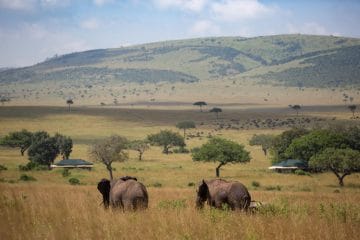
Highlights of Kenya Luxury Fly-In Safari
East Africa Kenya Nairobi Chyulu Hills Maasai Mara
From $ 10068 /USD
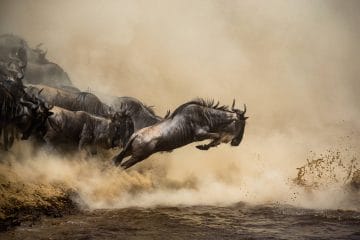
July/October Great Wildebeest Migration Safari
Tanzania Tarangire Ngorongoro Crater Serengeti
From $ 8240 /USD
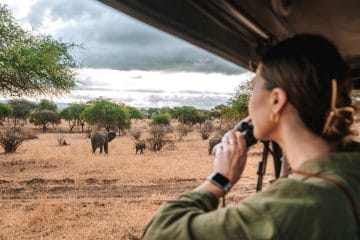
Tarangire Game Viewing and River Crossings in t...
East Africa Tanzania Arusha Tarangire Serengeti
From $ 10690 /USD
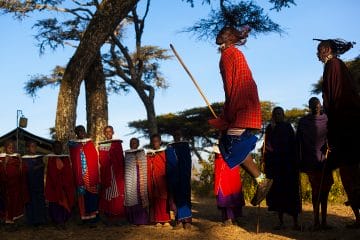
Tanzania Small Group Set Departure Safari
East Africa Tanzania Arusha Lake Manyara Ngorongoro Crater Serengeti
From $ 5440 /USD
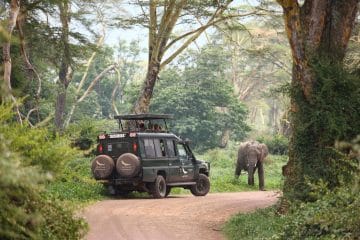
Highlights of East Africa - Luxury experience
East Africa Tanzania Ngorongoro Crater Serengeti Kenya Maasai Mara
From $ 8900 /USD
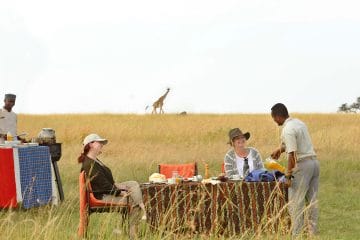
Migration Serengeti Safari Short and Sweet
East Africa Tanzania Arusha Serengeti
From $ 4990 /USD
Travel with Confidence
With over 20 years of experience, our team will help you tailor your itinerary to your perfect adventure., 24/7 support, personalized, planning a trip to see the wildebeest migration, but not sure when or where to go.
Find out where the herd will be, and what to expect each month of the year, using our migration map with monthly predictions.
Our experts predict how the wildebeest migration will move based on previous years migratory patterns and real time updates received from pilots, rangers and safari guides in the Serengeti.
Why travel with us?
Recent reviews from travellers who planned and booked their africa trips with discover africa safaris, exceptional service.
South Africa Family Safari Review
Stuart, Australia 10 Jul 2023
Discover africa safaris helped organize the perfect vacation for my family..
Family Kruger Holiday Review
James, United States 08 Feb 2023
Adelle bell is a true professional.
Cape Town Adventure & South African Safari Review
Anne, Australia 07 Dec 2022
Excellent experience, great communication, custom itinerary..
Victoria Falls & Okavango Delta Review
PVX, United States 11 Jul 2022
Excellent experience all-around with discover africa safaris .
Kruger Adventure Review
Ryan L., United States 23 Feb 2019
You can book your african holiday in full confidence with discover africa.
9-Day Safari Trip in Africa
Family Olivier, Belgium 10 Oct 2018
Ready to plan your tailor-made safari.

Lana Goodwin, Safari Travel Planner
Free safari planning advice from destination experts
Registered Members of these Organizations
USEFUL LINKS
- Safari Tours
- Accommodation
- Why Book with us?
- Content Collaborations
- Safari Cost Estimator Tool
- Wildebeest Migration
- Privacy Policy
- Website Terms of Use
POPULAR COUNTRIES
- View All Countries
POPULAR DESTINATIONS
- View All Destinations
- Cape Town Holidays
- Kruger National Park
- Etosha National Park
- Chobe National Park
TRAVEL BLOGS
- Travel News Digest, 26 April: Namibia Adds Visa-on-Arrival in Walvis Bay, Uganda Deforestation Concerns
- The Best of Kenyan Cuisine: 10 Dishes to Savour on your next Safari
- Norse Atlantic Adds New Direct Flight to Cape Town
- Travel News Digest, 19 April: SA Airports Celebrated, Rhino Poaching Concerns, Cape Town ‘Big Six’ Appeal
- FastJet Adds Surcharge to Vic Falls Route
OUR LOCATION
- 2nd floor, Tygervalley Chambers One, 27 Willie van Schoor Avenue, Bellville, Cape Town , 7530
- Go, Find, Explore with Deks Safaris
- +256 708 099401
- +1(978) 424 1409
- [email protected]

Great Wildebeest Migration in Maasai Mara

Kenya Wildlife Photography Tour Holiday

- Adventure Holidays
- Africa Adventure Tours
- Africa Safari News
- Africa Senior Tours
- Africa Tour
- Africa Tours
- Africa Village Tours
- Africa Wildlife Safari
- Africa Wildlife Tour
- Great Wildlife Migration
- Hot Air Balloon Safari
- Kenya Birding Safaris
- Kenya Cultural Tours
- Kenya Safari Holidays
- Kenya Wildlife Safaris
- Tanzania Safari Holidays
- Tanzania Wildlife Safaris
- The Maasai Cultural Tour
- Travel News
- Wildlife Safari News
- Adventure in Africa
- Adventure Tour
- Adventure Tours
- Adventures of a lifetime
- Africa Cultural Tours
- Africa Holidays
- Africa Safari
- Africa Safari Holidays
- Africa Safaris
- Africa Tour Packages
- Africa Trips
- Africa Vacations
- Africa wildlife safari
- Best Africa Safaris
- Best time to visit Africa
- best time to visit Kenya
- best wildlife safari
- Bird watching tour
- birding in Kenya
- Chimpanzee tracking in Africa
- cost of great wildlife migration
- cost of Kenya holidays
- cost of Kenya safari
- cost of Kenya tour
- culture of Kenya
- Deks africa tours
- Deks Safaris
- Deks Safaris Africa
- deks safaris and tours ltd
- Deks uganda safaris
- deks uganda tours
- great wildebeest migration
- group safari
- group trips
- Kenya adventure tours
- Kenya beach holidays
- Kenya bird watching
- Kenya birding tour
- Kenya group holidays
- Kenya group tours
- Kenya holidays
- Kenya luxury safari
- Kenya luxury tours
- Kenya luxury trips
- Kenya safari
- Kenya safari holidays
- Kenya safari vacation
- Kenya safaris
- Kenya tour packages
- Kenya tours
- Kenya wildlife safari
- Kenya wildlife tour
- Mountain trekking
- Reputable Uganda Tour Operator
- uganda safari operator
- visit Kenya
- when to visit Kenya
- wildebeest migration
- wildebeest migration price
- wildlife in Kenya
- wildlife migration
- wildlife of Kenya
- wildlife safari
- wildlife safari Kenya
- Wildlife Tour
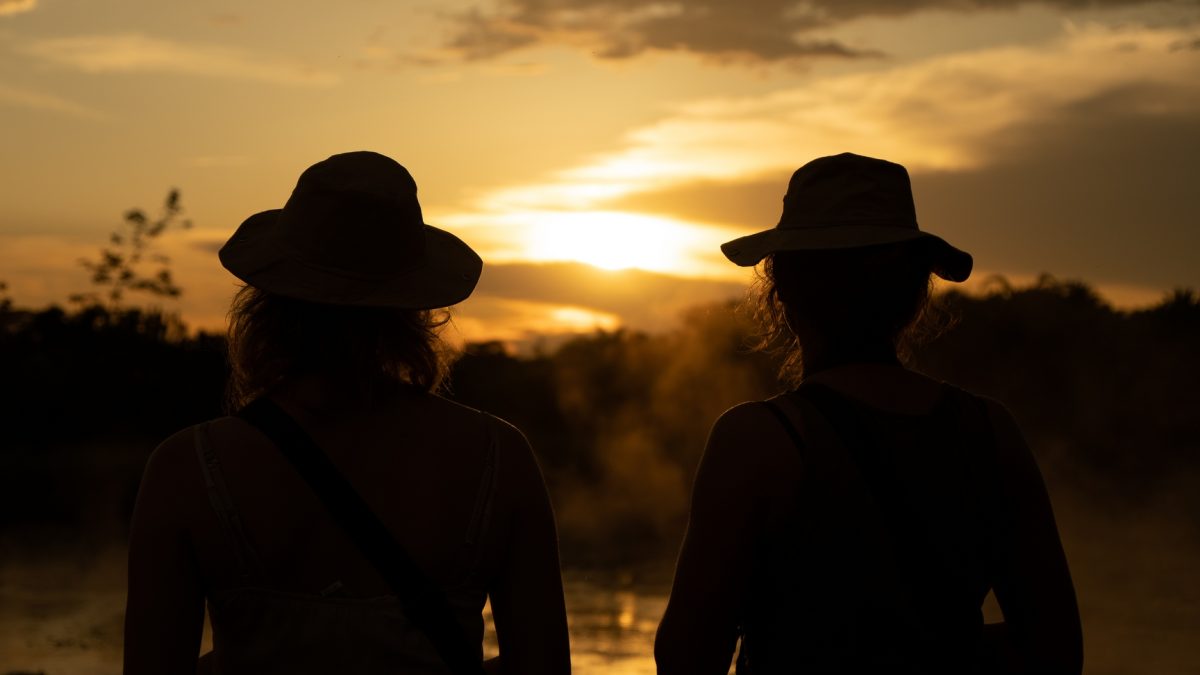
Kenya Wildlife Safari
The Great Wildebeest Migration in Kenya (with Photos & Videos) – Deks Tours
The Great Wildebeest Migration in Kenya is one of the most iconic wildlife spectacles on the planet. It is a natural phenomenon that involves millions of wildebeests, zebras, and other herbivores moving in a cyclical pattern between the Serengeti National Park in Tanzania and Kenya’s Maasai Mara National Reserve .
Closer Look at the Great Wildebeest Migration in the Kenya Context
Timing and route.
The Great Wildebeest Migration in Kenya typically takes place from July to October. During this period, the herds move northward from the Serengeti into the Maasai Mara .
The key crossing point into Kenya is the Mara River, where herds brave crocodile-infested waters during dramatic river crossings.
Once in Kenya, the animals disperse throughout the Maasai Mara Reserve and surrounding conservancies in search of fresh grazing land.
Wildlife Involved
The migration primarily consists of wildebeests, numbering in the millions. They are joined by hundreds of thousands of zebras.
Other herbivores, such as gazelles and elands, also participate in the migration.
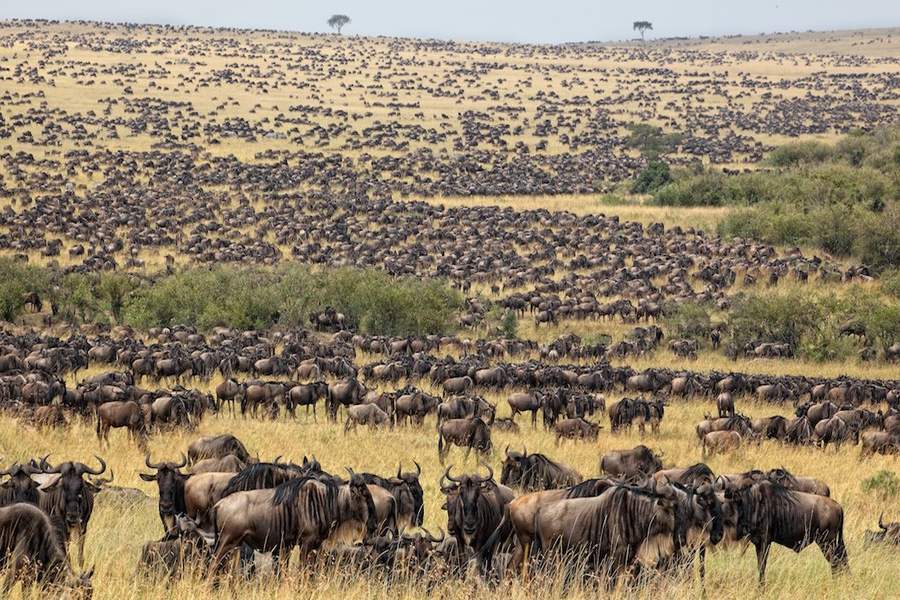
wildlife migration Safaris in Kenya
Predators and Challenges
The Great Wildebeest Migration in Kenya is closely followed by predators, including lions, leopards, cheetahs, and hyenas, making it an excellent time for wildlife enthusiasts to witness predator-prey interactions.
The river crossings are some of the most perilous moments for the migrating animals, as they face the threat of crocodile attacks and ambushes by waiting predators.
Tourism and Safaris
The Great Migration is a massive draw for tourists, and Kenya’s Maasai Mara is one of the best places to witness this phenomenon up close.
Numerous safari lodges and camps in the Maasai Mara offer excellent wildlife viewing opportunities during the migration season.
Ecological Significance
The Great Wildebeest Migration in Kenya has a significant ecological impact. It helps maintain the grasslands by grazing and stimulates the distribution of nutrients through dung, benefiting the ecosystem.
It provides a critical source of food for the predators that follow the herds.
Conservation and Protection
The conservation of the Great Wildebeest Migration and its associated habitats is a priority for Kenya. Efforts are made to protect the animals, their migration routes, and their breeding grounds.
Conservation organizations and local communities work together to ensure the long-term survival of this natural wonder.
Cultural Significance
The Maasai people, who inhabit the region surrounding the Maasai Mara , have a deep cultural connection to the wildlife and the migration. Their traditional way of life has coexisted with this annual event for generations.
Witnessing the Great Wildebeest Migration in Kenya is an unforgettable experience for anyone interested in wildlife and nature. It’s an extraordinary display of nature’s power and resilience, and it highlights the importance of conservation efforts to protect these incredible events for generations to come.
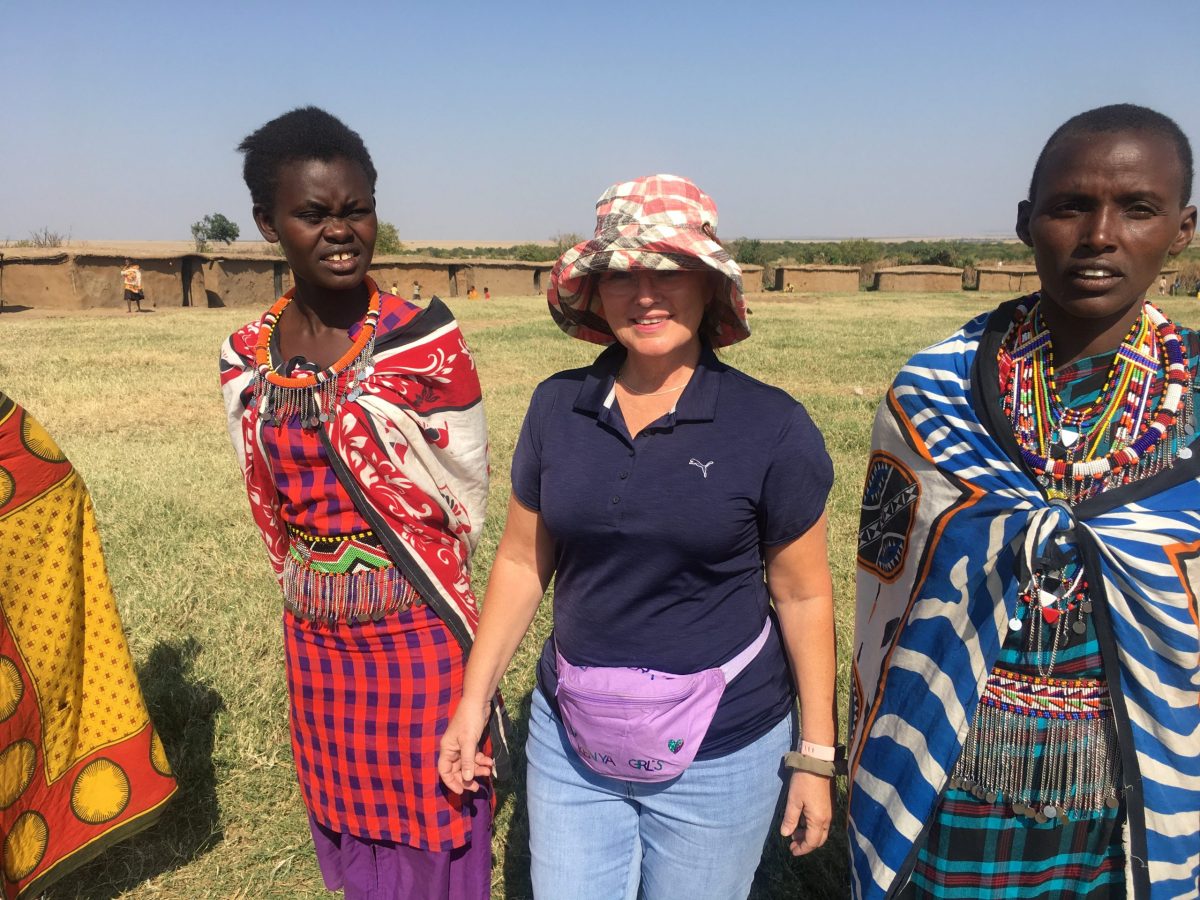
Maasai People Cultural Safaris Kenya
Luxury Africa Tours & Holidays – Deks Safaris and Tours Ltd
- 6 Days Uganda Kenya Tour
- 7 Days Rwanda Uganda Tour
- 8 Days Kenya Uganda Luxury Safari
- 8 Days Kenya Uganda Tour
- 9 Days Kenya Uganda Safari
- 10 Days Kenya Uganda Safari
- 10 Days Uganda Kenya Tanzania Safari
- 10 Days Rwanda Kenya Tanzania Safari
- 11 Days Kenya Uganda Rwanda Safari
- 11 Days Kenya Uganda Safari
- 11 Days Uganda Kenya Zanzibar Safari
- 11 Days Rwanda Kenya Safari
- 12 Day Kenya Uganda Rwanda Safari
- 13 Days Uganda Kenya Tanzania Safari
- 14 Days Across Africa Safari
- 14 Days Rwanda Tanzania Safari
- 15 Days Kenya Rwanda Tour
- 16 Days Kenya Uganda Safari
Deks Safaris & Tours Ltd
Related posts.

Ultimate Wildlife Safari
Top 15 Best Uganda Luxury Safari Camps & Lodges
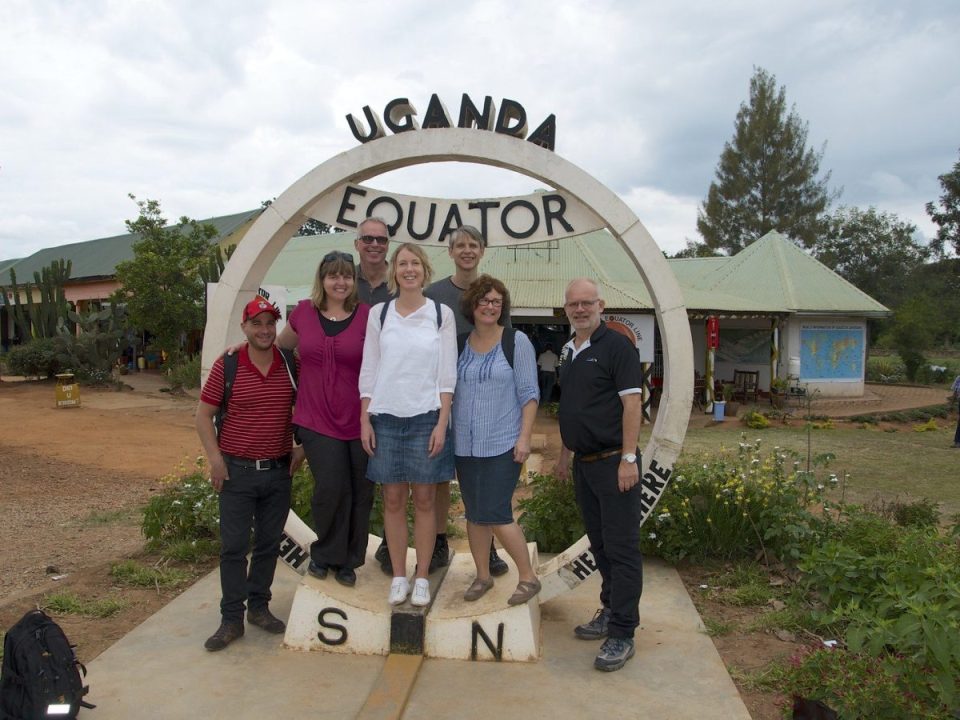
Uganda Equator Crossing
Top 15 Things to Do in Uganda
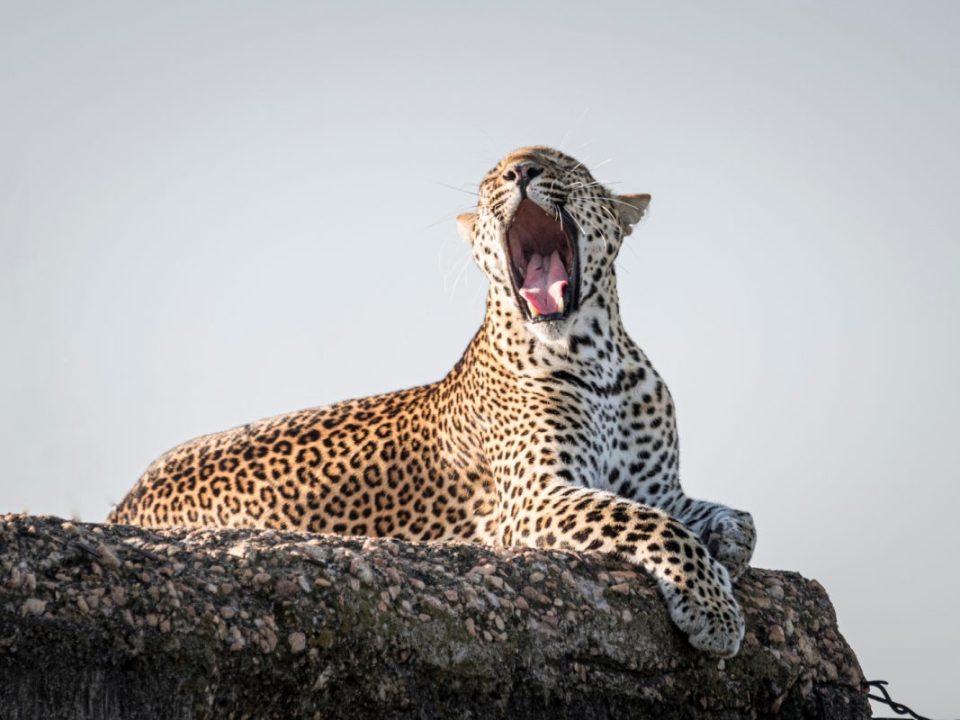
Wildlife Safaris Tour in Africa
- by: Fake Mail
- January 1, 2024 6:21 am
I simply could not go away your web site prior to suggesting that I really enjoyed the standard info a person supply on your guests Is going to be back incessantly to investigate crosscheck new posts
Leave feedback about this Cancel Reply
- Rating 5 4 3 2 1
The Luxury Safari Company
WhatsApp or Call Anytime:
+44 1666 880 111 +44 7539 508 880
Email *please check your junk mail for our emails, or provide a phone number so we can confirm you received them*: [email protected]

Wildebeest Migration Safaris
Wildebeest migration.
The Wildebeest Migration – every year almost two million wildebeest, zebra, topi and antelope migrate from the vast Serengeti Plains in Tanzania , to the lush rolling grasslands of the Masai Mara , in Kenya . The journey is 1,800 miles and tough and arduous, with many animals falling prey to Africa’s lion, leopard and cheetah – not to mention the crocodiles which lie in wait each year for that first wildebeest to cross the Grumeti and Mara Rivers. Seeing the sheer magnitude of animals amongst the wildebeest migration, as well as the drama and action this extraordinary natural spectacle provokes, is nothing short of miraculous.
See our fantastic Specialist Wildebeest Migration Safari – a combination of the Masai Mara and the Serengeti .
Each year, the patterns change, however see below for an idea of where the wildebeest migration will be at certain times of year (please note that many of our camps are mobile, so they are able to follow the migration throughout the year). Please note, not all camps are listed, although every camp in the Masai Mara (Kenya) and the Serengeti (Tanzania) will be in the centre of the wildebeest migration at one point during the year.
December – March: Ndutu, Southern Serengeti, Ngorongoro Crater . Over 80% of the wildebeest are busy giving birth on the lush flat grasslands of Ndutu, attracting a lot of attention from hungry predators, before beginning their journey all over again. From Dec – Mar you are most likely to catch the wildebeest migration at: Serengeti Maswa, Olakira
April – May: The Ndutu Plains can no longer sustain the wildebeest, with their new born calves and the migration begins to sweep North into the Serengeti’s Western Corridor. From Apr – May you are most likely to catch the wildebeest migration at: Olakira , Sabora , Faru Faru June: The wildebeest move further North again, entering the Lamai wedge in the Northern Serengeti. In June you are most likely to catch the wildebeest migration at: Lamai Nomad , North Camp
July – October: Countless herds now swell along the Mara River, in search of the sweet grass on the plains of the Masai Mara , in Kenya – this is where they will spend the next few months, eating every blade of grass in sight, and attempting to dodge lions, leopards and cheetah, after facing the famous Mara River Crocodiles.
From Jul – Oct you are most likely to catch the wildebeest migration at: All of the Masai Mara Camps , and all of the Northern Serengeti Camps , just email us for further advice.
November: The arrival of East Africa’s short rains pull the Wildebeest back into Tanzania , and into the North East of the Serengeti , before making their way back down to the Southern Serengeti and Ndutu plains to give birth.
In November you are most likely to catch the wildebeest migration at any of the central Serengeti camps .
Featured Items

Chimps in Tanzania

Magic in the Bush

Honeymoon Safaris of Note
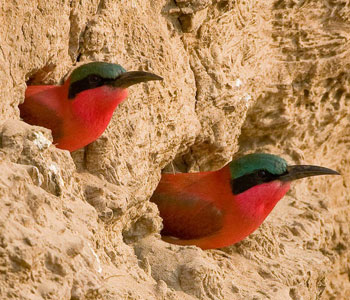
Specialise in your Passion

Why We're The Best
- Kenya & Mauritius
- Culture & Wildlife
- Short & Sweet Kenya
- Migration & Seychelles
- Kenya Safari & Coast
- Kenya & Mozambique
- Mobile Safaris
- Emboo River Camp
- Offbeat Ndoto
- Rekero Camp
- Richard’s River Camp
- Mara Plains Camp
- Encounter Mara
- Angama Mara
- Naboisho Camp
- Saruni Wild
- Mara Expeditions
- Mara Bush Homes
- Mahali Mzuri
- Ol Seki Mara
- Offbeat Mara
- Kichwa Tembo
- Elephant Pepper Camp
- Bateleur Camp
- Saruni Mara
- Cottars Camp
- Ngare Serian
- Private Guides
- Specialist Migration Safari
- Siruai Mobile Camp
- Mugie House
- Sarara Treehouses
- Laikipia Wilderness
- Ol Malo House
- Lewa Wilderness
- Lewa Safari Camp
- Ol Pejeta Bush Camp
- Angama Amboseli
- Tortilis Camp
- Saruni Rhino
- Elephant Watch
- Saruni Samburu
- Elsa’s Kopje
- Shompole Camp & Suite
- Rusinga Island
- Mfangano Island
- Desert Rose
- Loldia House
- Nairobi Tented Camp
- Giraffe Manor
- Tusitiri Dhow
- Sirai Beach
- Msambweni House
- Water Lovers
- Private Beach House
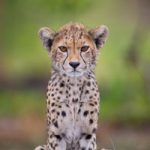
Maps & Camps

See Our Reviews
- Cookie Settings
- Essential Cookies
- 3rd Party Cookies
This website uses cookies so that we can provide you with the best user experience possible. Cookie information is stored in your browser and performs functions such as recognising you when you return to our website and helping our team to understand which sections of the website you find most interesting and useful.
These cookies are strictly necessary to provide you with services available through our website and to use some of its features. These must be enabled at all times, so that we can save your preferences.
If you do not enable essential cookies, we will not be able to save your preferences. This means that every time you visit this website you will need to enable or disable cookies again.
This website uses Google Analytics to collect anonymous information such as the number of visitors to the site, and the most popular pages.
Keeping this cookie enabled helps us to improve our website.
Please enable Essential Cookies first so that we can save your preferences!
- 1 Day Nairobi Trips
- Group Joining Kenya Safaris
- Kenya Private Safari Packages
- Kenya Beach Safaris
- Mount Kenya Climbing
- Kenya Missionary Safari
- Tanzania Safaris
- Mount Kilimanjaro Climbing Packages
- Kenya & Tanzania Safaris Amazing Kenya & Tanzania Safaris
- Contact Us Get in touch with us
Wildebeest Migration
What is the great wildebeest migration.
Rather than having a start or end point, the Great Migration moves rhythmically in a clockwise direction, making herd tracking unpredictable. It is for this reason that our Herdtracker app was created; to help you track the wildebeests’ movements and plan the safari of a lifetime. Choose from our existing safari packages or tailor-make your own journey according to your budget.

Wildebeest Migration Tracker
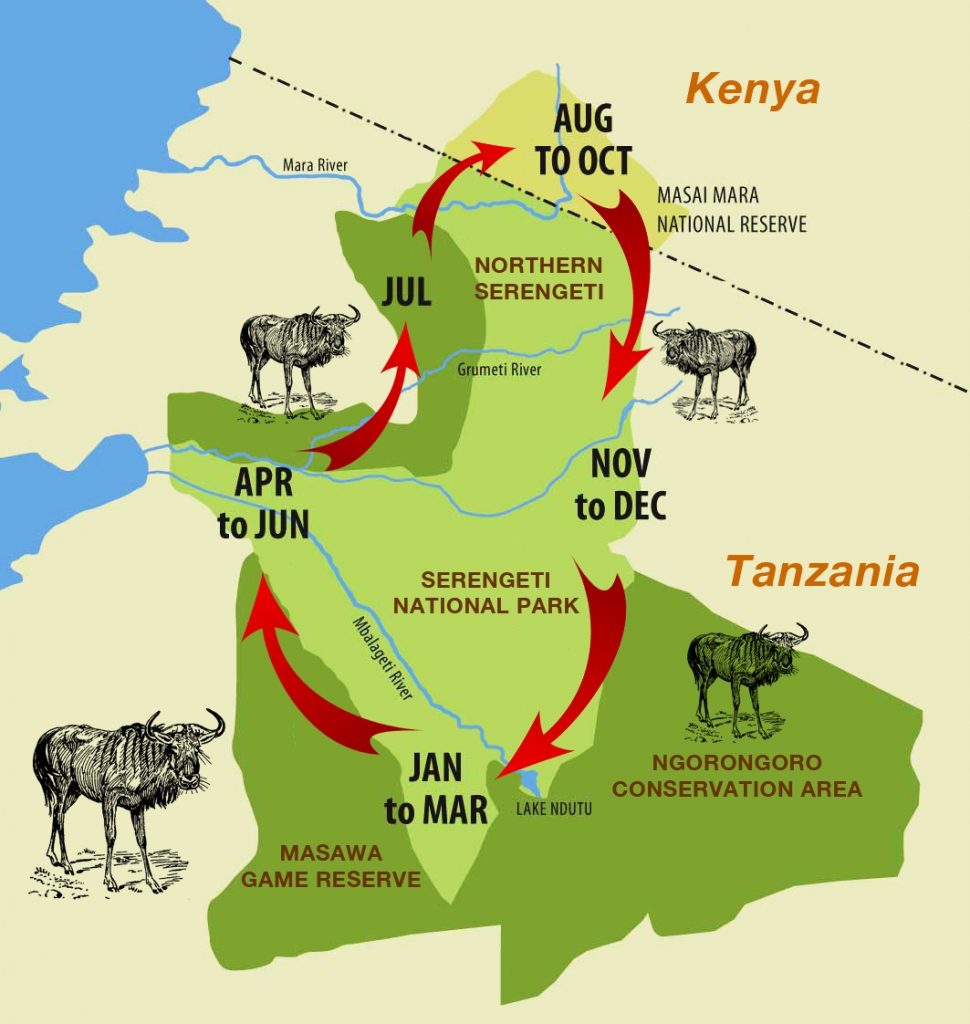
Great Migration Safari Holidays
- The Great Wildebeest Migration is rarely in the Masai Mara Kenya ; the herds only ever venture there as an extension of their grazing lands in the northern point of Tanzania if they need to for fresh pastures.
- You can only find the migration in Kenya within a few months of the year when they head towards the border, and even then, most of the herds are still mulling around the northern parts of the Serengeti anyway…
How best to see wildebeest Migration?
When and where to see wildebeest migration.
- December to June – The wildebeest are in the Serengeti National Reserve in Tanzania.
- July – The migration is on the move from the Serengeti to the Masai Mara National Reserve of Kenya.
- August to October – The migration is in the Masai Mara.
- November – The migration moves from the Mara to the Serengeti
Wildebeest facts: Why does the Great Migration occur & why do the Wildebeest Migrate?
Wildebeest typically inhabit the Serengeti plains of southeastern Africa. For most of their lives, wildebeest graze in the grassy savannas and open woodlands of the plains, which straddle the nations of Tanzania and Kenya.
The wildebeest migrate around the Serengeti, and into the Masai Mara for the sole purpose of following the rainfall. For their calving from December – March they always begin their cycle in the Southern Serengeti area of Ndutu and follow wherever the grass is greener.
Whilst we have a good idea of where the wildebeest should be at any given time of year, it really does depend on where the rain falls.
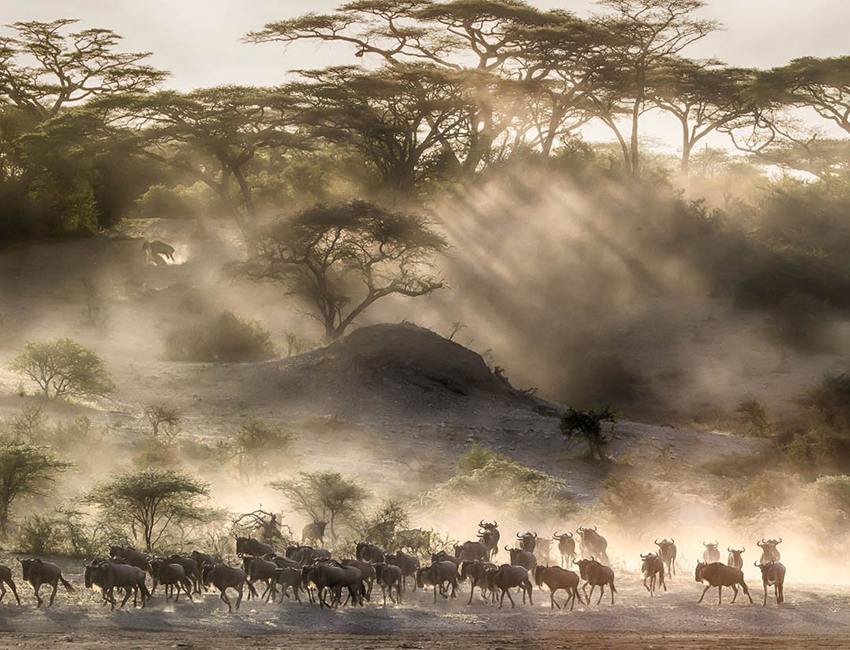
What and why the wildebeest Migration?
250,000 animals perish on the way. Some scientists believe that the wildebeest are motivated by the chemistry of the grass in so much as the herds are attracted to higher levels of phosphorus and nitrogen, which changes in response to the rains.
Beyond Kenya Safaris
- Nairobi Hotels
- Amboseli Safari Camps & Lodges
- Laikipia Safari Hotels
- Masai Mara Hotels
- Samburu Camps & Lodges
- Kenya Beach Resorts & Spas
- Lake Nakuru Hotels
- Lake Naivasha Hotels
- Lake Magadi Hotels
- Tarangire Safari Hotels & Lodges
- Serengeti Hotels
- Places To Visit
- Family Holiday Packages
- Luxury Safari Packages
- Honeymoon Packages
- Migration Safaris
- Safari & Beach Holiday

Masai Mara/Serengeti
the Great Wildebeest Migration
A journey through masai mara and serengeti.
The annual Wildebeest migration, a natural marvel spanning the Serengeti in Tanzania and the Masai Mara in Kenya, is one of Earth’s most remarkable wildlife phenomena. This epic journey is a cycle of life, death, and rebirth, witnessed by hundreds of thousands of tourists each year.
The Migration Cycle
The cycle begins in the Ngorongoro Conservation Area of the southern Serengeti during the calving season, which usually occurs between January and March. This is a time of abundant feasting for predators as over 500,000 calves are born within a short period.
As the rains end in May or early June, the great herds start moving northwest into the more fertile plains of the western Serengeti. Here, dramatic river crossings are seen, featuring crocodile-infested waters that the wildebeest must overcome — a true test of survival.
Peak of the Migration
The peak of the migration occurs between July and September when the wildebeest, along with zebras and gazelles, arrive in the Masai Mara. The sheer number of animals, estimated at over 1.5 million, creates a bustling spectacle.
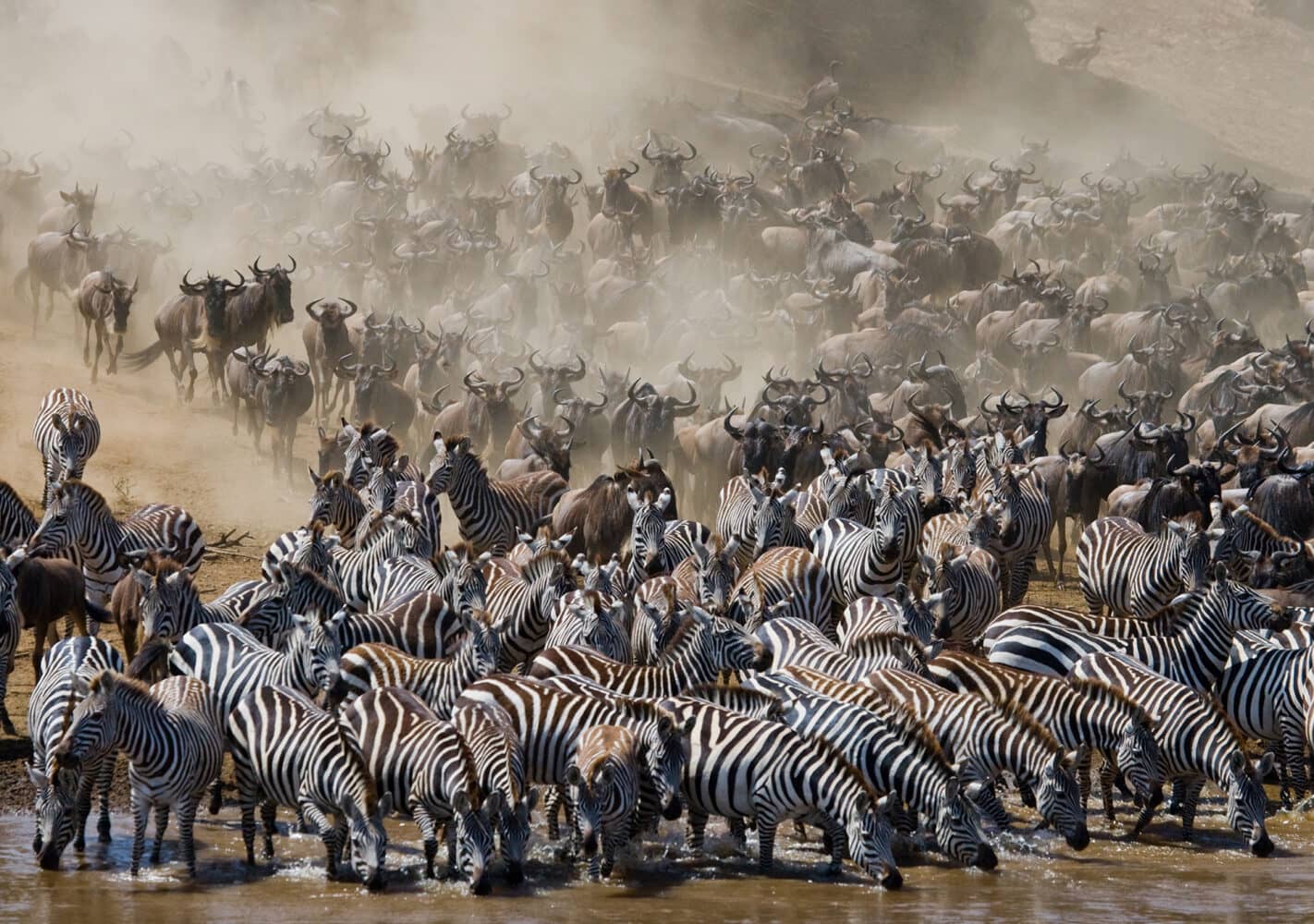
Challenges Along the Way
The migration is not without challenges. Aside from the perilous river crossings, predators such as lions, cheetahs, and hyenas are in constant pursuit of the herds, and only the strongest survive. Moreover, human-wildlife conflict poses a threat to this age-old journey, yet conservation efforts strive to preserve this incredible event.
Witnessing the Migration
For the best experience, visitors can view the migration from hot-air balloons, lodges, or during guided game drives. Timing and location are everything since the migration follows an unpredictable weather pattern.
Conservation Efforts
Conservationists and governments work tooth and nail to protect the roaming grounds of these magnificent creatures. The aim is to ensure that the Wildebeest migration continues for generations to come, maintaining the balance of the Mara-Serengeti ecosystem.
In Conclusion
The annual Wildebeest migration is more than just movement; it is a powerful symbol of life’s tenacity and nature’s intricate balance. Those who witness this extraordinary event carry with them memories of nature’s most authentic and raw moments.
For nature enthusiasts and wildlife photographers, the annual migration offers an unequaled canvas of life in the wild. It is a majestic display that calls out to the heart of every adventurer.
See Masai Mara Hotels & Serengeti Hotels
Quick links, other pages, contact info, make a reservation.
Our Support and Sales team is available 24 /7 to answer your queries
Copyright © 2024. All rights reserved.

+254 797 100 200
WILDEBEEST MIGRATION SAFARIS
Wildebeest migration safaris & tours.
Wildebeest Migration Safaris in Kenya mostly happen in Masai Mara National Reserve . More than 1.5 million wildebeests and zebras migrate from Serengeti National Park in Tanzania to Masai Mara National Reserve in Kenya. Migrating for more than 10 months a year, they visit the different parts of the Masai Mara – Serengeti Ecosystem.�
Wildebeest migrate from Serengeti South called Ndutu Conservation Area, all through to the Seronera, the Serengeti central and spread over to the western side of the park before arriving in Northern Serengeti. Later they enter Masai Mara around June to October as they cross the infested Mara river.�
They cross past the major Mara river in Serengeti National Park crossing in large herds, and croc feastings as they pile up their meals for the future. Witness the wildebeests jumping high river cliffs as they cross these major rivers and tributaries in Masai Mara.�
Wildebeest Safaris From Nairobi
Our safaris to Masai Mara , to witness the wildebeest migration are offered in different categories. Available are our daily Masai Mara Safaris that go for 3 days from Nairobi and enjoy an affordable budget safari. We can as well offer you a customized short Masai Mara safari with the best selection and an easy comfortable itinerary.�
Our All-inclusive safaris are one of the best, including special treats and amenities while on holiday and they supplement your wildebeest migration tours. Our Wildebeest migration tours can be customized to include some of the best national parks in Kenya, like Amboseli National Park and Samburu National Reserve .�
In case you are on a short stay in Nairobi, we offer the best Flying Safaris to Masai Mara and witness the great wildebeest migration. You can take an easy 2-day 1 night safari and stay in one of the best safari camps and lodges and witness the crossings with ease.�

WILDEBEEST RIVER CROSSINGS IN KENYA
Enjoy our Masai Mara Safaris, and Natural Wildebeest Migration tours, with spectacular views of Wildebeest Migration crossing the Mara River with tension, determination, and precision as they move to look for greener pastures, and water. Wildebeest creates a never-ending scene of the crossings making this even a world wonder.�
Spending hours waiting, and patiently taking photos of these beasts, the crossings can take up to 2 hours depending on the size of the herd. We have several crossing points in Masai Mara, including the Sandi river region, the lookout region, and the Serena area. Discover this magical 7th Wonder Of The World with our private safaris to Masai Mara.�
With our daily departure Masai Mara Safaris , you will have a full day to witness this magical phenomenon, but we can as well customize this safari for you to fit your preferences.�
WILDEBEEST MIGRATION TOURS & HOLIDAYS
Get the front row seat and enjoy amazing sightings of the wildebeests as they cross the Mara Rivers and tributaries. The best way is by booking one of our customized safaris and letting us know how well you need it to be, and we will make sure it meets your interest. Or join our daily wildebeest migration safaris.�

Get In Touch with Us
We will be glad to be of help in planning your safari to East Africa, South Africa, Dubai, and Europe.
Phone / Whatsapp
Our Experts are 24/7 avaibale to help you curate and plan your next safari in East Africa or your next Europe or Dubai Holidays. Talk and engage us today for a personalised safari to you.
Thika Road, Nairobi
Total Energies Ruaraka, 1st Floor, Room F4
+254 797 100 200 / +1 (332) 244-6522

New Easter Special Offer
Get discounted offers if you book your Easter Holidays with us before 29th February. Click below to start.
- You are here:
- Kenya Tours
Uganda Family Tours & Travel
3-Day Wildebeest Migration in Masai Mara(Private Safari)

5.0 /5 – 50 Reviews
Discover the true safari experience; open grasslands dotted with wildebeest and antelopes, acacia trees providing shady retreats for leopards and not just the wildlife that's fascinating, during our travels we'll visit the villages of local tribes to learn more about their culture and traditions. This holiday is designed to offer an authentic safari experience - ideal for wildlife enthusiasts, winter sun seekers, bird watchers and travelers looking to see this diverse ecosystem up close.

Tour Features
Luxury tour.
This luxury tour uses tented camps.
Private tour
This tour will be organized exclusively for you and won't be shared with others.
Can start any day
If availability permits, this tour can start on any day.
Can be customized
You can request changes to this tour.
Suitable for solo travelers
Solo travelers can book this private tour.
Minimum age of 2 years
The minimum age for this tour is 2 years.
Activities & Transportation
Accommodation & meals.
- Additional accommodation before and at the end of the tour can be arranged for an extra cost
- Day Accommodation Meals

- 3 End of tour (No accommodation) – Breakfast & Lunch Included Breakfast & Lunch Included
Best price guarantee
Your request will be sent directly to the operator
If preferred, you can contact the operator directly
- This tour is offered by Uganda Family Tours & Travel , not SafariBookings.
- This operator reserves the right to change rates advertised on SafariBookings.
- If you request changes to this tour, the advertised rates will likely change.
- The exact order, contents and rates of this tour are subject to availability.
- If an accommodation is fully booked, the operator will suggest a comparable alternative.
Get a Free Quote
Comparable tours.

4-Day Mara & Nakuru Private Jeep Safari-Budget Option
$958 to $1,288 pp (USD)

3-Day Masai Mara Midrange Private Jeep Safari
$880 to $1,375 pp (USD)

3-Day Masai Mara Private Budget Jeep Safari
$660 to $935 pp (USD)


Wildebeest Migration
The Wildebeest Migration of the Serengeti is not only great – but simply phenomenal, so much so that it can be seen from space! Every year over a million of these ungulates move across the plains of the Serengeti from Tanzania’s Serengeti National Park to the Masai Mara National Reserve in Kenya in a breathtaking journey of sheer determination. It is an expedition filled with dramatic tension with up to 8,000 births a day over a distance of 2,896 km covered, and a death rate of around 250, 000 animals. The migration patterns are also affected by the rainfall, the animals flowing clockwise through the Serengeti in search of lush green grass.

JANUARY The herds congregate in Tanzania, in the Serengeti. They gradually move south towards the Ngorongoro Conservation area.
FEBRUARY It’s calving season and the herd remains in the area to take advantage of the healthy grazing conditions. During this time, there can be up to 8,000 births in a single day. Predators wait patiently on the outskirts for the vulnerable young prey. Hunting is prolific throughout the migration, lions and other cats following in the footsteps of abundant wildlife.
MARCH Herds are located in the Ndutu region of the Ngorongoro Conservation area, lingering for nutrient rich grasses.
APRIL Rainy season begins and the wildebeest embark on their northward journey across the southern Serengeti plains.
MAY The herds are on the move! Massive columns up to 40km long head up into the central and western regions of the Serengeti.
JUNE Herds can be found in the central and western Serengeti, their last respite before the dangerous and daring river crossings. This is also mating season, a character-filled and noisy time for wildebeest.
JULY Time for the death defying river crossing! The herd risks life and limb to cross the Grumeti River in the western Serengeti. The herd uses sheer force and determination to cross the river where crocodiles are lying in wait, ready to snap up any unfortunate wildebeests.

AUGUST River crossings happen from August through to October. The survivors feast in the northern Serengeti and start to head back into Kenya’s Masai Mara.
SEPTEMBER By now the herds have broken up into smaller groups and spread out across the plains. Around half of them are in the Masai Mara and the other half are in the northern Serengeti. For those in the Masai Mara, it’s time for another dangerous river crossing of the Mara River itself.
OCTOBER Most of the wildebeest are in the Masai Mara now, remaining in this area until the rains begin once again.
NOVEMBER It’s time to move on again as by now the short rains have begun and there’s not much grass left. The herds return to the rejuvenated Serengeti.
DECEMBER The wildebeest are back in the north-eastern and southern Serengeti where the grasses have had a chance to replenish.
The circle of life begins once again. Embark on an extraordinary adventure with JENMAN African Safaris on our wildebeest migration tours , immersing yourself in the awe-inspiring grandeur of the world’s greatest migration. Join the ranks of lucky individuals who have witnessed this incredible event unfold in the magnificent Serengeti. Our meticulously crafted wildebeest migration tours offer you a front-row seat to nature’s most captivating spectacle. Prepare to be mesmerized as millions of wildebeest, zebras, and other fascinating wildlife traverse vast landscapes in search of greener pastures.
Tailormade Packages to Tanzania
Let us transform your dreams into a reality as we design the perfect Tanzanian safari for you. Discover the wonders of Tanzania with our expertly crafted custom travel itineraries. At JENMAN, we take pride in curating unforgettable experiences tailored to your preferences and budget. Our dedicated team of travel consultants specializes in creating personalized packages that cater to your unique needs, ensuring you have the adventure of a lifetime.
Email Us : [email protected]
Talk To Us: +27 21 683 7826
Want to include this attraction in your itinerary?
Talk to our travel consultants at [email protected] to build your own travel itinerary ar simply add this attraction to your pre-planned tour. We can organise transport to and from your accommodation, or directly from the airport.

East Africa Migration Discoverer (R) • 15 Days
East africa migration discoverer • 15 days.

Kenya Safari Adventure • 10 Days
Build your trip.
With the power to specify your travel dates, the number of travelers in your party, and your preferred destinations, we’ve made it incredibly convenient for our travel consultants to curate the perfect expedition for you.
Get in touch with our experienced consultants, dedicated to curating your ideal African safari. Let us guide you towards the perfect destination, ensuring your trip is nothing short of extraordinary.
- Kruger National Park
- Hwange National Park
- Mana Pools National Park
- Maasai Mara
- Okavango Delta
- Victoria Falls
- Serengeti National Park
- Best Walking Safaris in Africa
- African Safaris for Seniors
- Wildebeest Migration Tour
- Group Tours to Zimbabwe
- Group Tours to South Africa
- Group Tours to Botswana
- Safari Insights

Stay Connected

- Monday, April 29, 2024

Pamoja Tours and Travel
Uganda Safari | Uganda Tours | Gorilla Tours in Uganda | Uganda Tour Agents | Uganda Luxury Safaris & Holidays, gorilla tracking, gorilla trekking, Uganda vacations, Uganda trips, gorilla trip to Uganda, Gorilla tours, gorilla safaris, Rwanda gorilla tours, Rwanda gorilla tracking, Uganda tours, Uganda gorilla tours, Uganda safaris, gorilla treks, Uganda gorilla tours, gorilla tours Rwanda, Congo tours, lowland gorilla tracking, Rwanda Uganda tours, Congo safaris, Rwanda vacations, Rwanda holidays, Uganda vacations, Uganda trips, Congo trips, Rwanda trips, gorilla trek Rwanda, Congo Nile trail, Rwanda gorilla safari, gorilla trip to Rwanda, gorilla trip to Uganda, visit gorillas, safaris in Rwanda, safaris to Rwanda , tours in Rwanda, tours to Rwanda, safaris in Congo, tours to Congo, tours in Congo, safaris to Congo, guided gorilla trekking, gorilla trekking safaris, Uganda gorilla tour, gorilla trek, gorilla safari, gorilla trip, chimp tracking, chimp treks, to visit gorillas, trip to volcanoes, mountain gorillas , mountain gorilla safari, congo gorilla tours, congo gorilla safaris, Masai mara, Seerenget, Kenya Safari, Tanzania Safari, Ngorongoro crater, Murchison falls

5-day wildebeest migration safari in Kenya
Tour overview:.
Embark on an incredible 5-day wildebeest migration safari in Kenya, offering you an extended opportunity to witness one of nature’s most awe-inspiring spectacles. This midrange safari takes you deep into the heart of Kenya’s Maasai Mara National Reserve, where you’ll experience the epic Great Wildebeest Migration up close and personal.

Accommodation Options (Midrange):
Throughout your 5-day wildebeest migration safari, you will be comfortably accommodated in midrange lodges and tented camps situated within or near the Maasai Mara National Reserve. Options may include accommodations like the Ashnil Mara Camp or the Mara Sopa Lodge, known for their convenient access to prime wildlife viewing areas and comfortable amenities.
Detailed Itinerary:
Day 1: arrival in maasai mara and afternoon game drive.
Your safari adventure commences with your arrival at an airstrip within or near the Maasai Mara National Reserve. Upon landing, our experienced guide will extend a warm welcome and transfer you to your chosen accommodation. After settling in and enjoying a sumptuous lunch, you’ll embark on your first game drive in the Maasai Mara, celebrated for its striking landscapes and abundant wildlife. Keep your eyes peeled for wildebeests, zebras, and predators such as lions and cheetahs. As the sun sets, return to your lodge or camp for a delectable dinner and a restful night’s sleep.
Day 2: Full Day Wildebeest Migration Experience
Today is dedicated entirely to immersing yourself in the captivating wildebeest migration. After an early breakfast, journey deep into the Maasai Mara to witness the breathtaking river crossings as wildebeests and zebras confront crocodile-infested waters on their relentless journey. Be awed by the sheer power of this natural spectacle, capturing unforgettable moments with your camera.
Enjoy a packed lunch in the reserve to maximize your time amidst the migrating herds. Continue to explore the reserve in the afternoon, with opportunities to witness predators stalking their prey within the migration. As the day concludes, return to your lodge or camp for dinner and relaxation.
Day 3: Game Drives and Cultural Interaction
Begin your day with an early morning game drive in the Maasai Mara , capturing the wildebeest migration in the gentle morning light. Observe the interactions among the animals and savor the unique atmosphere. Return to your accommodation for breakfast and a brief rest.
In the afternoon, enjoy a cultural interaction with the Maasai people, visiting a Maasai village to learn about their traditions, dances, and way of life. Gain insight into their daily activities and immerse yourself in their rich heritage. Later, return to your lodge or camp for dinner and relaxation.
Day 4: Morning Game Drive and Exploration
Rise early for a final morning game drive in the Maasai Mara, taking advantage of the soft morning light to observe the wildebeest migration. Witness the last moments of this magnificent spectacle and bid farewell to the Mara’s abundant wildlife.
After the game drive, return to your accommodation for breakfast and to prepare for your next adventure. In the afternoon, embark on another game drive, exploring different areas of the reserve and seeking out unique wildlife encounters. As the sun sets, return to your lodge or camp for dinner and a peaceful night’s sleep.
Day 5: Morning Game Drive and Departure
Begin your final day with a sunrise game drive in the Maasai Mara, capturing the beauty of the savannah awakening to a new day. Search for any wildlife you may have missed during your safari and relish the serene atmosphere.
After the game drive, return to your accommodation for breakfast and to pack your belongings. Our guide will then transfer you to the airstrip for your departure flight, concluding your 5-day wildebeest migration safari with a wealth of unforgettable memories.
Inclusions:
– Airstrip transfers
– Accommodation as specified
– Game drives with experienced guides
– Cultural interactions with the Maasai people
– All park fees
– Meals as per itinerary
– Bottled water during game drives
– Transportation within the reserve
Exclusions:
– International airfare
– Visa fees (if applicable)
– Travel insurance
– Personal expenses
– Tips and gratuities
– Optional activities not mentioned in the itinerary
How to Get There:
To begin your 5-day wildebeest migration safari, book a domestic flight from Nairobi’s Jomo Kenyatta International Airport (NBO) to one of the Maasai Mara’s airstrips, such as Keekorok or Olkiombo. Various domestic airlines operate daily flights to the Maasai Mara, providing convenient access to this extraordinary wildlife spectacle. Upon arrival at the airstrip, our guide will be there to welcome you and commence your thrilling safari experience amidst the Great Wildebeest Migration.
Your Nationality
Number of Days
Number of People
Accommodation —Please choose an option— Budget Mid-range Luxury
Phone Number
Interests Gorilla Trekking Wildlife Viewing Bird Watching Chimpanzee Tracking Primate Tour Cultural Tour Whitewater Rafting Mountaineering Horseback Riding Boat Cruise Honeymoon Holiday
Your message
Related Safaris
Safety and security measures when planning a trip to africa, 12 top safari activities not to miss out on your luxury safari in east africa, small-group luxury safaris in east africa, a luxurious honeymoon safari in the heart of uganda | crafting the perfect honeymoon safari.
WhatsApp us

✓ Great customer reviews
✓ world class safari guides, ✓ great service, great pricing, wildebeest migration.
The Wildebeest or Great Migration is the largest mammal migration in the world. It is a true spectacle to see 1,5 million wildebeests, 400,000 zebras, 12,000 elands and 300,000 Grant’s and Thomson’s gazelles thunder across the endless plains of the Masai Mara National Reserve. Especially since the wildebeests and zebras continuously make their distinctive sounds, making the migration recognisable from great distances.
As such, the epic river crossing at the Mara River is the highlight of the Wildebeest Migration. For some travellers it’s the sole reason to visit Kenya. With approximately 3000 crocodiles in the river, the crossing makes for a real feat for the herds and many of them die. Together with a multitude of leopards and cheetahs preying on the herds along the way, the migrations causes 250,000 wildebeests and zebras to die every year.
All year migration
The Wildebeest Migration is a natural phenomenon that doesn’t recognise borders. Starting in January the herds are in the southern part of the Serengeti National Park in Tanzania. Following the rains (and grassy plains) north, they pass the border with Kenya end of July. Here they subsequently migrate in thousands over the plains of the Masai Mara. Eventually they move back south, over the border back into Serengeti – a total distance of no less than 800 kilometers.
When to go and what to expect
July From late July into August the herds start to arrive in Kenya. They are in search of food and water and need to cross the Mara River to reach the place where the grass is green. It makes for the best time to watch the river crossing.
August The herds start reaching the Mara plains, but are awaited by hungry and eager packs of big cats.
September Life is good, as most animals have reached Mara and most big cats are fed. This is the time for the herd to relax. It’s also a beautiful time to be roaming the Mara plains.
October The rains starts to fall in the Masai Mara Game Reserve, and come November the Wildebeest Migration heads back to Serengeti.
Would you like to witness the Wildebeest Migration? Check our Kenya Safaris or contact us for a personal advice.
Request tailor-made travel proposal
Give us all your personal wishes and we will take care of the rest
Ask your question here
Sign up for our newsletter, top destinations.
- Masai Mara National Reserve
- Diani Beach
- Amboseli National Park
- Tsavo West National Park
- Tsavo East National Park
- Lake Nakuru
- Lake Naivasha
Travel information
- Kenya Travel Advice
- Kenya’s climate
- Things to do in Kenya
- When to visit Kenya?
- Flying Doctors Services
- Responsible Travel
- About Africa Safari Trips
- Privacy policy
- Terms and conditions
Tripadvisor
Google reviews, let's get planning your private safari.
- Boni National Reserve
- Kakamega Forest Reserve
- Nyungwe Forest National Park
- Volcanoes National Park
- National Parks
- Serengeti National Park
- Tarangire National Park
- Udzungwa National Park
- Game Reserves
- Bwindi Impenetrable National Park
- Kibale Forest National Park
- Murchison Falls National Park
- Queen Elizabeth National Park
- Things to Do
- Sanctuaries
- African Safaris
- Safari Mate
- Travel Advice
- Travel Tips
- Experiences
Going on a Wildebeest Migration in Kenya
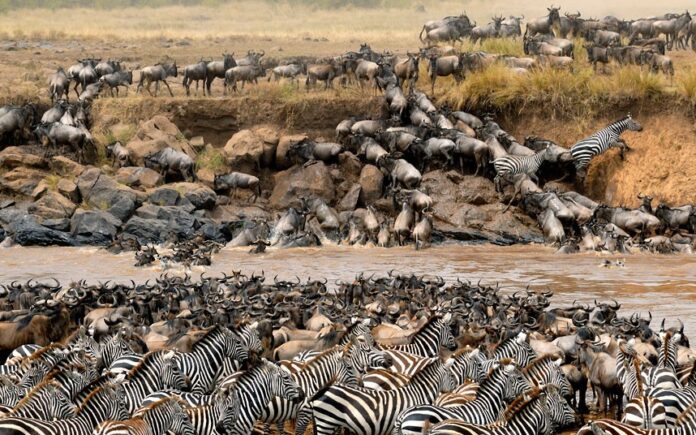
The Great Migration as it is known is the movement of a million plus wildebeest from Serengeti in Tanzania northwards into the adjoining Masai Mara Reserve in Kenya. It is one of the world’s most spectacular and thrilling displays of wildlife behaviour.
The migration takes place every year with the animals primal instincts guiding them towards greener pastures following the climatic rain fall patterns over the Serengeti-Maasai Mara eco system. For the 2024 and 2025 seasons we recommend planning your travel for mid-July as this is when the migration typically starts proper with the larger herds of wildebeest starting the move into Masai Mara. The migration takes place till end of August, before declining into mid-September.
Although numbers vary every year, past migrations have seen upto 1.5 million wildebeest, close to a million Zebra and large numbers of others animals undertake the long trek that lasts many weeks. Their journey is especially frought with danger as they cross the crocodile infested Mara and Talek rivers along the way, during which many cannot escape the giant Nile crocodiles lying in wait for their prey.
A Guide to the Wildebeest Migration
Travelers planning the Masai Mara Migration from Kenya often have many questions related to the migration and we are listing the most common below for the sake of brevity.
What time of the Year is the Wildebeest Migration? Though the migration into Masai Mara typically starts in July and ends late September, the exact dates around this period are not predictable until the first large wildebeest herds actually gather at the northern edge of Serengeti as they near the Mara. These initial herds are sometimes known to gather at a spot for days on end without crossing over to the Mara, so when exactly the final leg of the movement starts is difficult to predict.
So what is the best time to visit Masai Mara to see the Migration? Based on decades of experience, we would choose mid-July to late August as the best time to see the migration, keeping in mind it is a gradual event that takes places over several weeks at different locations along the Serengeti Masai Mara border. If we were to narrow it down further to what month is the best to see the migration we would probably pick August.
Where do the wildebeest migrate to and from?
The movement of the wildebeest is from Serengeti into Masai Mara and is dictated by factos such as the climate, pasture and mating and calving seasons. Keep in mind the wildebeest are migrating through the year in a generally clockwise direction covering vast areas reaching into Southern, Central and Western Serengeti before the year long trek brings them to Masai Mara around July to August. Their journey back to Serengeti happens around late October though this is less spectacular and more like a slow dispersal.
How do you see the Wildebeest Migration?
Though most travelers go on guided safaris, it is also possible to plan a self guided safari in Kenya and experience a wildebeest migration. You can see the migration during a safari game drive in the Masai Mara Game reserve which is conducted in specialized vehicles driver by experienced Driver-Guides. As there are several core points where the wildebeest cross the rivers, it may be necessary to access and station oneself at these points during a day-long outing in the reserve as some of the lodges and camps can be up to an hour’s drive from the ideal vantage points.
Most tourists who come specially to see the migration consider seeing the river crossings a highlight of their tour and therefore want to spend enough time at these crossing points, which by the way tend to vary slightly every year while staying within a generally similar sub locality of the reserve.
Month by Month Wildebeest Migration
Many people think that the Great Migration only happens once in a year, but the migration is in fact an all year round phenomenon event – offering different unique and exciting wildlife experience at various times of the year. The River crossing is one of the most requested event of the migration and usually coincide with the peak safari season, therefore the assumption that this is the only time of the year that the wildebeest are on the move or can be seen. This crossing usually occurs at Mara River around late July to August with parts of September and again on their return south, around the last two weeks of October through early November. Hence, the best times to track and see the annual wildebeest migration in Masai Mara. Below is a general breakdown of more or less where the herds are during the year, bearing in mind it’s difficult to predict the herds movement as it’s prompted by rain, which can be early, late or ‘on time’.
December to April
Depending on the rains, the herds can be seen south of Serengeti National Park between Ndutu plains and Ngorongoro plains. Hence, the best place to be during these four months is the far south of Serengeti. Around February, it is the calving season and there are high chances of witnessing a wildebeest birth. The herds move swiftly, in search of favorable grasslands to provide sustenance for the arrival of their young. The predator interaction is also most likely, as the lions and leopards are moving to this region to prey on the young and vulnerable calves. End of March/early April the herds move slowly and predictably to begin their northward journey, and many have left already and are in the central and even western Serengeti.
May to June
During this time of the year the migratory herds all seem to be moving north, in search of fresh grazing and water. The migration is usually in huge columns of up to 40 kilometres / 25 miles in length can be sometimes be seen as the wildebeest funnel up into the central and western Serengeti, often containing hundreds of thousands of animals – joined by many zebra, and a scattering of Thomson’s and Grant’s gazelles. June marks the end of rainy season, traditionally this is the Grumeti River crossing period, but this is mainly dependent on water level of the Grumeti River ( here you may spot Nile Crocodiles). This crossing is not quite as spectacular as the crossings of the Mara River.
July to September
This is when the big event occurs, the start of major Mara River crossing. The herds have reached the western Serengeti and Grumeti Reserves and are peering closely at the brown waters of the rivers they have to cross. In August, the survivors herd continues moving northwards, into the northern Serengeti and begin crossing into Kenya’s Masai Mara National Reserve. The herd breaks into smaller groups- almost half of the animals remains in the northern Serengeti, the rest of the wildebeest will have crossed the Mara River, and the majority of the herds will be in the Greater Masai Mara area, eating the lush green grass resources before venturing north towards the private conservancies (Mara North, Olare Orok).This is usually the most preferred moments of the migration, watching the frantic herds of the wildebeests crossing the Mara River.
October to November
The wildebeest herds are migrating again with more accord: all are heading south, through western Loliondo and the Serengeti National Park’s Lobo area, returning to the green shoots. The herds can now be seen in Kogatende and Lamai (Northern Serengeti). In a ‘normal year’ the short rains have begun in November. The herds are now in the Serengeti, stationed in the Lobo, Mbuze Mawe and Seronera Valley areas where water is abundant. Fresh grazing sees the wildebeest clustered in the north-eastern Serengeti (around Lobo in particular) as well as the southern Serengeti. Calving begins again, the predators move in again, and the cycle of life begins all over again.
RELATED ARTICLES MORE FROM AUTHOR
Experience murchison falls national park of uganda, amazing rhino adventure in the mundulea park, wildlife delights from amboseli national park, editor picks, the benefits of self-drive car hire in kenya, rental car luggage capacity – hire a car in uganda that..., popular posts, sebastian: the fun-loving and friendly chimpanzee dies, the safari rally: east africa’s most adventurous sport event, uganda’s boy king, popular category.
- Safari Mate 67
- Experiences 36
- Travel Tips 34
- Destinations 21
- Car Rental 14
- Privacy & Policy

IMAGES
COMMENTS
Tanzania. Tanzania, another one of the stunning East African safari destinations, is a gem on Kenya's southern border and offers endless adventures for travellers. Witness the annual Great Migration of thousands of wildebeest and zebra across the sweeping savannah plains in the Serengeti, one of the world's largest and most diverse wildlife reserves.
The annual wildebeest migration in Masai Mara is a spectacular event, being the largest movement of animals on the planet, with upto 1.5 million wildebeest, zebras and other wildlife moving north from Serengeti to Maasai Mara game reserve ... Travelers planning a safari to Kenya often have many questions related to the migration and we are ...
Expert guide and facts on the best time of the year in 2024-2025 to track and see the annual Great Wildebeest Masai Mara Migration in south-west Kenya - East Africa. View AfricanMecca safari trip prices and honeymoon tour, booking family holidays, solo travel packages, accommodation reviews, videos, photos & maps.
The Great Wildebeest Migration in Africa - also known as the Gnu Migration, Serengeti Migration and Masai Mara Migration - is one of the last mass terrestrial wildlife movements left on the planet. It's the chief reason why so many travellers venture to Kenya and Tanzania for a Migration safari, especially around mid-year.
The Great Wildebeest Migration Kenya (Masai Mara) Best Time, Safaris, Best Places to stay, Best Wildebeest Migration Safari Packages. The Wildebeest Migration Kenya is one of nature's greatest paradoxes: timing is absolutely vital, but there is no way to predict the timing of the animals' movements.
The Great Migration is the largest herd movement of animals on the planet. In fact, with up to 1,000 animals per km², the great columns of wildebeest can be seen from space. The numbers are astonishing: over 1.2 million wildebeest and 300,000 zebra along with topi and other gazelle move in a constant cycle through the Serengeti-Mara ecosystem ...
The wildebeest migration in Kenya takes place at the famous Masai Mara National Reserve. Larger herds of wildebeests start arriving at Masai Mara in mid-July until the end of August and then start declining in September. There are specific and common points where experienced safari drivers will guide you through.
The Great Wildebeest Migration is astonishing. Each year, more than 1.5 million wildebeest trek from the Serengeti to the Masai Mara and back again in search of fresh grazing. Their crossing of the Mara River is the climax of this odyssey, a spectacle filled with drama, death and endeavour and one of Kenya's best safari experiences.
The Great Migration is the largest overland migration in the world, with wildlife travelling a total of 800 km or more during each cycle. The magnificence of the event lies in its magnitude. Between 1.5 to 2 million wildebeest, zebras and other species plod or canter across Tanzania's Serengeti and Kenya's Maasai Mara in search of good grazing.
Browse All Tours. [email protected]. Go2Africa House, 12A Portswood Road. V&A Waterfront, Cape Town 8001, South Africa. Exciting lodge openings, new trip ideas, and exclusive offers…. The Great Wildebeest Migration delivers non-stop action with predators, dramatic river crossings and mobile camps following the herds every step of the way.
Every year, about two million wildebeest and 20,000 plains game travel from Tanzania's Serengeti to Kenya's Masai Mara in search of abundant grazing pastures and life-giving water. The seasons dictate this deadly Great Wildebeest Migration voyage, and when the rains come, the wildebeest follow.
Tour Overview: Embark on an unforgettable 3-day wildebeest migration safari in Kenya, a once-in-a-lifetime opportunity to witness one of the most remarkable natural spectacles on Earth. This midrange safari takes you to the heart of the action in Kenya's Maasai Mara National Reserve, where you'll witness the Great Wildebeest Migration, a ...
The Great Wildebeest Migration in Kenya typically takes place from July to October. During this period, the herds move northward from the Serengeti into the Maasai Mara. The key crossing point into Kenya is the Mara River, where herds brave crocodile-infested waters during dramatic river crossings. Once in Kenya, the animals disperse throughout ...
Check out weekly herd tracking updates in 2023, 2024 & 2025 on the Great Wildebeest Migration in Masai Mara, Kenya - News feed via Facebook, Twitter, YouTube, Instagram and more. View safari trip rates and honeymoon tour, booking family holidays, solo travel packages, accommodation reviews, videos, photos & maps.
The Wildebeest Migration - every year almost two million wildebeest, zebra, topi and antelope migrate from the vast Serengeti Plains in Tanzania, to the lush rolling grasslands of the Masai Mara, in Kenya.The journey is 1,800 miles and tough and arduous, with many animals falling prey to Africa's lion, leopard and cheetah - not to mention the crocodiles which lie in wait each year for ...
Each year, almost two million wildebeest and 20 000 plains game migrate from Tanzania's Serengeti to the south of Kenya's Masai Mara in search of lush grazing grounds and life-giving water. This treacherous migration is dictated by the seasons and where the rains are, the wildebeest are not far behind. This epic journey from north to south ...
A Journey Through Masai Mara And Serengeti. The annual Wildebeest migration, a natural marvel spanning the Serengeti in Tanzania and the Masai Mara in Kenya, is one of Earth's most remarkable wildlife phenomena. This epic journey is a cycle of life, death, and rebirth, witnessed by hundreds of thousands of tourists each year.
The best way is by booking one of our customized safaris and letting us know how well you need it to be, and we will make sure it meets your interest. Or join our daily wildebeest migration safaris. . 6. 9 DAYS EXTREME WILD ADVENTURE UGANDA DISCOVERY- 2024. $3535.
Kenya Safari: Discover the true safari experience; open grasslands dotted with wildebeest and antelopes, acacia trees providing shady retreats for leopards and not. ... 3-Day Wildebeest Migration in Masai Mara(Private Safari) Offered By: Uganda Family Tours & Travel. 5.0/5 (49 Reviews)
The Wildebeest Migration of the Serengeti is not only great - but simply phenomenal, so much so that it can be seen from space! Every year over a million of these ungulates move across the plains of the Serengeti from Tanzania's Serengeti National Park to the Masai Mara National Reserve in Kenya in a breathtaking journey of sheer ...
Embark on an incredible 5-day wildebeest migration safari in Kenya, offering you an extended opportunity to witness one of nature's most awe-inspiring spectacles. This midrange safari takes you deep into the heart of Kenya's Maasai Mara National Reserve, where you'll experience the epic Great Wildebeest Migration up close and personal.
The Wildebeest or Great Migration is the largest mammal migration in the world. It is a true spectacle to see 1,5 million wildebeests, 400,000 zebras, 12,000 elands and 300,000 Grant's and Thomson's gazelles thunder across the endless plains of the Masai Mara National Reserve. Especially since the wildebeests and zebras continuously make their distinctive sounds, making the migration ...
Though most travelers go on guided safaris, it is also possible to plan a self guided safari in Kenya and experience a wildebeest migration. You can see the migration during a safari game drive in the Masai Mara Game reserve which is conducted in specialized vehicles driver by experienced Driver-Guides. As there are several core points where ...
31 likes, 0 comments - shadowsofafrica on April 25, 2024: "- Shadows bucket list - WILDEBEEST MIGRATION SAFARI - WESTERN CORRIDOR - 6 DAYS Ready to set out? Your ...